North Korea Photos - April 2012
As the least open, least visited and least understood country in the world, North Korea is bound to generate many misconceptions, however it seems the most pervasive one is that you can’t actually go there. In reality nothing could be further from the truth. All you do is fill out a visa application, send them some money, and providing you’re not a journalist or a Christian missionary, you’re in. Actual numbers are impossible to gauge but one of our guides from the fantastic Young Pioneer Tours who we went with, estimated that non-Chinese visitor numbers to North Korea at around 2000 per annum. For comparison the single town of Banff in Canada receives over 6 million tourists per year, so we’re talking very, very low numbers here. The timing of our visit coincided with the nation-wide celebrations for the 100th anniversary of the birth of Kim Il-sung, the founding leader of North Korea and, even though he died in 1994, still its “eternal president”. Finally, after years in the planning, my fellow traveller, Ash and myself would enter the Hermit Kingdom.
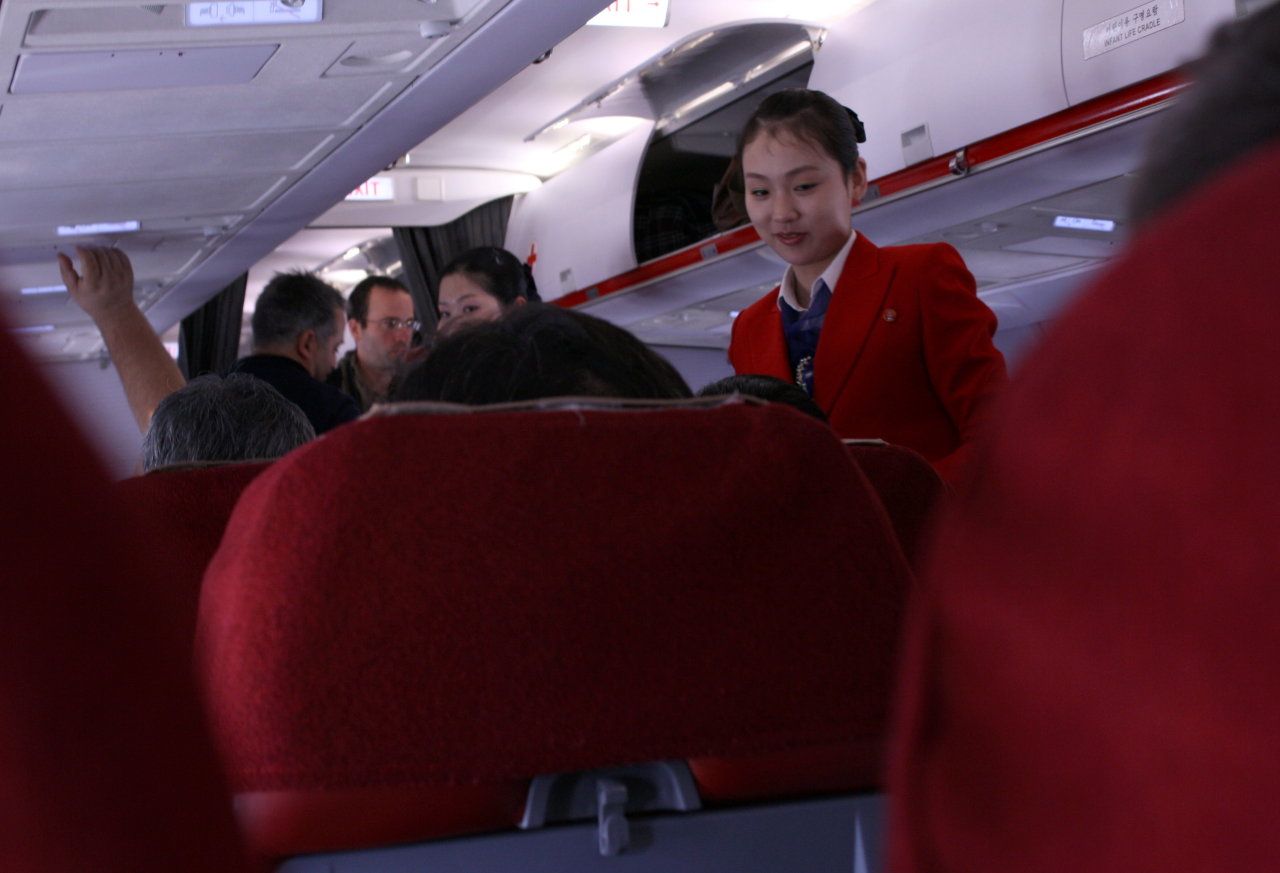
After a chaotic check-in process (it appeared the Koreans were bypassing the Beijing Capital Airport’s computer system and booking everyone on to their flights manually) boarded Air Koryo, the national airline of North Korea, and what was my first Russian-built airliner: a Tupolev TU-204. Female flight attendants for Air Koryo are reputed to be some of the most beautiful women in North Korea, all I can say is this one caught me taking pictures and told me off, the first example of many arbitrary rules we would run into in the days ahead.
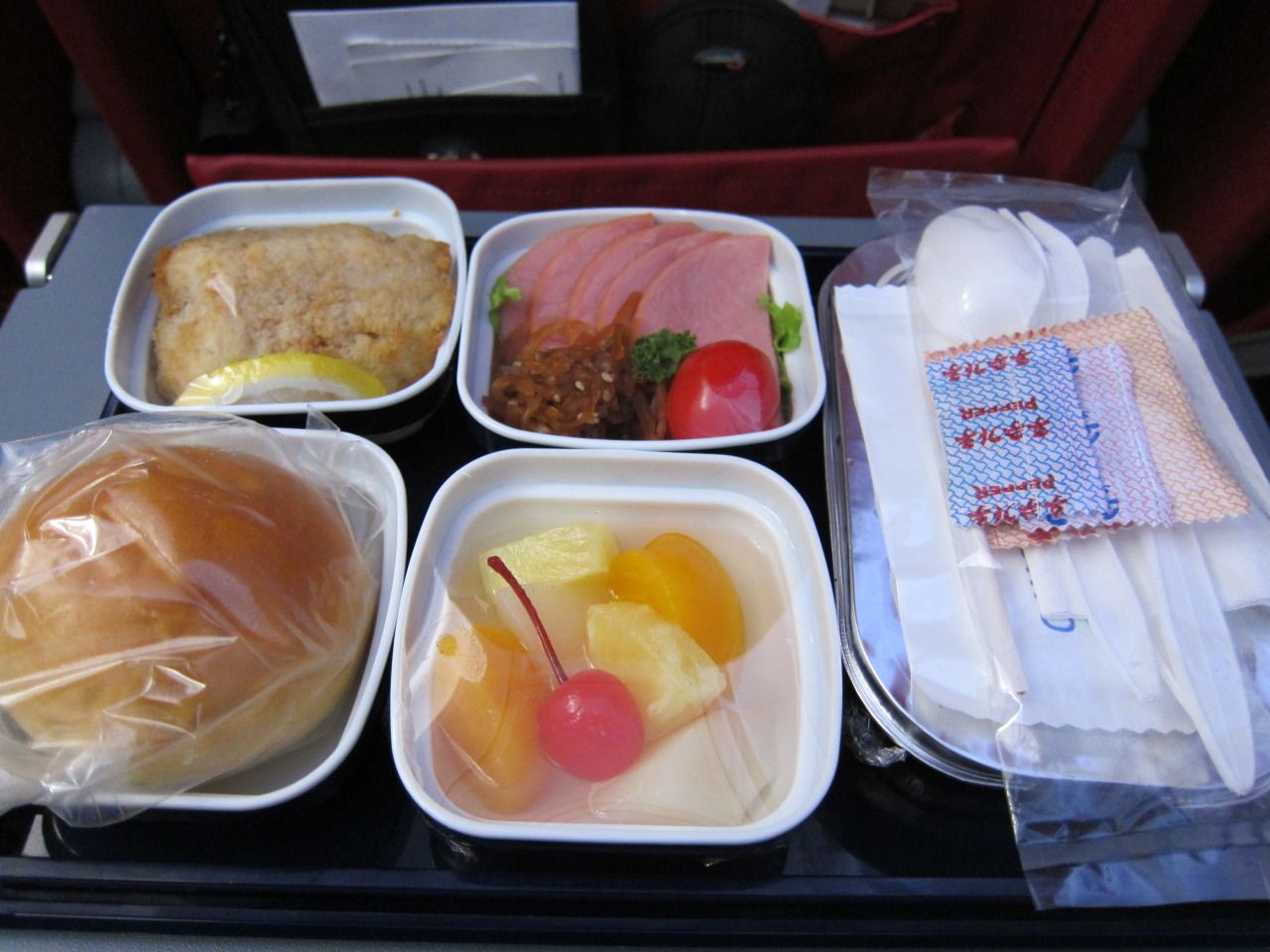
Our Air Koryo meal - better food than on Singapore Airlines, believe it or not. Something else you don’t get on other airlines is an announcement declaring that this flight was only made possible by the Dear Leader, Kim Jong-il (just one of many feats both amazing and pedestrian that would be wholly credited to a member of the Kim dynasty) as well as another announcement later in the flight stating in a voice breathless with emotion that we had now crossed the border and were flying over the Democratic People’s Republic of Korea. Incidentally the locals don’t like the name “North Korea” as it implies equality with what they refer to as the puppet regime in Seoul propped up by the American imperialists. You’ll get a lot further by always referring to the country as “the DPRK”. Likewise Kim Il-sung is always “The President”, Kim Jong-il is “the general” or “the leader” and Kim Jong-un is also known as “the leader” nowadays.
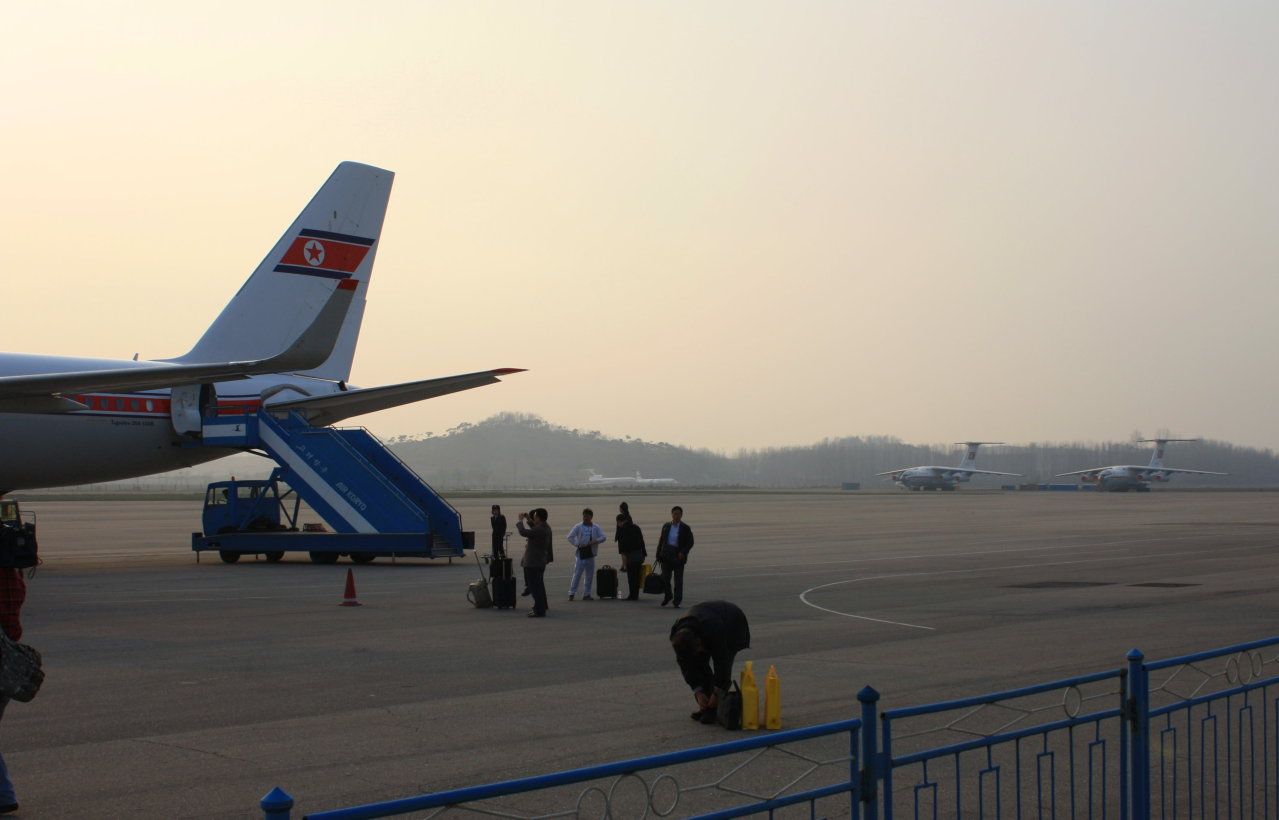
Sunan International Airport, where on a busy day there may be three or four flights. The brand new terminal building resembled a shed more than anything, but contained passport control, baggage claim, customs, check in and a gift shop, all in about the same area as the Cathay Pacific lounge at Heathrow, although with rather fewer creature comforts but rather more photos of Kim Il-sung and Kim Jong-il. Once we had our luggage everyone on the tour’s mobile phones were confiscated and separated into groups, those of us leaving by train would be given ours back at the station but forbidden to unwrap them until we’d crossed back over the Chinese border. Interestingly something that Pyongyang and Melbourne have in common is that we are both one of the few major cities worldwide that don’t offer rail links to our respective airports. Therefore we had a bus ride through some of the countryside before we got to Pyongyang itself. On board we met Shan from Young Pioneer Tours who would be our sub-group's main guide, the other people on the tour as well as our chief Korean guide, Miss Jong, who gave us an introduction to North Korea which contained the first of many errors of fact we would encounter in the days to come.
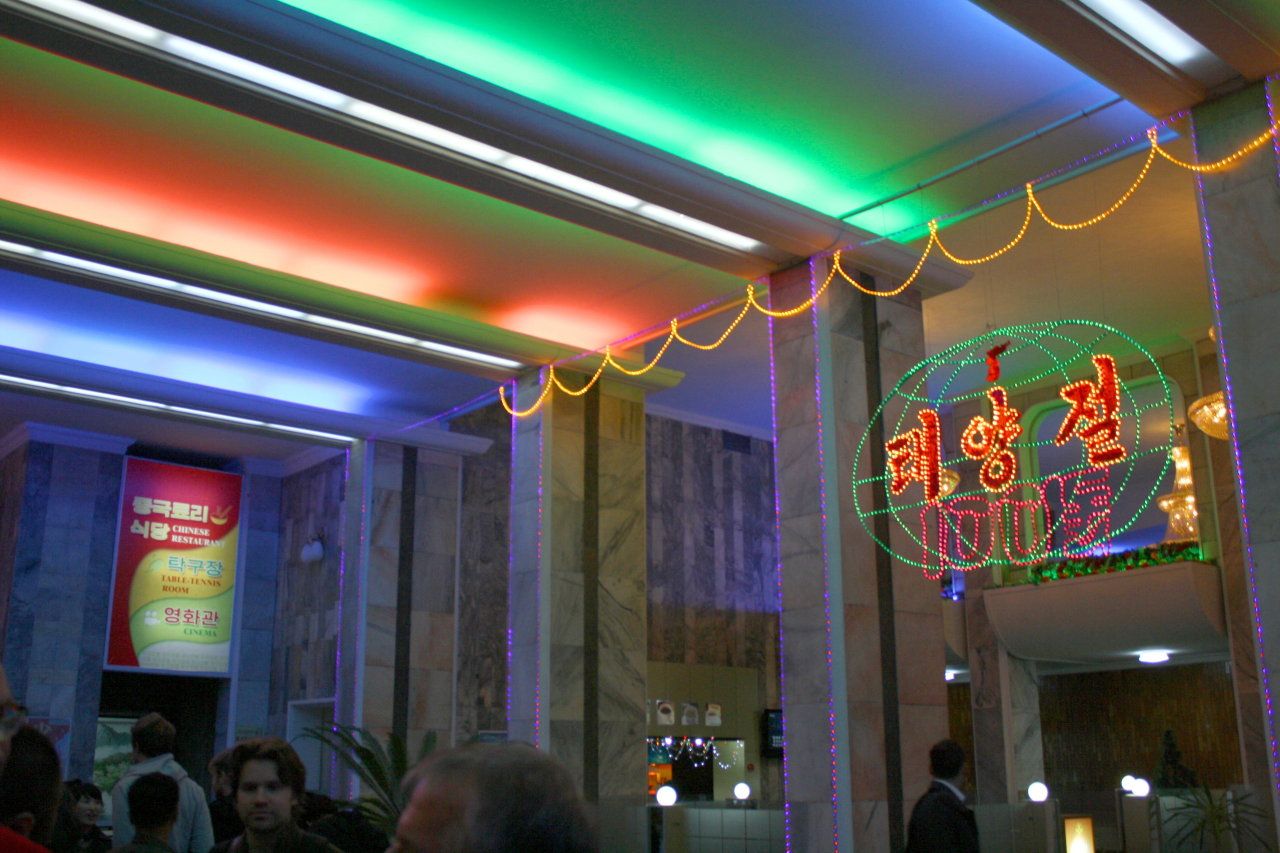
Our home in Pyongyang, the Raynggang Hotel, with the foyer looking like a 1970s East German disco. Once at the hotel you must surrender your passport which will not be returned until you check out. At no time can you leave the hotel without your Korean guides. Thankfully the foyer also had a bar in it, and after dinner we got talking to some of the more hard-drinking members of the tour, enjoying North Korea’s world famous Taeddong beer at just 50 Euro cents a 600 ml bottle.
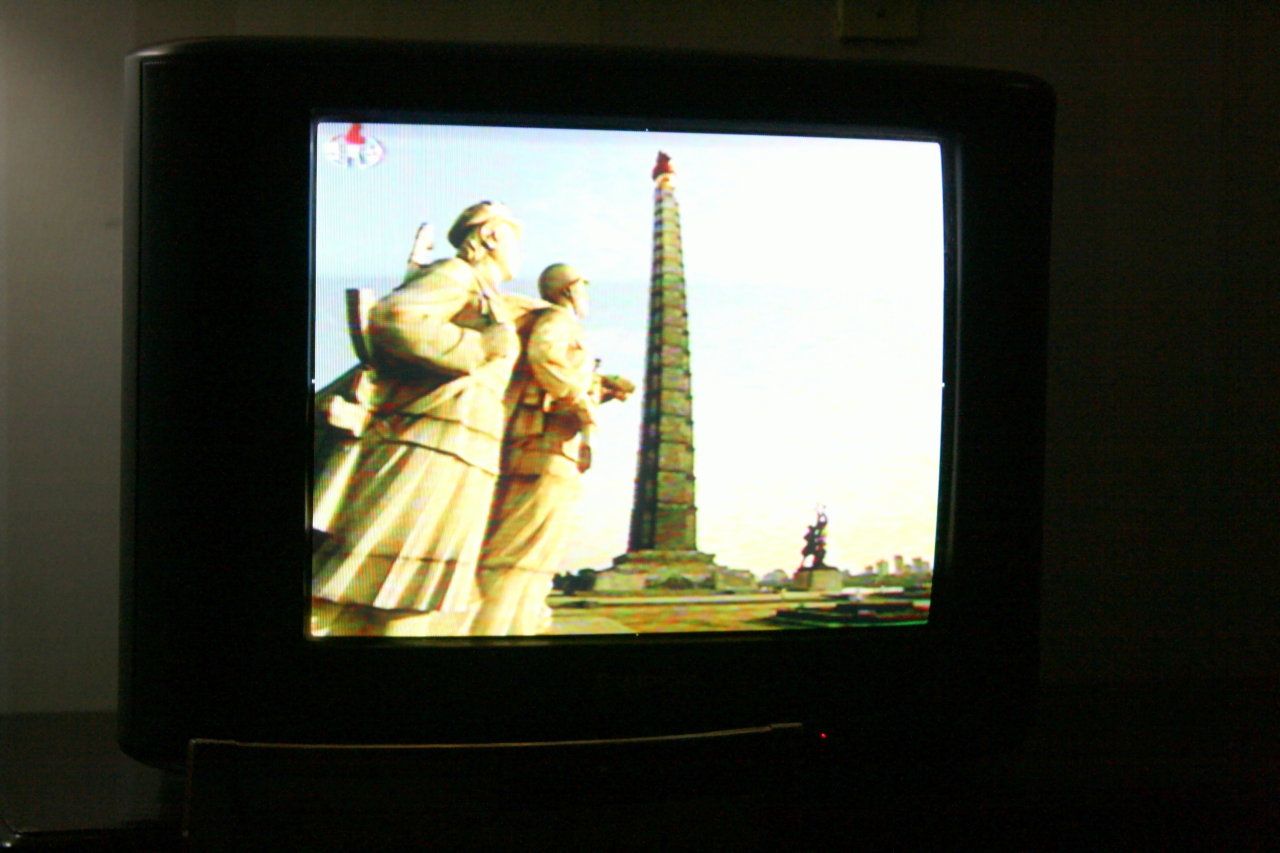
North Korean state television is exactly the same as how you’d imagine it. They now have two channels, the first was showing a congress of the Worker’s Party of Korea in which some old guy was droning on while the Rubeneque figure of new leader Kim Jong-un sat impassively through the regular storms of applause from all the other delegates, while the other featured the sort of saccharine singing and dancing kiddies that we ourselves would experience at the Children’s Palace several days later. This screenshot of the Juche Tower was sort of a station ident (even though there’s only one station).
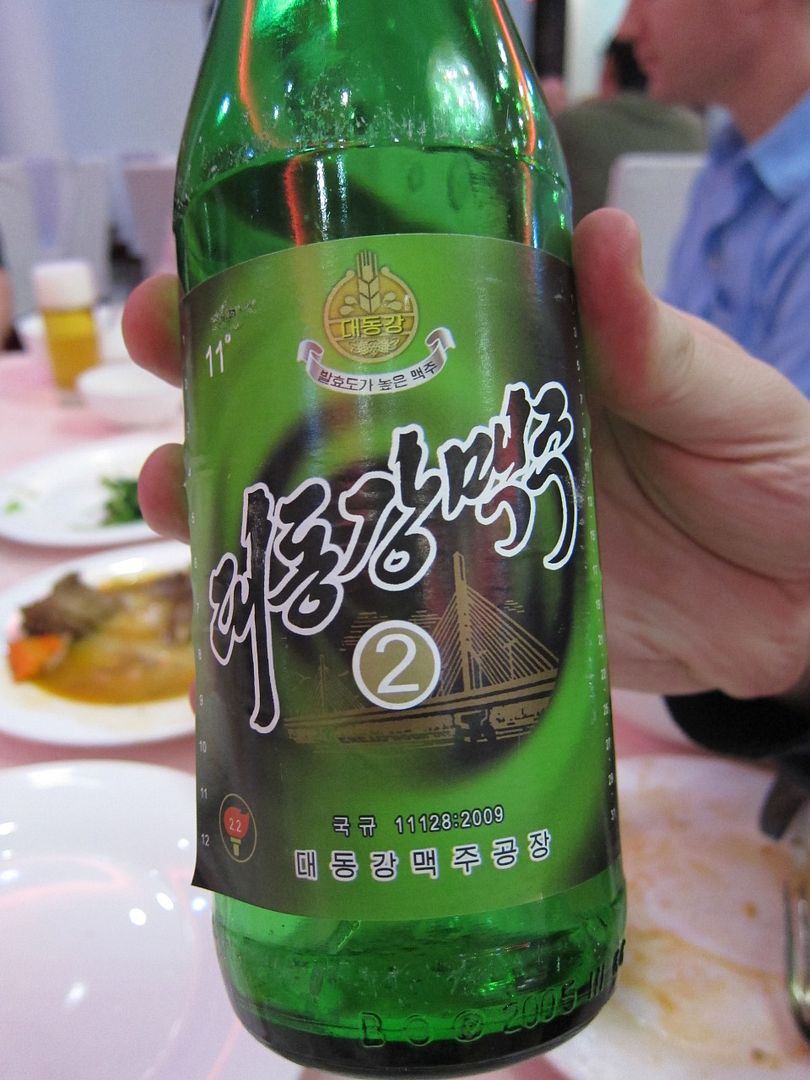
The afore mentioned Taeddong beer of which many were enjoyed over our stay..
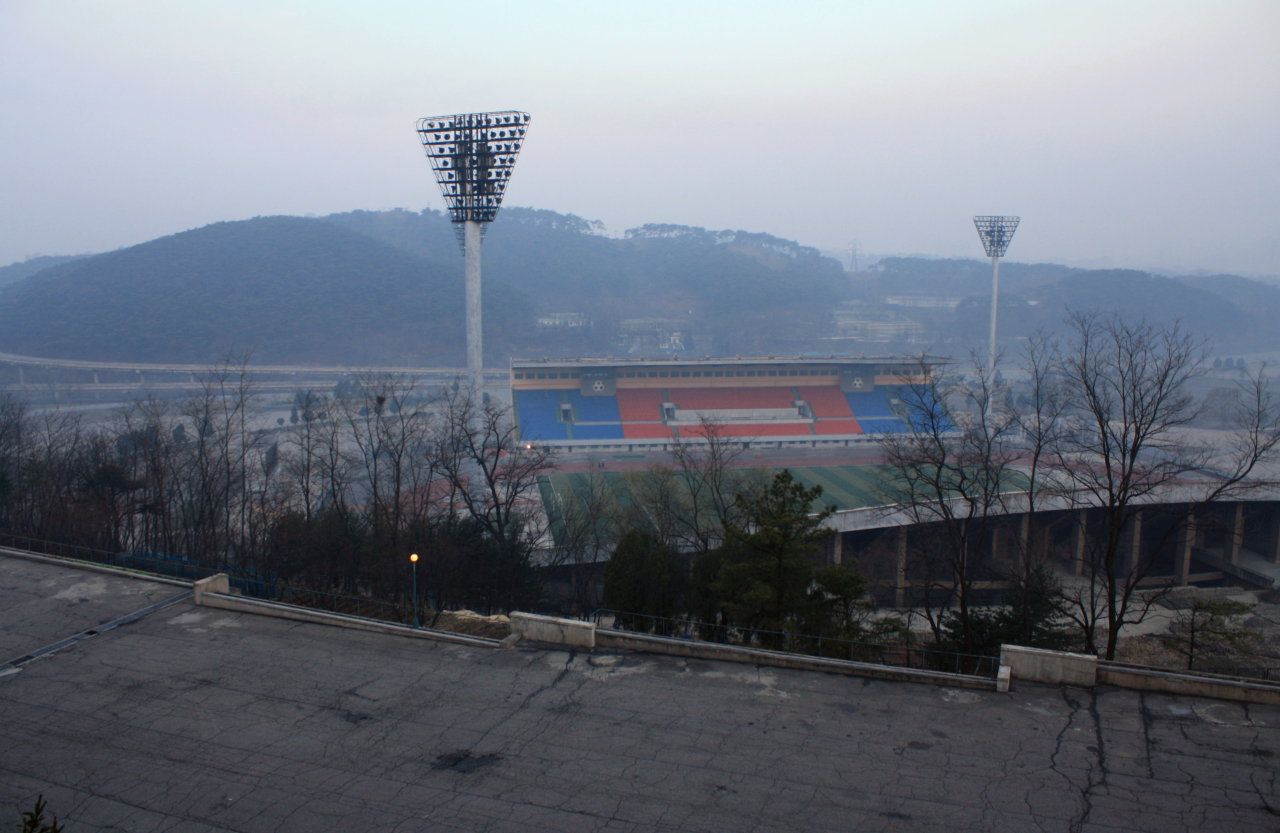
The view from room 413 at dawn. The hotel was in a sort of sporting district, the road into the centre of the city was lined with different stadiums for different sports. One other thing that must be mentioned about the hotel is the beds, very much like a billiard table with sheets, Ash actually hurt himself falling on to his when we first arrived. The only way to get to sleep was to booze up heavily during the evening before crashing, and I can report that this was accomplished every night without fail.
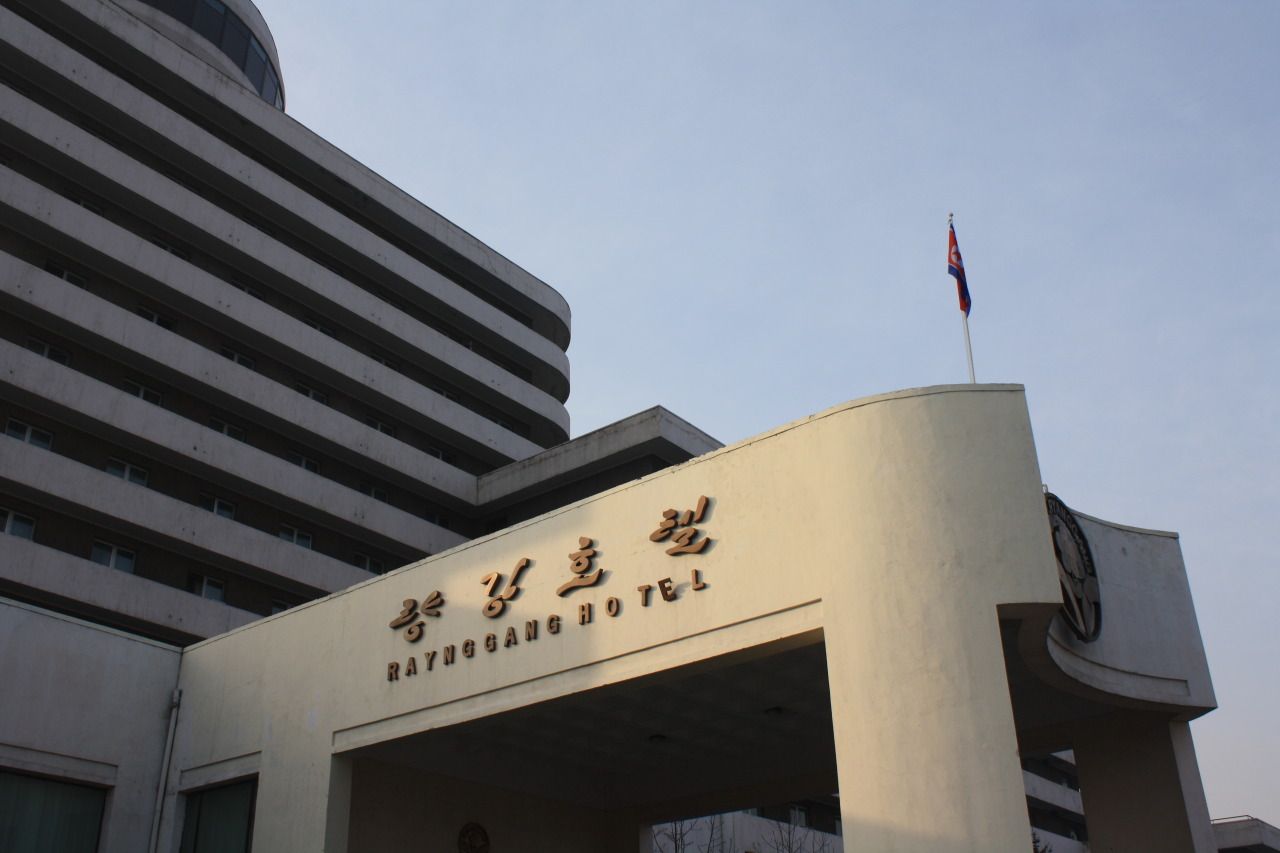
The hotel was opened in 1989 and like many things in North Korea hasn’t been renovated since and is already falling apart. Some of the reviews are less than complimentary.
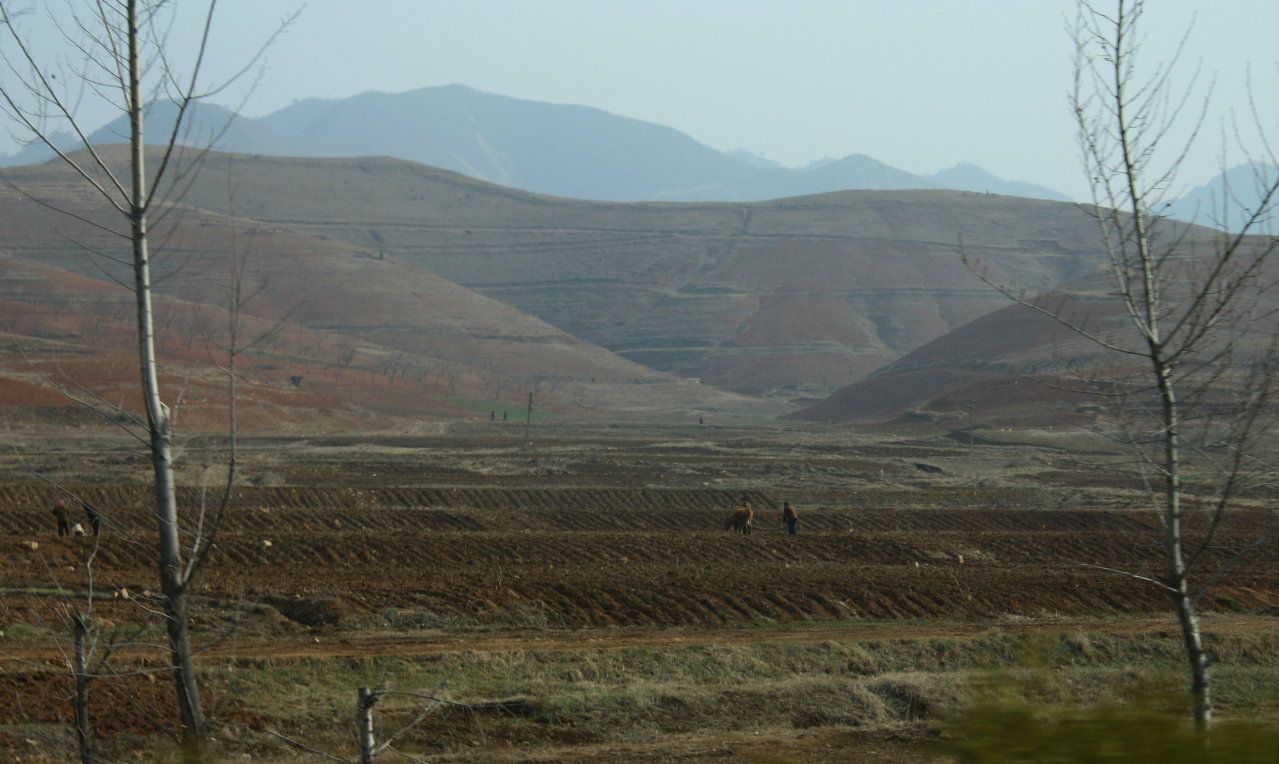
Our first destination was the Demilitarised Zone (DMZ) that separates the two Koreas. On the way we drove through the Korean countryside most of which looked like this. Around 70% of Korea is mountainous, and those bits that can be farmed are subject to freezing winters, and that’s before you consider the decades of underinvestment in agriculture the country has suffered. It’s no wonder the country is reliant on food aid to prevent the populace from starving, and even with this aid there have been several major famines over the last twenty years. There are not many places where you can see oxen pulling ploughs in 2012, and while a handful of tractors were in evidence during the several hour bus journey, an awful lot of the farm work was being done by animals or by hand. This is the side of North Korea your guides would probably prefer you didn’t see, but as it’s happening along the main North-South highway there’s nothing much they can do to hide it.
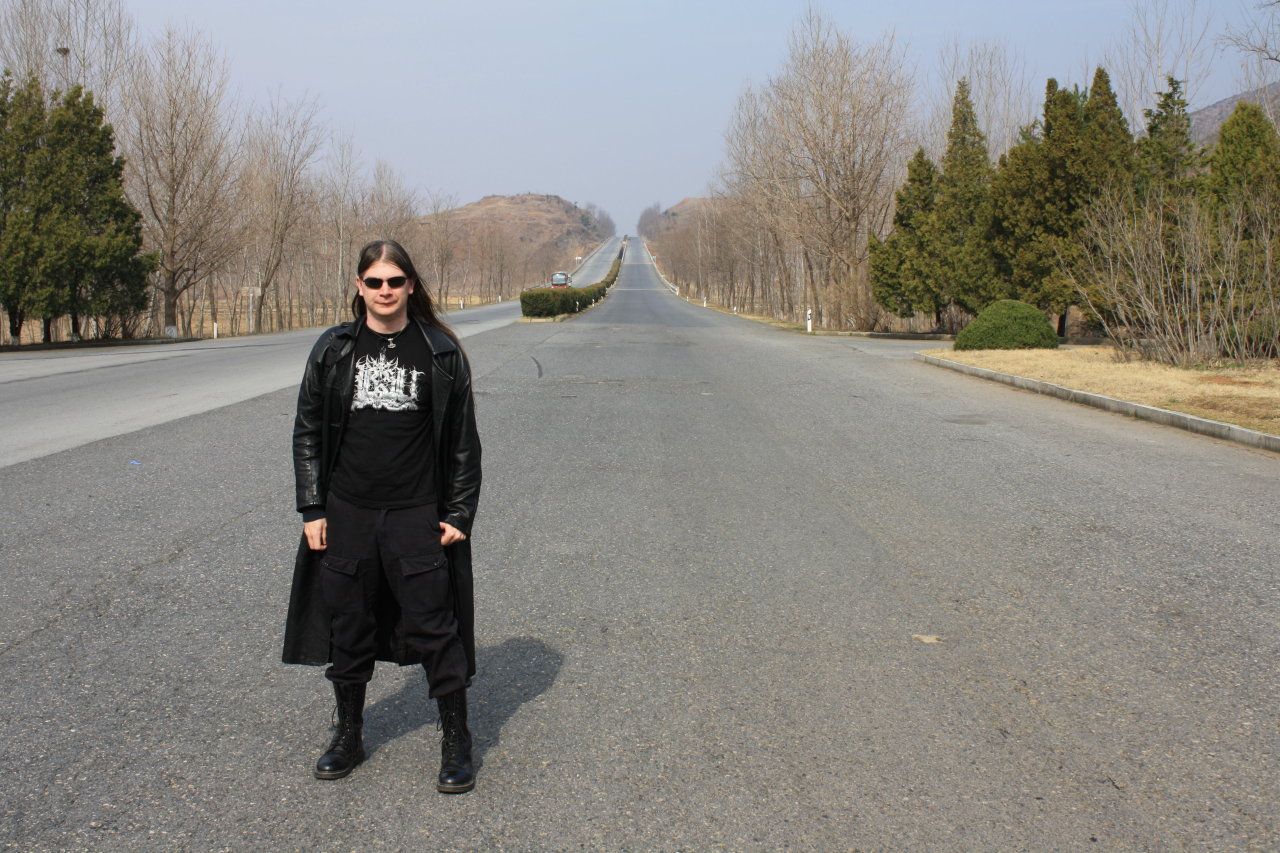
And this is what that main highway looks like, taken at a rest area about halfway between Pyongyang and the DMZ. No need to wait for the traffic to clear, there's almost none.
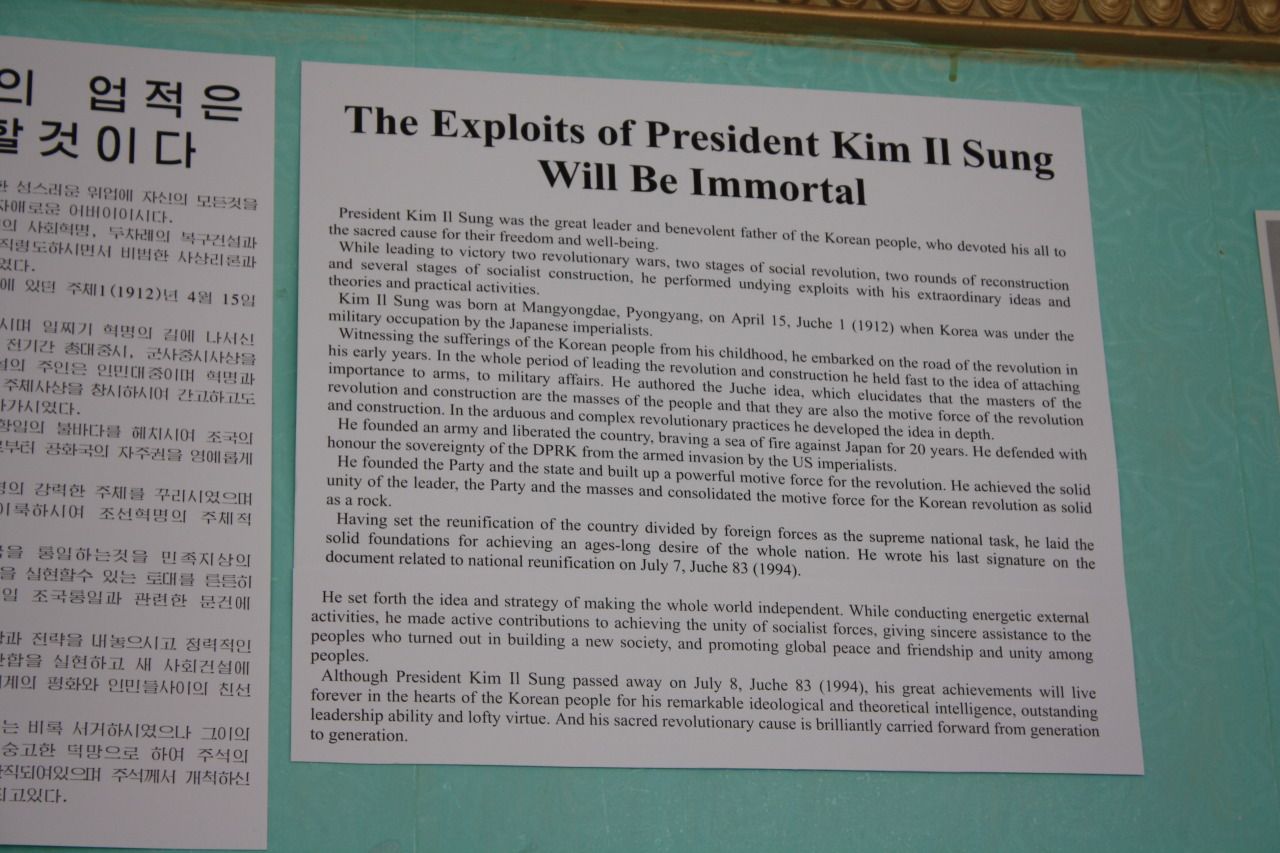
This sign I found in a room inside the rest area is about typical of North Korean propaganda. Amuse yourself by counting the errors contained within these few brief paragraphs.
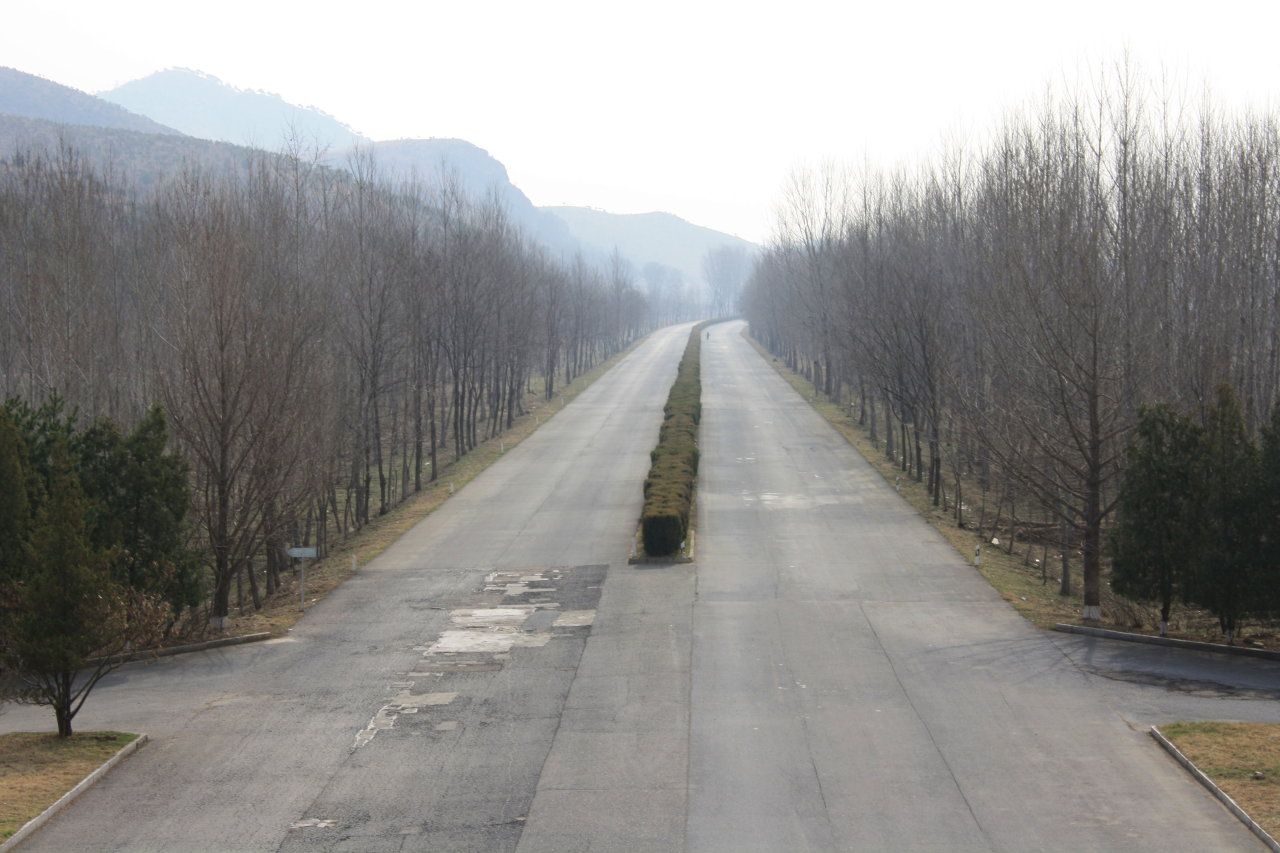
The hedge down the middle of the road is a uniquely North Korean feature, in places outside Pyongyang these disappeared, possibly to allow the road to be used as an emergency runway in a time of war.
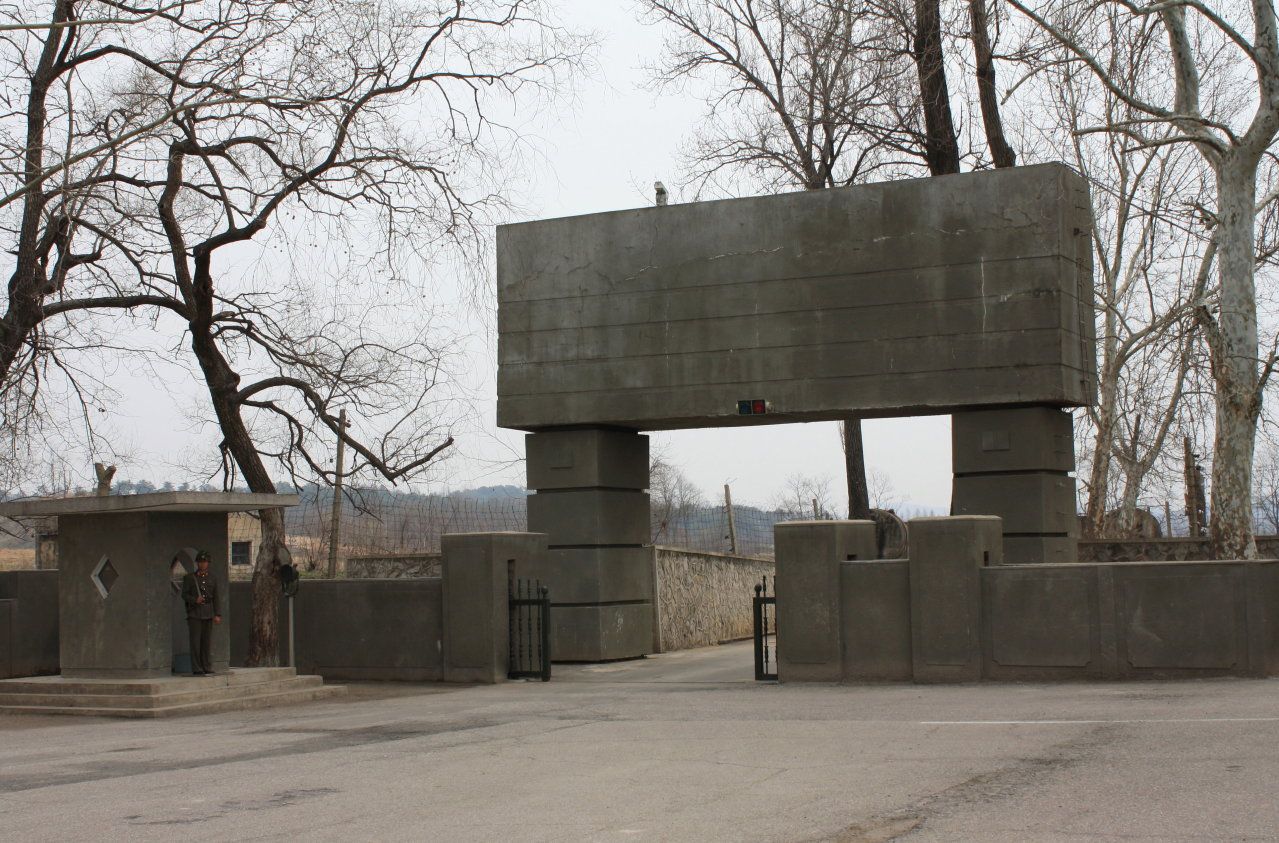
The edge of the 4 kilometre wide Demilitarised Zone which, despite its name, is the most heavily militarised strip of land on the planet and has been since the Korean War halted in 1953. Something like 100,000 soldiers watch each other from both sides of the border, and both sides conceal huge numbers of tanks and artillery pieces that we know about and other defensive systems that are only rumoured. Supposedly bolstering the 30,000 odd American troops in the South are tactical nuclear weapons, while the North has allegedly built a series of massive dams that are rigged with explosives, so if war were ever to break out they could detonate these and send raging floodwaters down into Seoul, the South Korean capital. In the old days the two sides used to broadcast propaganda messages across the divide and jam each other’s radio frequencies, although this behaviour has ceased in recent years.
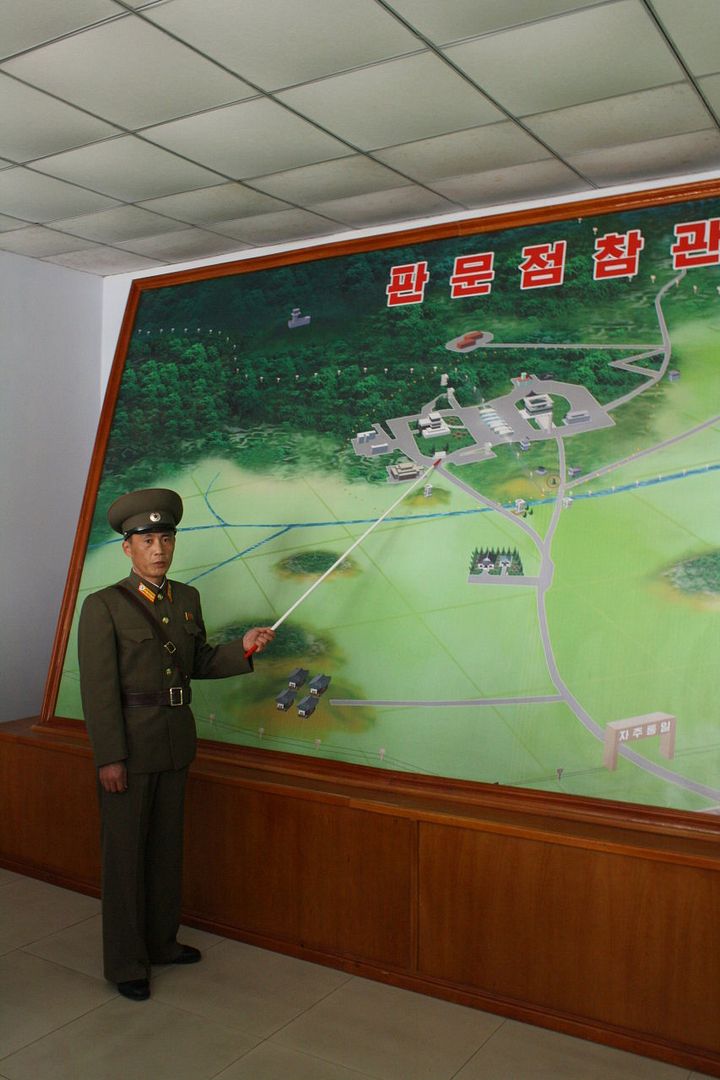
A Korean People's Army officer explains the layout of the DMZ and highlights some of the defences the DPRK has against an invasion from the South.
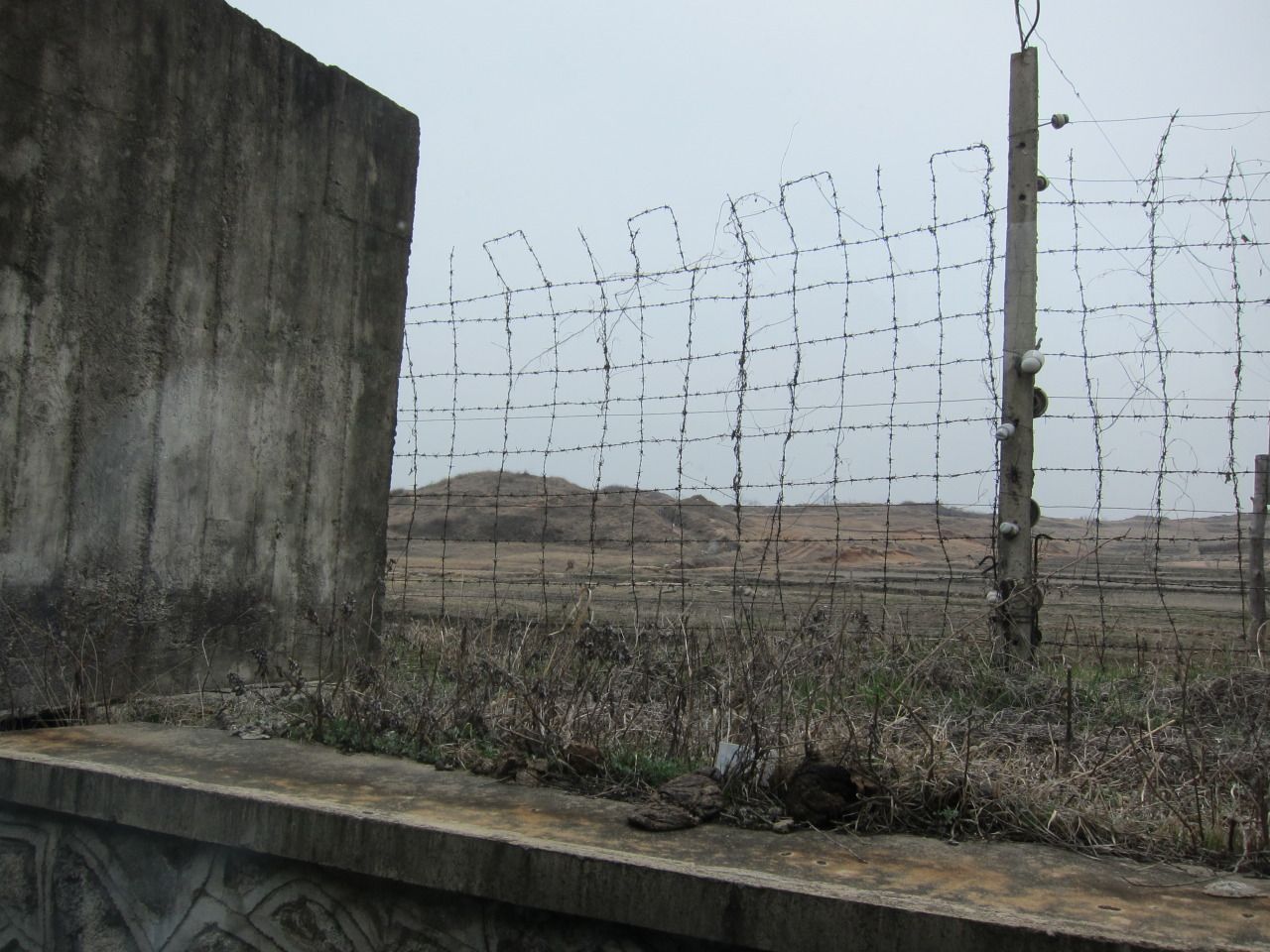
Accompanied by soldiers our coach slowly moved through the fortifications including massive concrete blocks which they can trigger to fall on to the road, obsructing the path of enemy trucks and tanks.
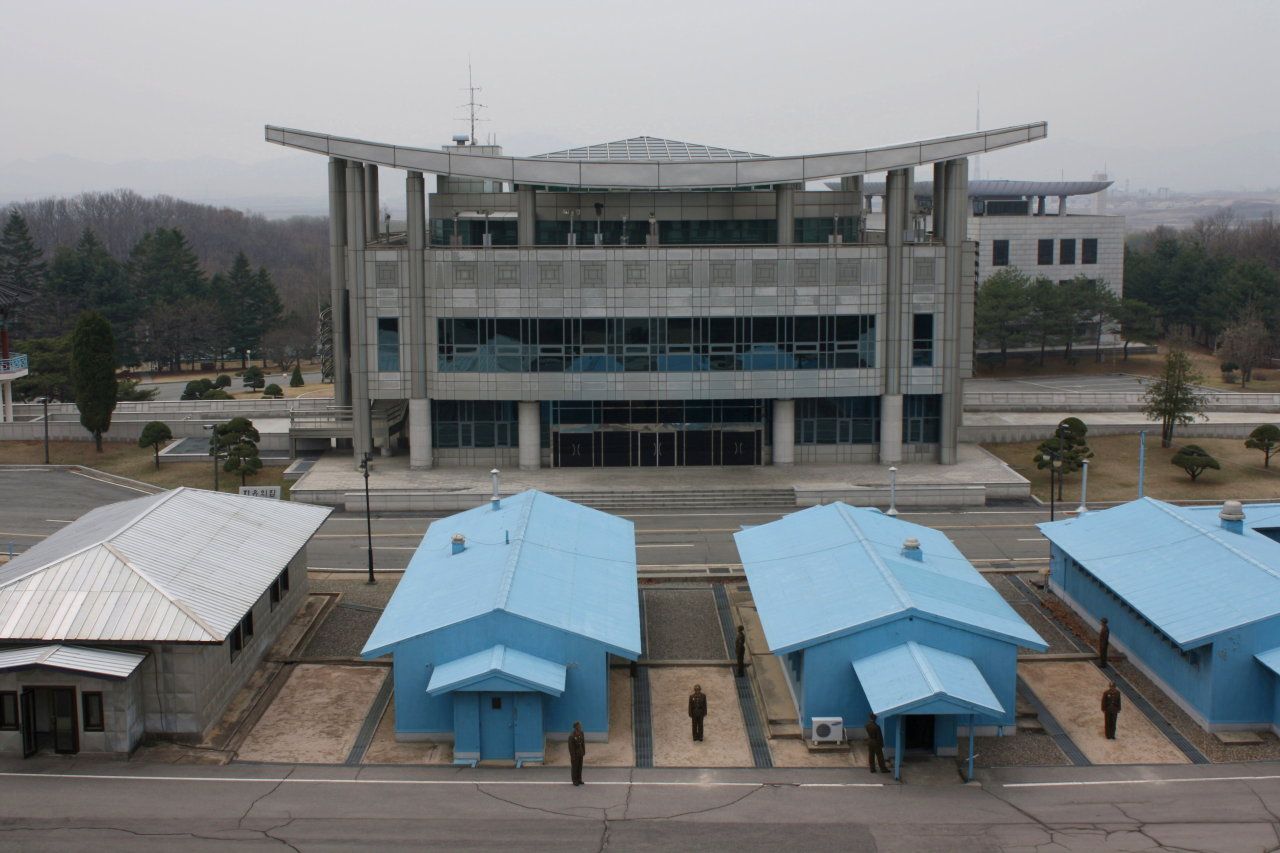
What is known as the Joint Security Area (JSA), the only place along the border where North and South Korea come face to face. Just near here is the so-called Bridge of No Return, where prisoner exchange swaps took place after the Korean War ended. While the North Koreans continually man the border the South Koreans and US merely observe it through CCTV cameras from the large building, and only send soldiers out to stand guard when tourist groups visit their side. I called the Americans “lazy bastards” for ruining an iconic Cold War photo I could have taken, and this abuse I believe endeared our guide, Miss Jong, to me.
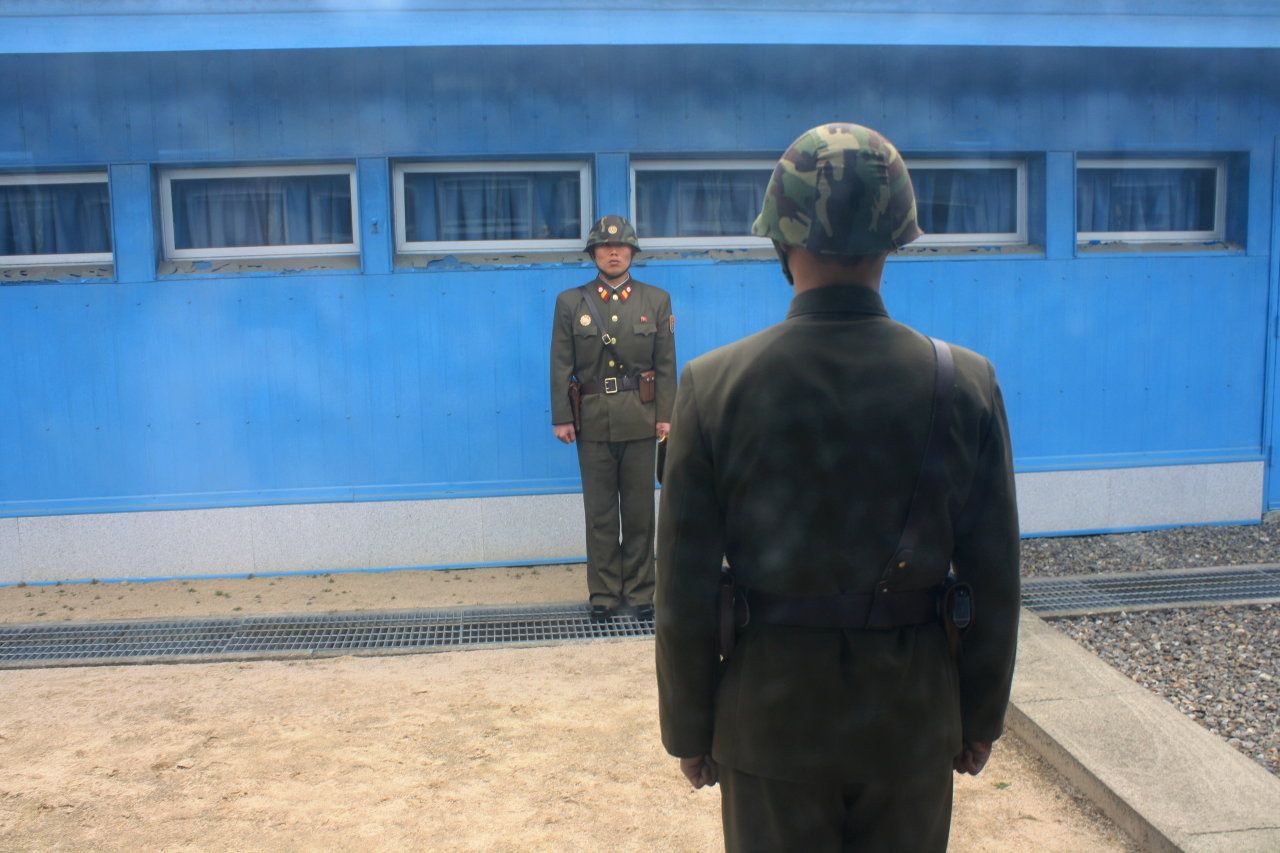
The two guards watch each other as much as they watch the actual border. If one attempts to defect the other is under strict orders to shoot him.
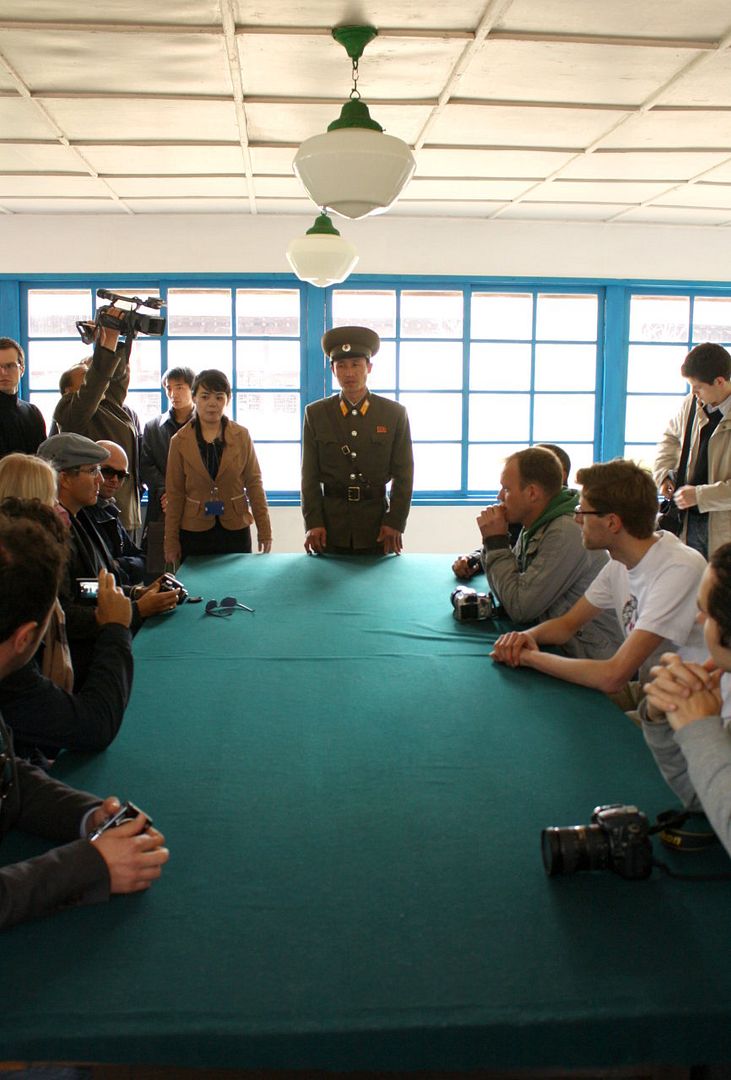
Located a short distance from the JSA is the former village of Panmunjeom. In this building at this table over several years an end to the fighting in Korea was negotiated. Of course the war would have been over very quickly had the DPRK not been bolstered by weapons and personal from the Soviet Union and the newly-declared People’s Republic of China, however there was no mention made of this assistance by Miss Jong or our military guides. Technically the Korean War never ended, a ceasefire was signed on 27 July 1953 however no armistice or truce has ever been declared. This means that the war has been going on for over 60 years, and that Korea, the DMZ in particular, is the last outpost of the Cold War.
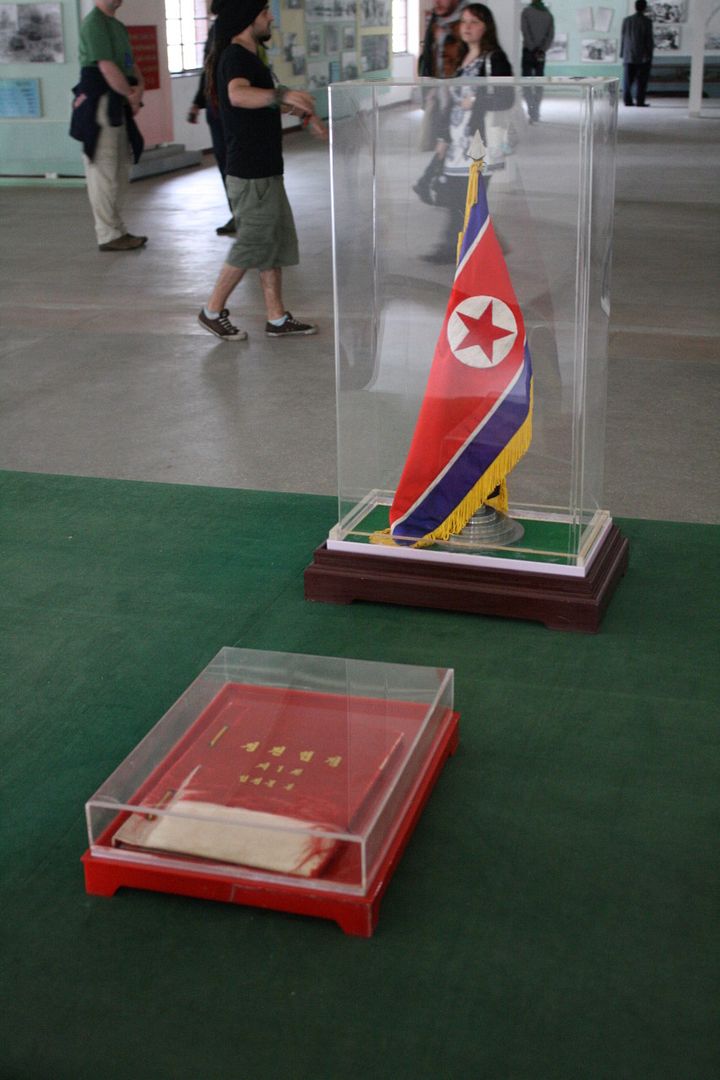
The original ceasefire agreement (or “American surrender” as our military guide put it) in the North Korean Peace Museum, next door to the building where it was originally signed. The JSA was also the site of the infamous axe murder incident of 1976 when the American forces attempted to cut down a tree within the DMZ that the North Koreans claimed was planted by Kim Il-sung. A fight broke out between the two groups of soldiers and at the end of it two US personal had been killed with one of the axes they were attempting to cut the tree down with. This axe is now proudly on display in this museum.
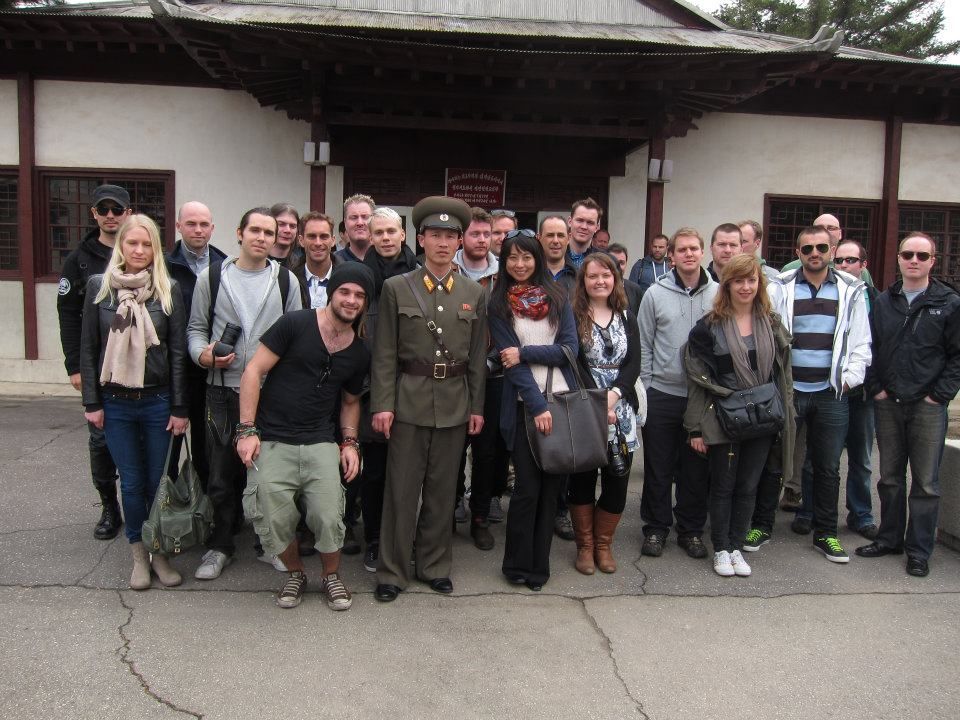
A nice group photo with a member of the Korean People's Army. Despite never feeling in any danger personally, the DMZ is still very a tense place swarming with armed soldiers, which possibly explains the shortage of smiles in this picture.
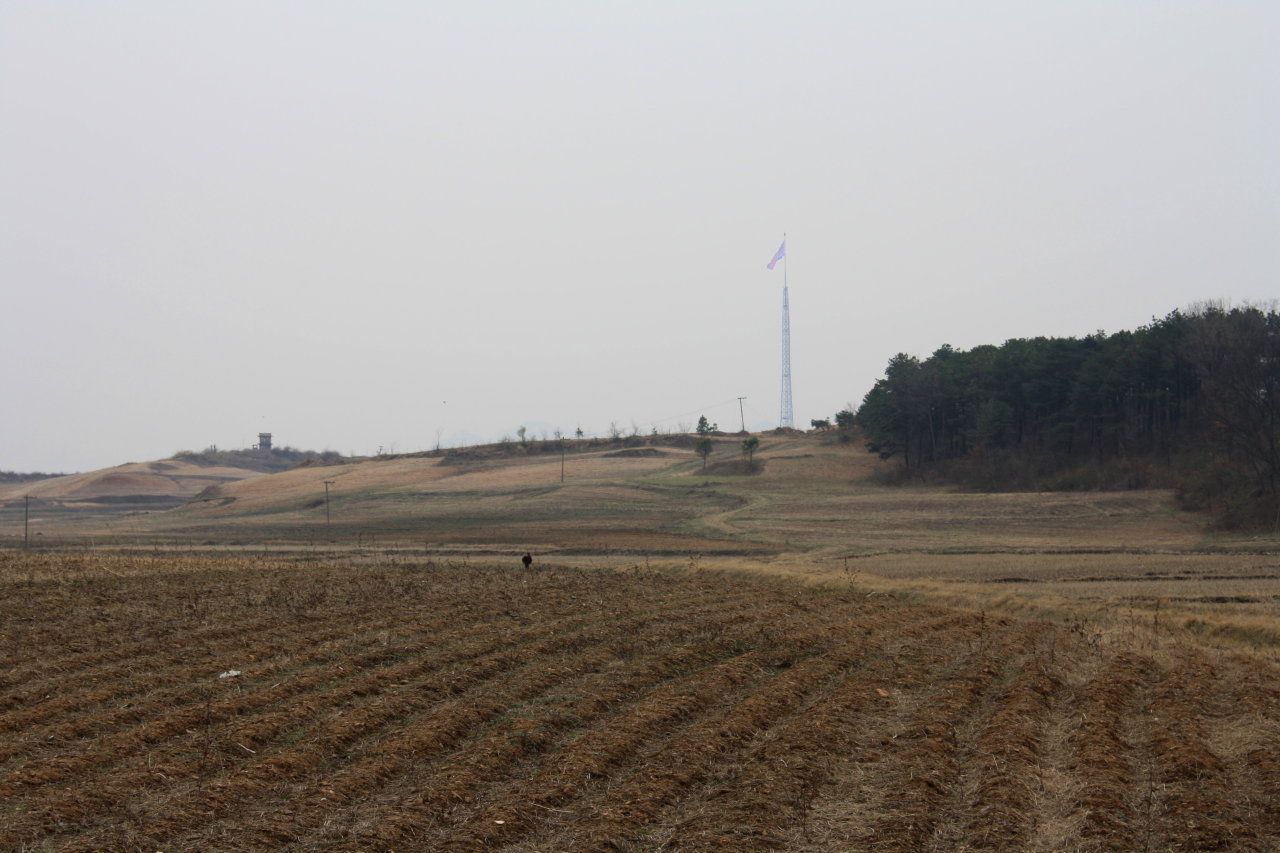
Looking across the DMZ towards the fake town of Kijong-dong (meaning “peace village”) to what used to be the world’s tallest flagpole. In the 1980s the South Koreans built a 98 metre high flagpole in the single village they are permitted to have within the DMZ that flew a 160kg South Korean flag. This would not stand so the North Korean government responded with a 160 metre tall flagpole that flies a 270kg North Korean flag. Paging Dr Freud.
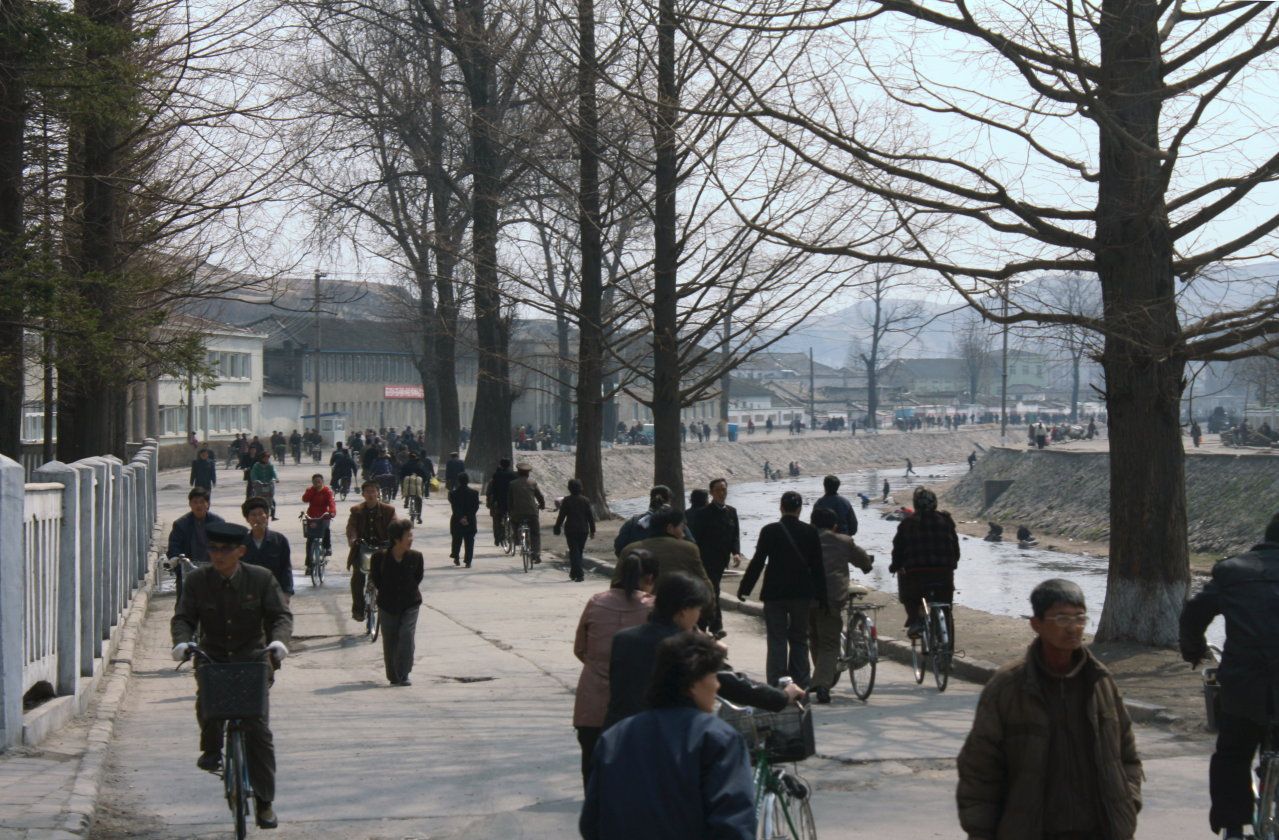
We then drove to Kaesong, the most southerly major city in the DPRK. What continually strikes you about North Korea is the lack of motor vehicles due to both low incomes and strict petrol rationing (even the North Korean airforce have very limited non-simulator training due to the cost and difficulty of obtaining fuel that being an international pariah entails). This means that just about all ordinary people have to walk or cycle everywhere resulting in scenes like this.
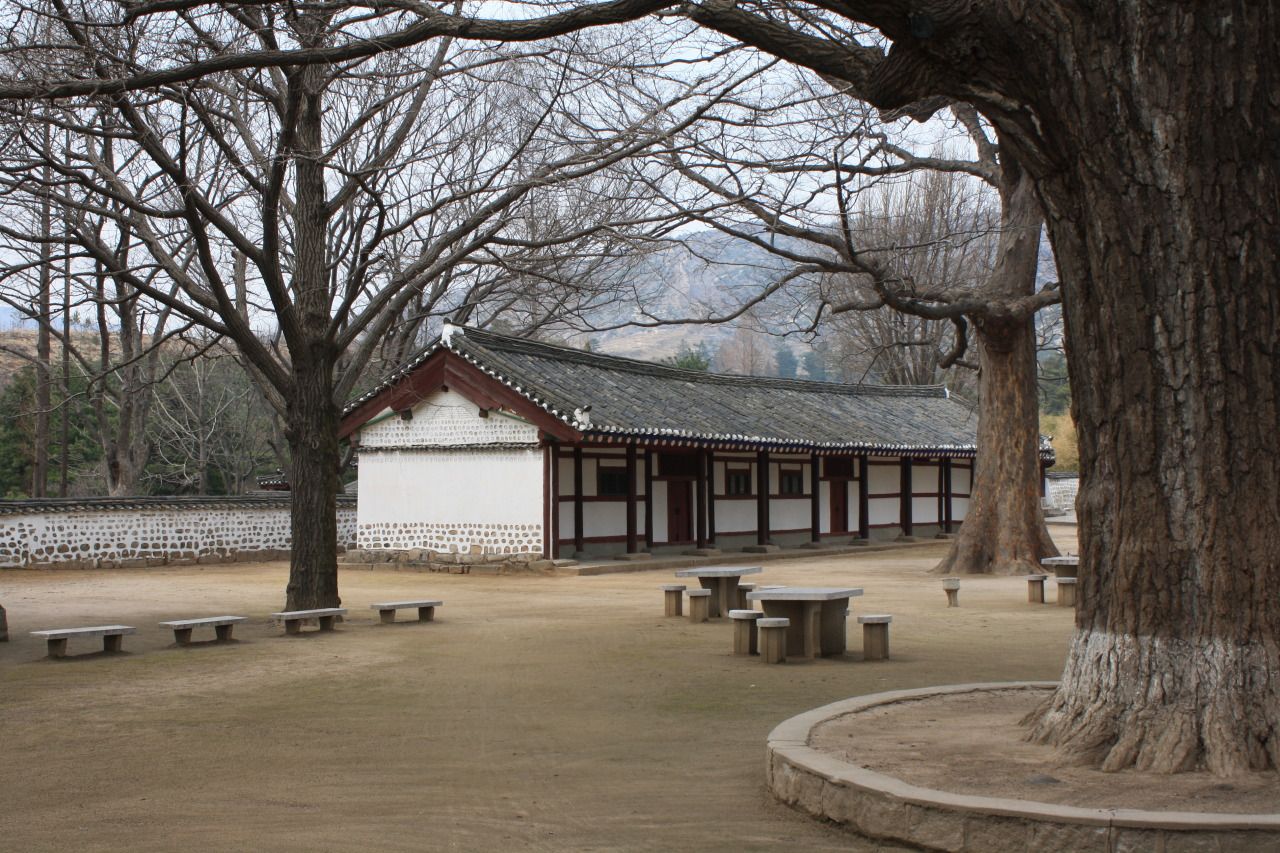
In Kaesong we toured this old Confucian university that’s most prominent display was evidence of the fact Kim Il-sung once visited it.
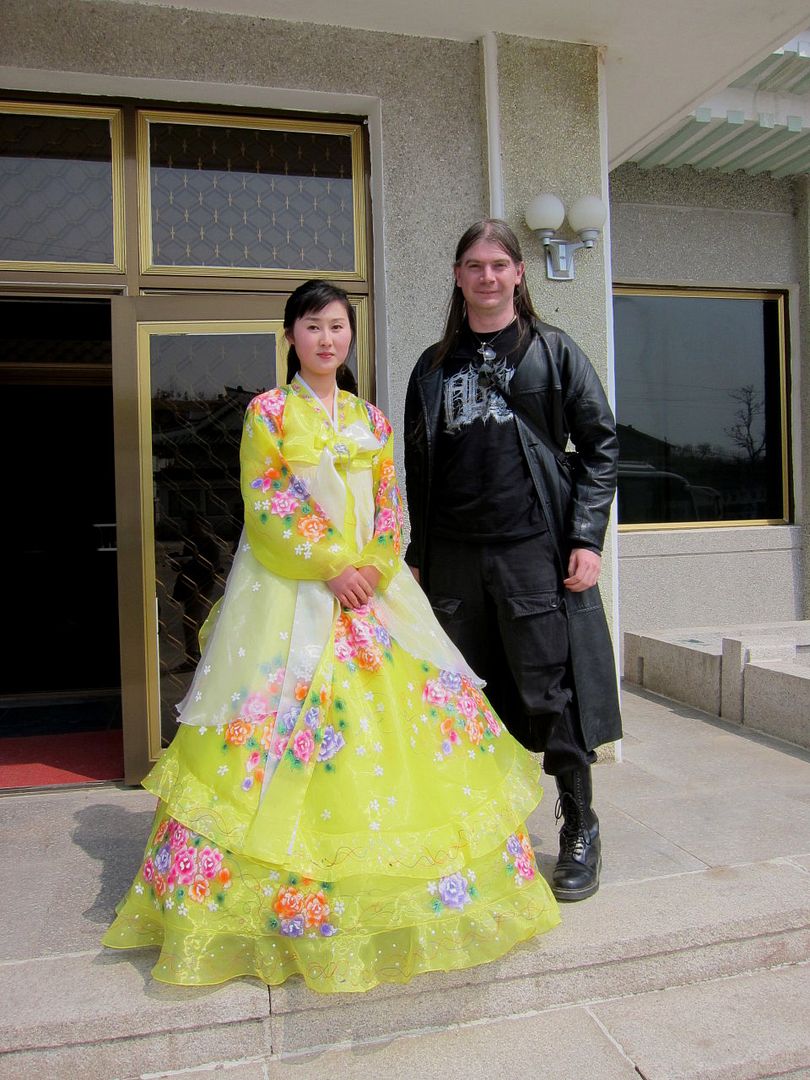
Outside a gift shop where many propaganda posters were bought I posed with a local woman wearing a variation on the traditional Korean dress known as the Chosŏn-ot but colloquially referred to as a “Christmas tree dress” for obvious reasons.
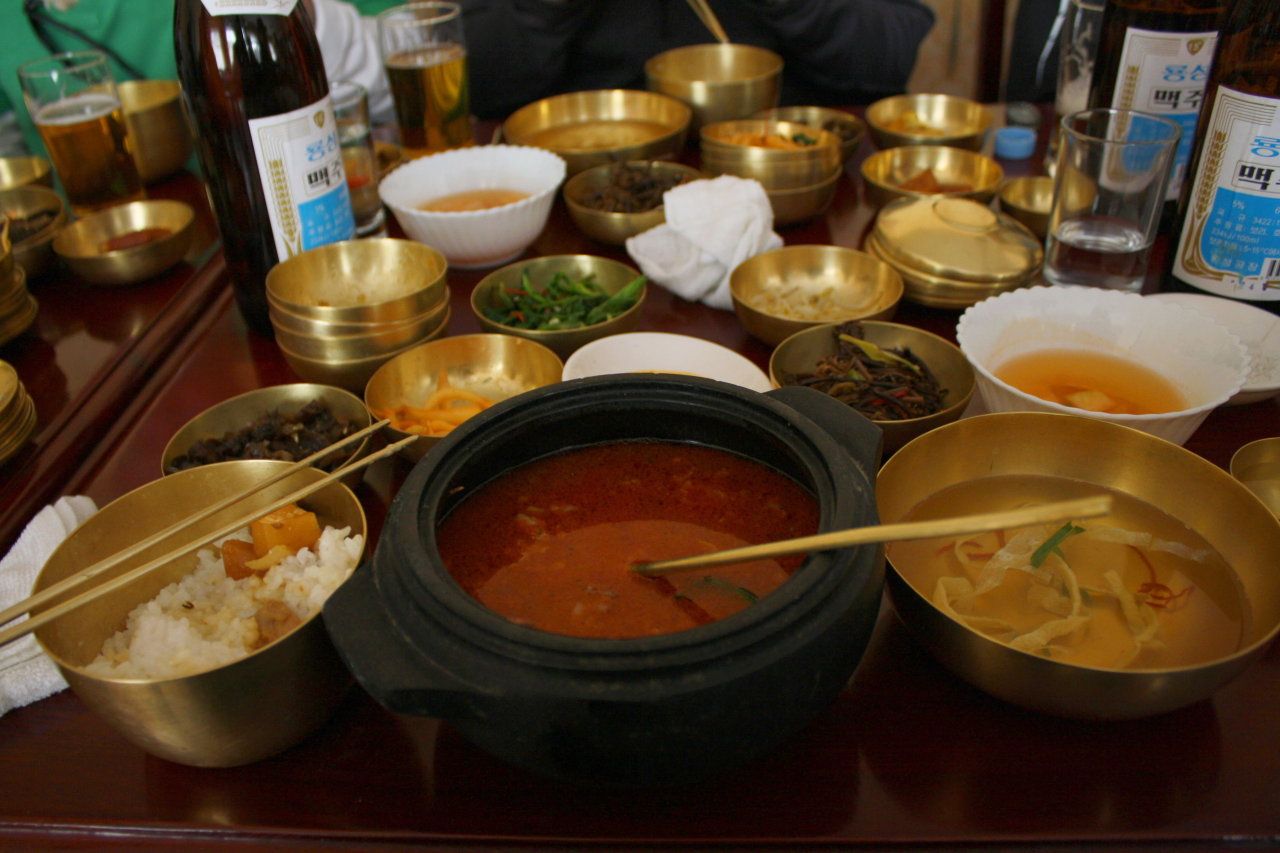
Traditional Korean food which was delicious, but the beer that accompanied it was awful - it tasted like soy sauce and dirt, first time I can recall neither Ash nor myself not finishing booze.
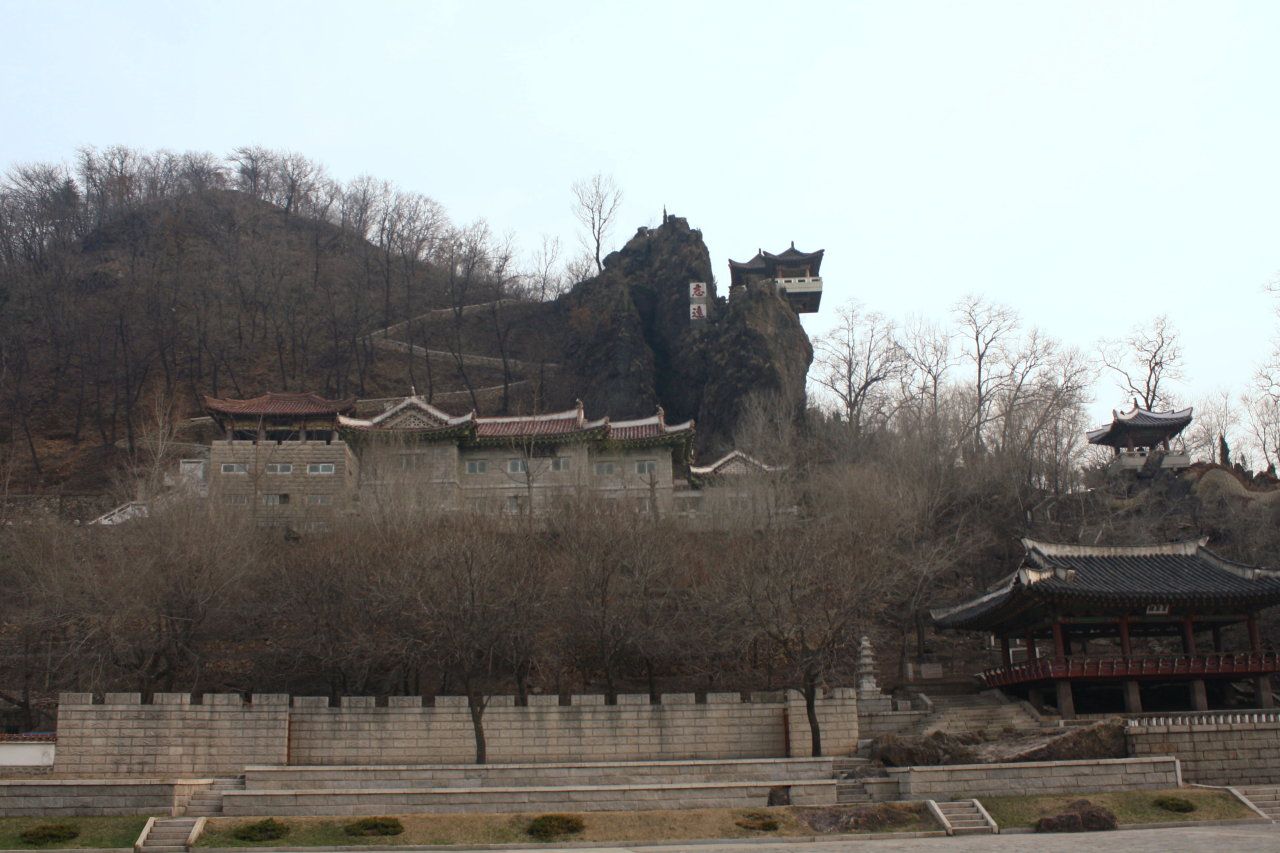
On the way back we stopped off at the town of Sariwŏn to stretch our legs by climbing this hill.
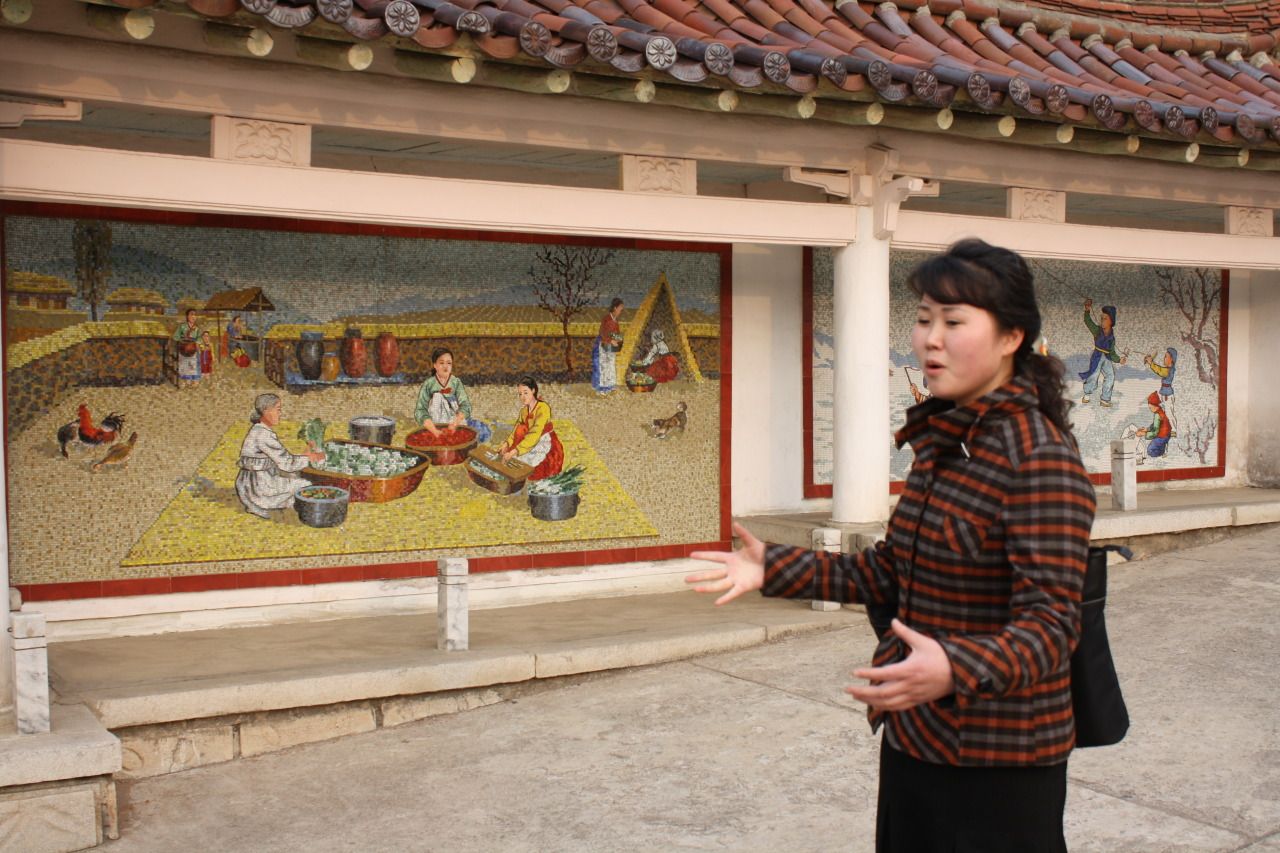
At the base of the hill were displays showing various aspects of Korean history, here Miss Jong is explaining how kimchi is made in front a tiled mural showing the making of kimchi.
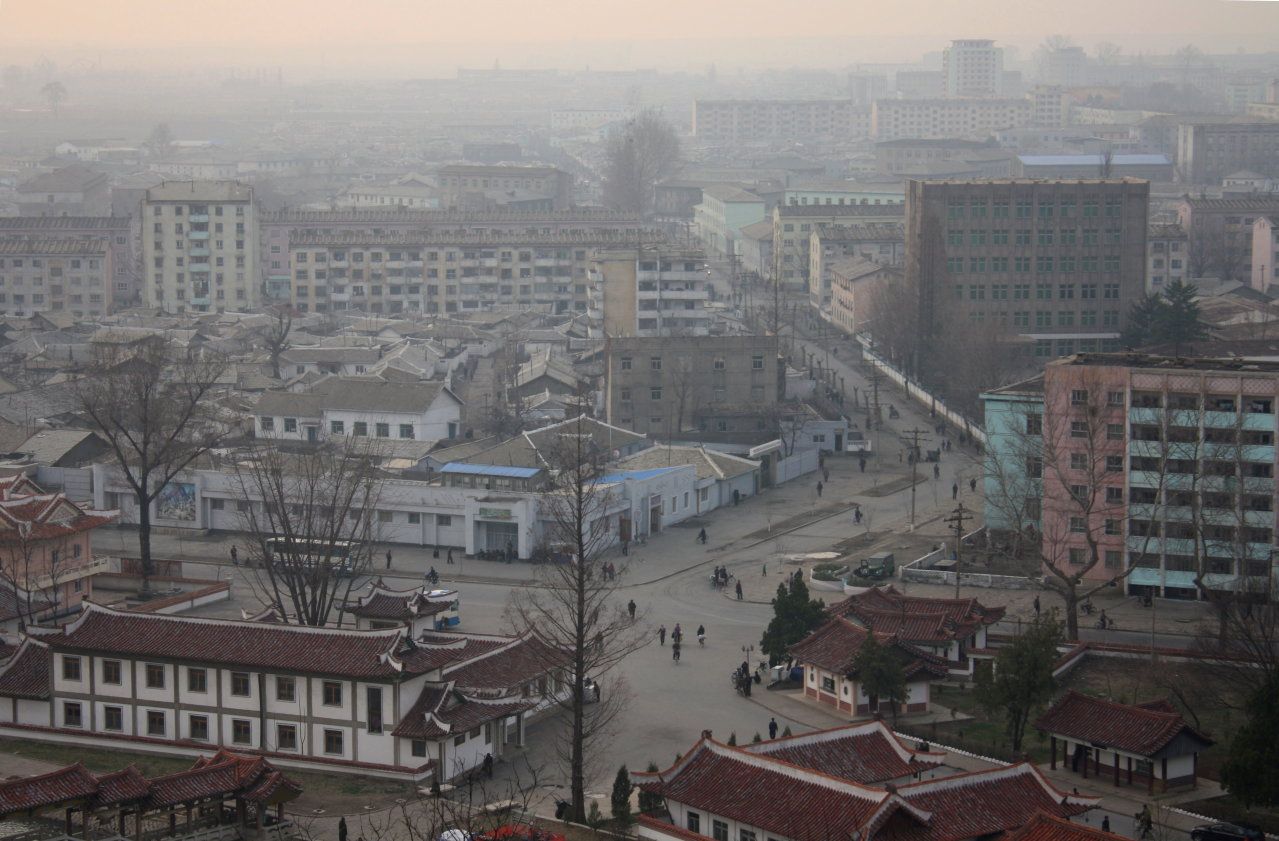
View of Sariwŏn from the top of the hill.
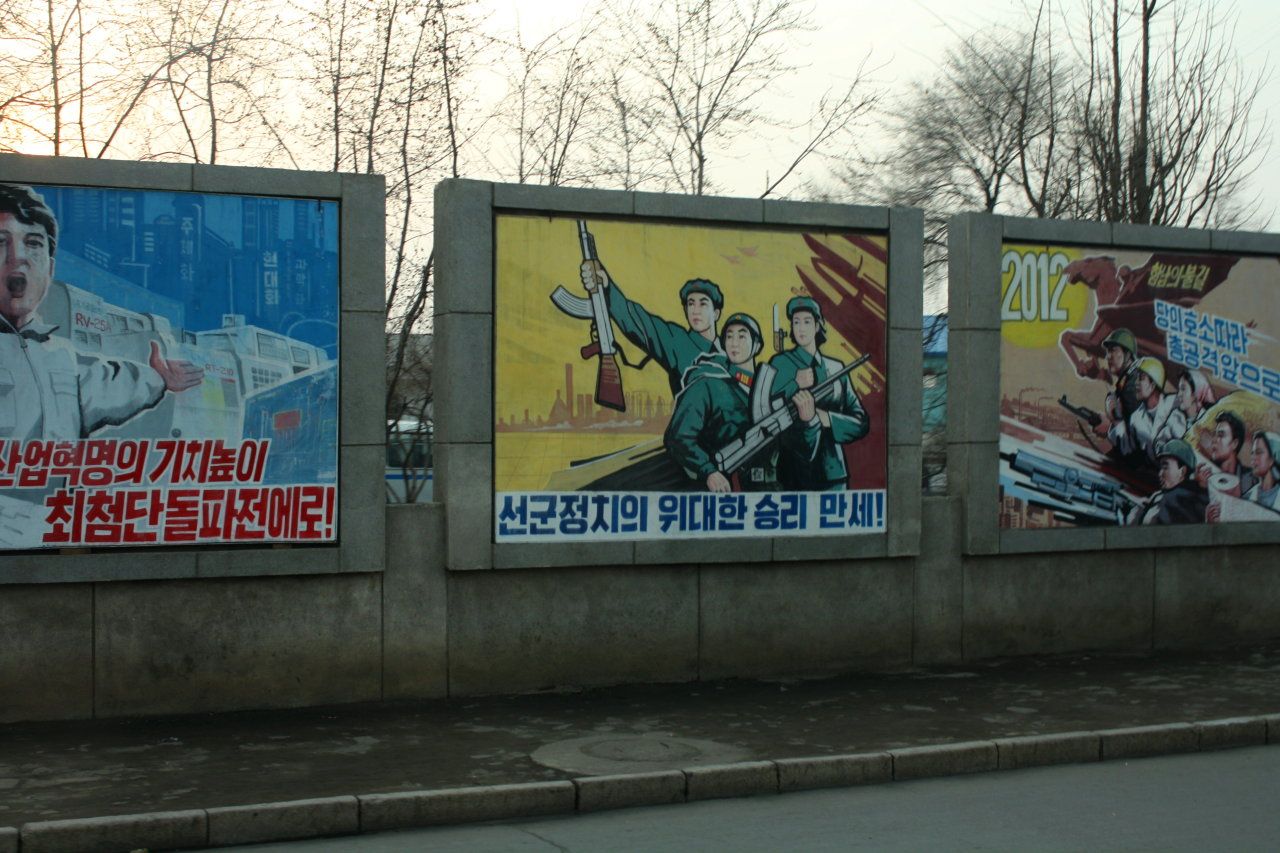
Everywhere in North Korea you see such propaganda posters, anywhere else in the world such valuable real-estate beside roads would be taken up with advertising hoardings. I especially enjoy the guy yelling about the “high-tech” computers on the left. While no one would argue that state propaganda dominating public spaces is a good thing, you have to ask yourself that if this was replaced for an ad for McDonald's, would it really be such an improvement? Surely there must be some ideal middle ground betwixt the twain.
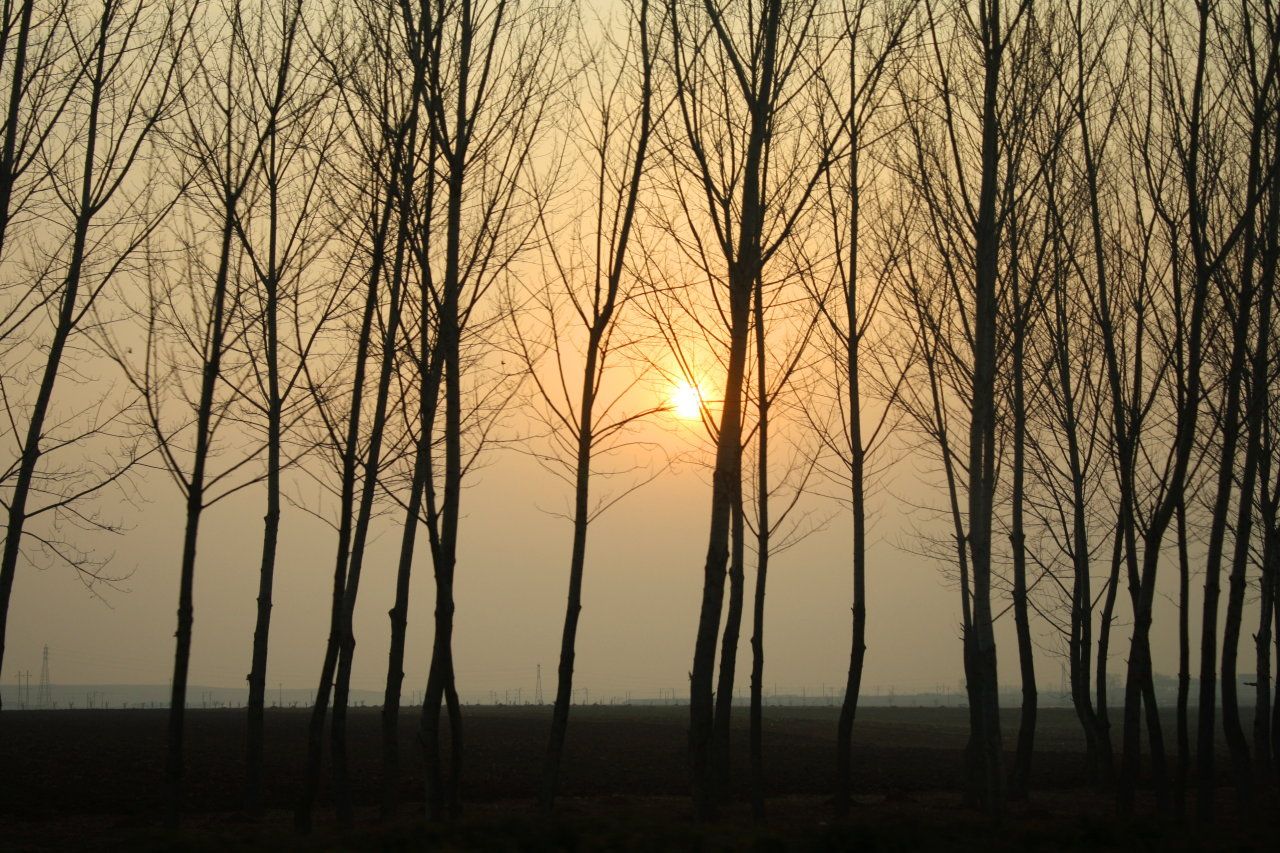
Sunset on the way back to Pyongyang.
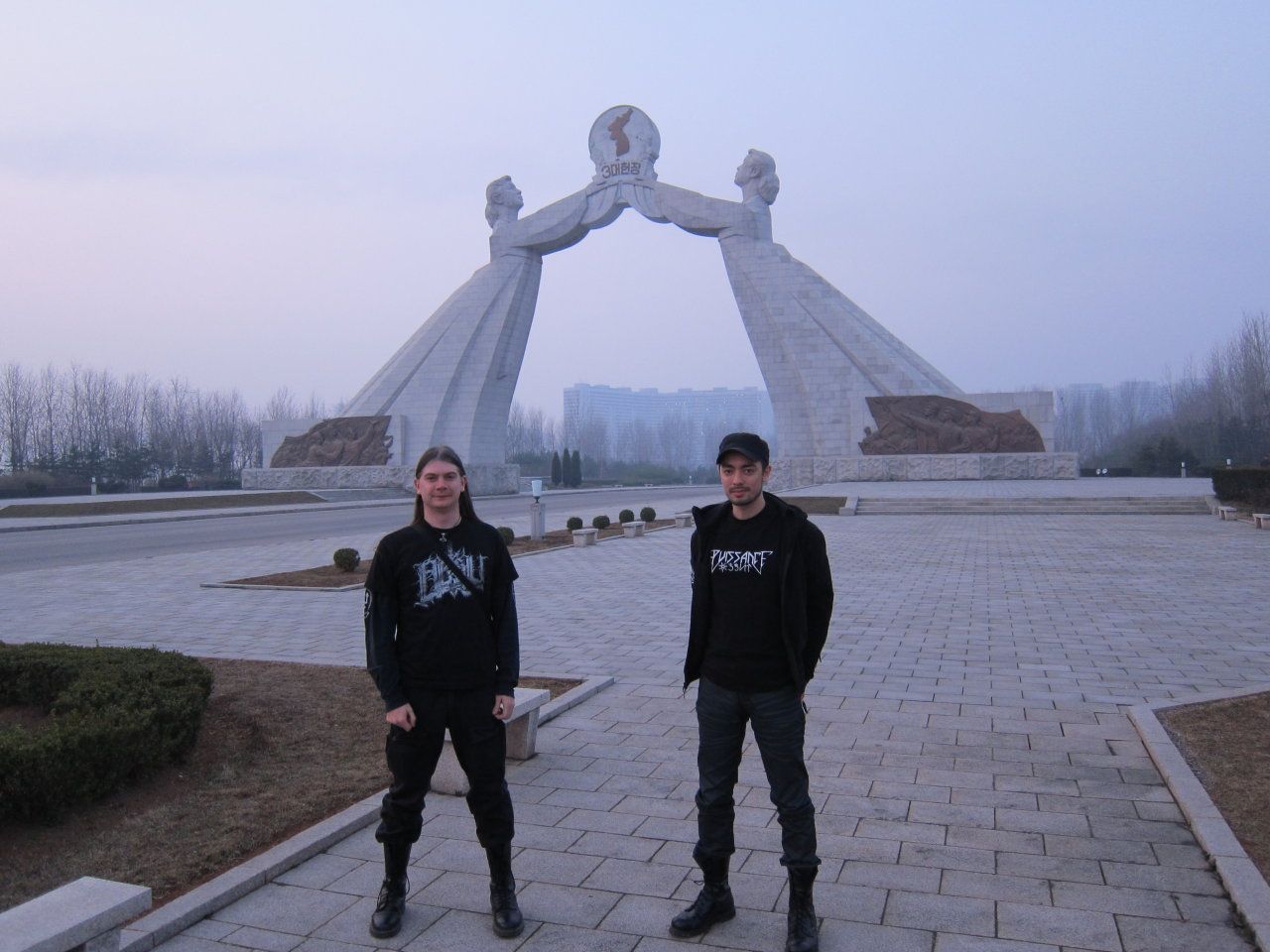
This incredible structure is the Arch of Reunification, erected in 2001 to show how committed the DPRK and the Kim dynasty are to the reunification of the two Koreas. Further editorialising on this monstrous irony (and sculpture) is not needed, so instead will just say this was a great moment for me as Ash and I had been talking about going to North Korea for years, and it was such an amazing feeling to have finally got there. As an icon of the DPRK standing underneath the Arch really bought it home for me.
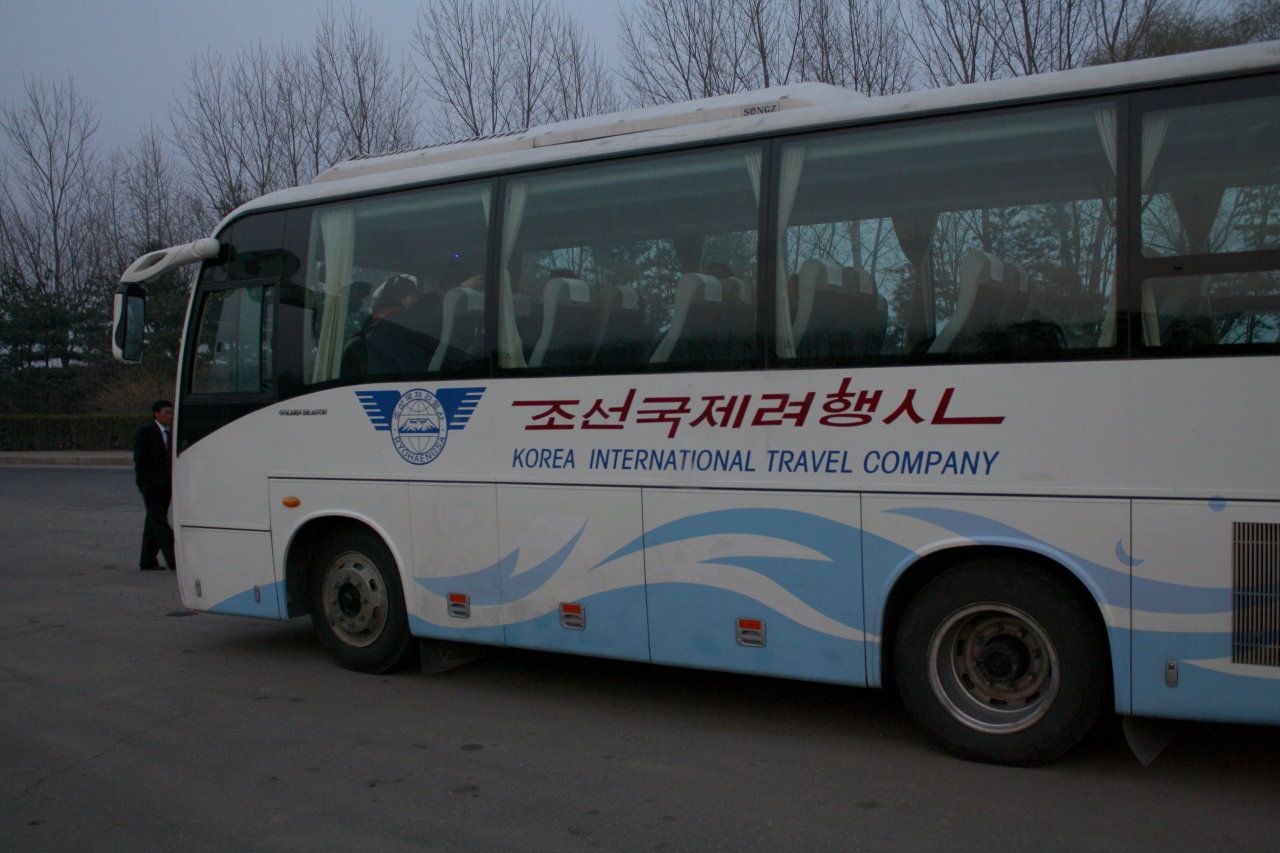
Our trusty mini-bus. Earlier in the day a tyre had burst on the rough as guts North Korean “highway” but thankfully was fixed in short order. KITC or the Korean International Travel Company is the state agency that organises all tours within North Korea. They provide the bus, the driver, the guides, the hotel and tell the guides what tourists can and can't see and at what times.
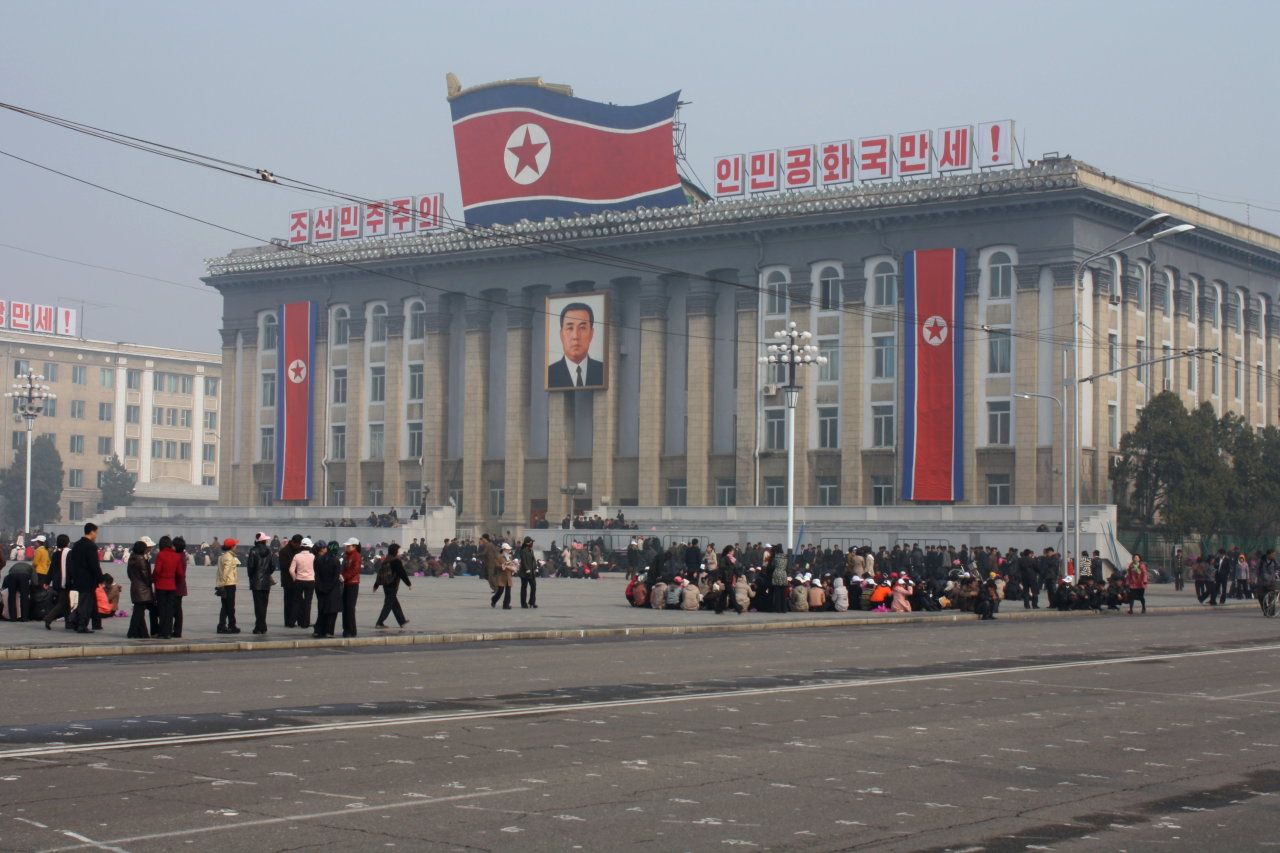
The next morning we headed into the very centre of Pyongyang, Kim Il-sung Square. Our Korean guide told our group it was the largest square in the world, when in fact it's only the 30th largest yet it can still accommodate 100,000 people at one time. The people standing and sitting around were taking a break between rehearsals for the big 100th anniversary parade which was due to take place the next day.
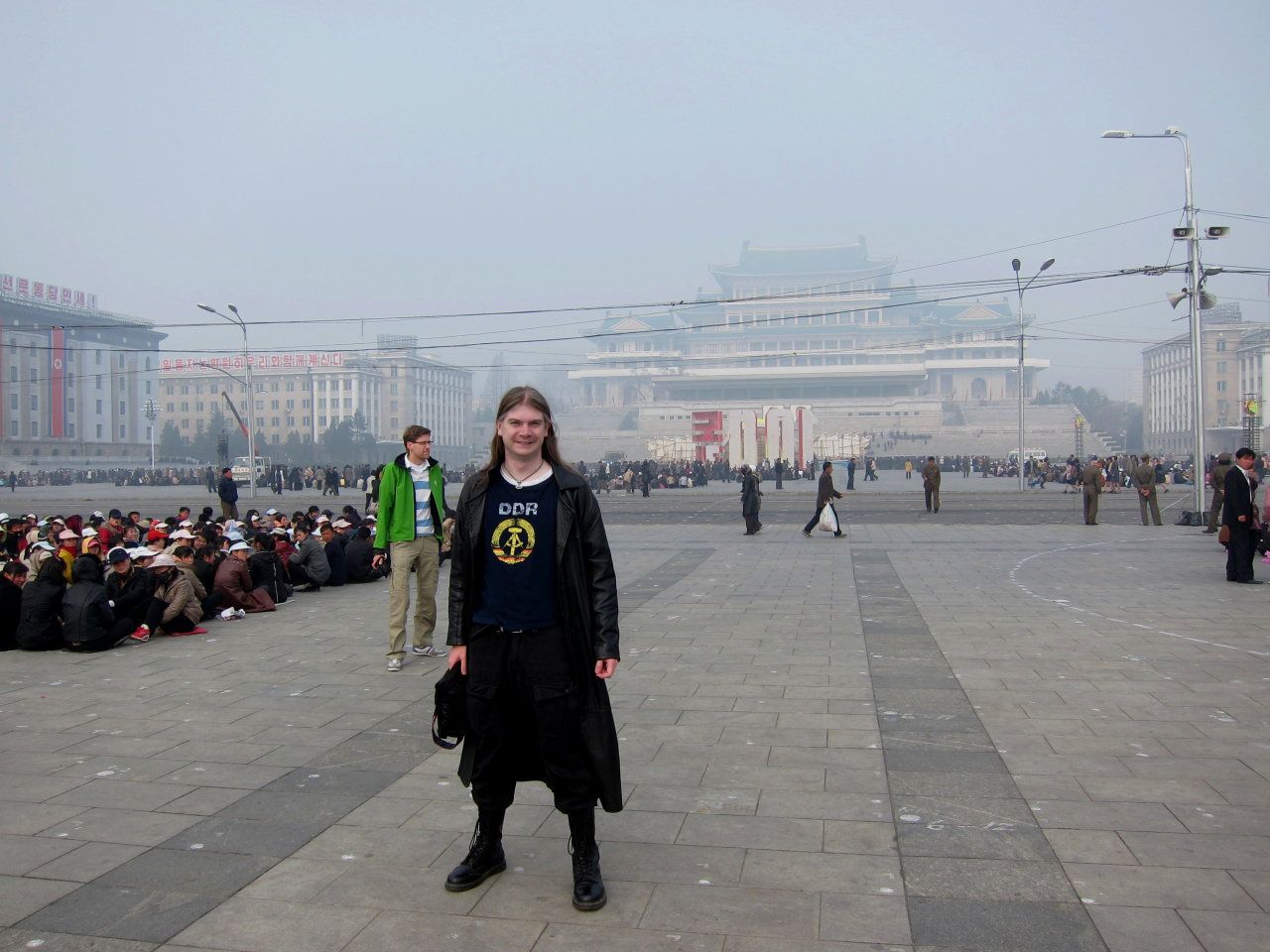
Rockin' the Deutsche Demokratische Republik (the old East Germany) shirt I'd bought at Checkpoint Charlie in Berlin, much to the amusement of the two Germans in our tour group. The lines drawn on the ground are marks similar to what stage actors would be given, telling the people where to stand. It's often been said that Pyongyang is less like a functioning city and more like a film set filled with actors playing their part in the regime's real life propaganda play, and at moments like this you can almost believe it.
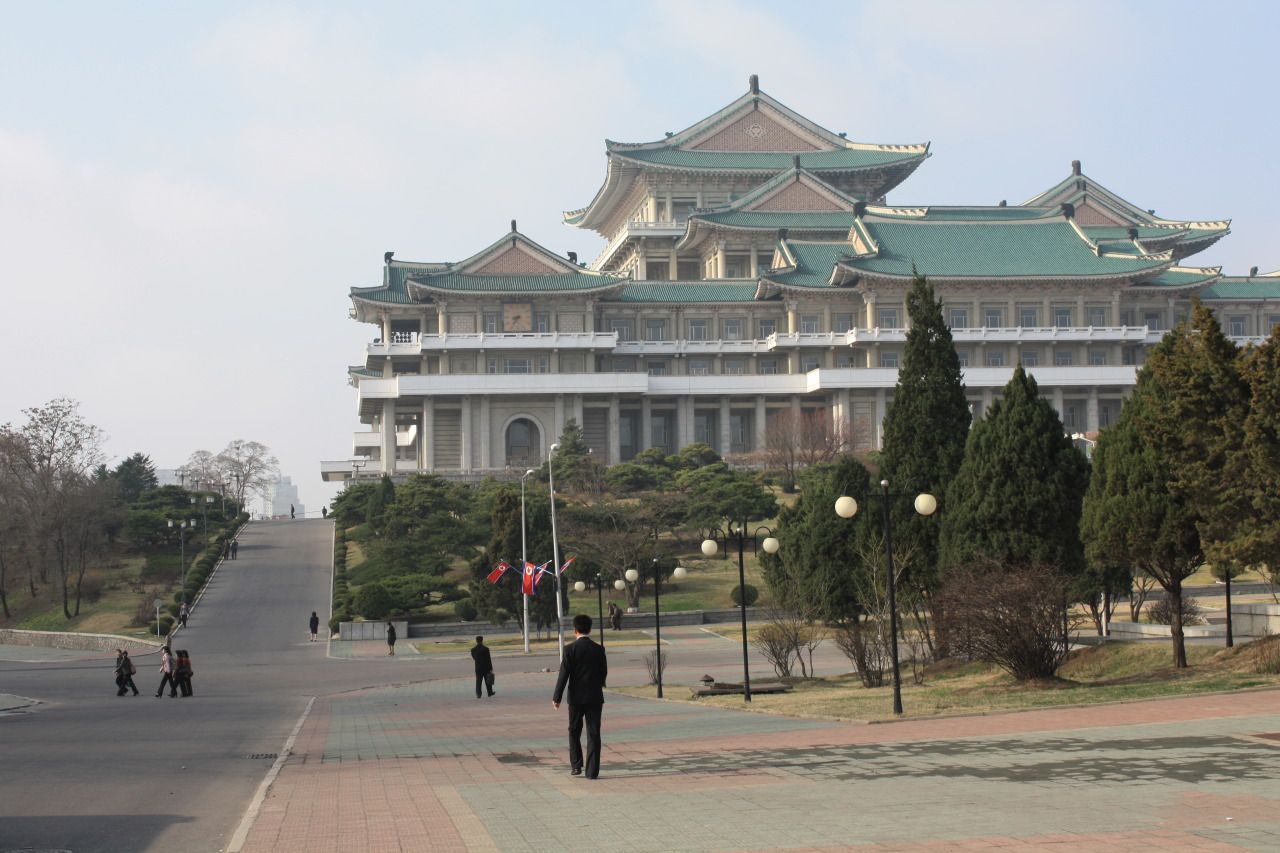
This faux-ancient Korean palace is actually the Grand People's Study House.
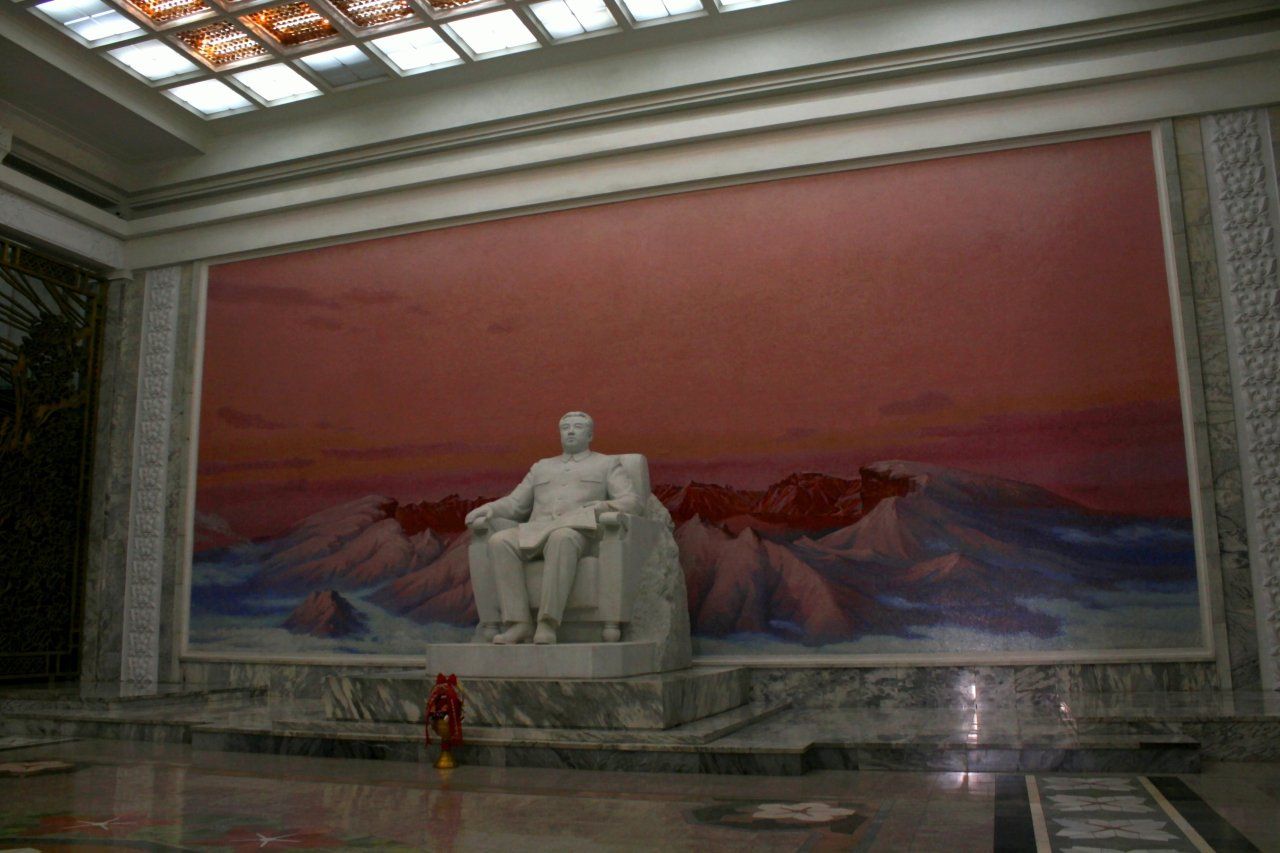
It's supposed to be sort of a communal library/school where anyone can come to study and take classes, but like everything in North Korea it is really just an immense shrine to Kim Il-sung. Rather than being in some crypt at the centre of an imperial tomb, this is the first sight that greets you as soon as you step through the massive front doors.
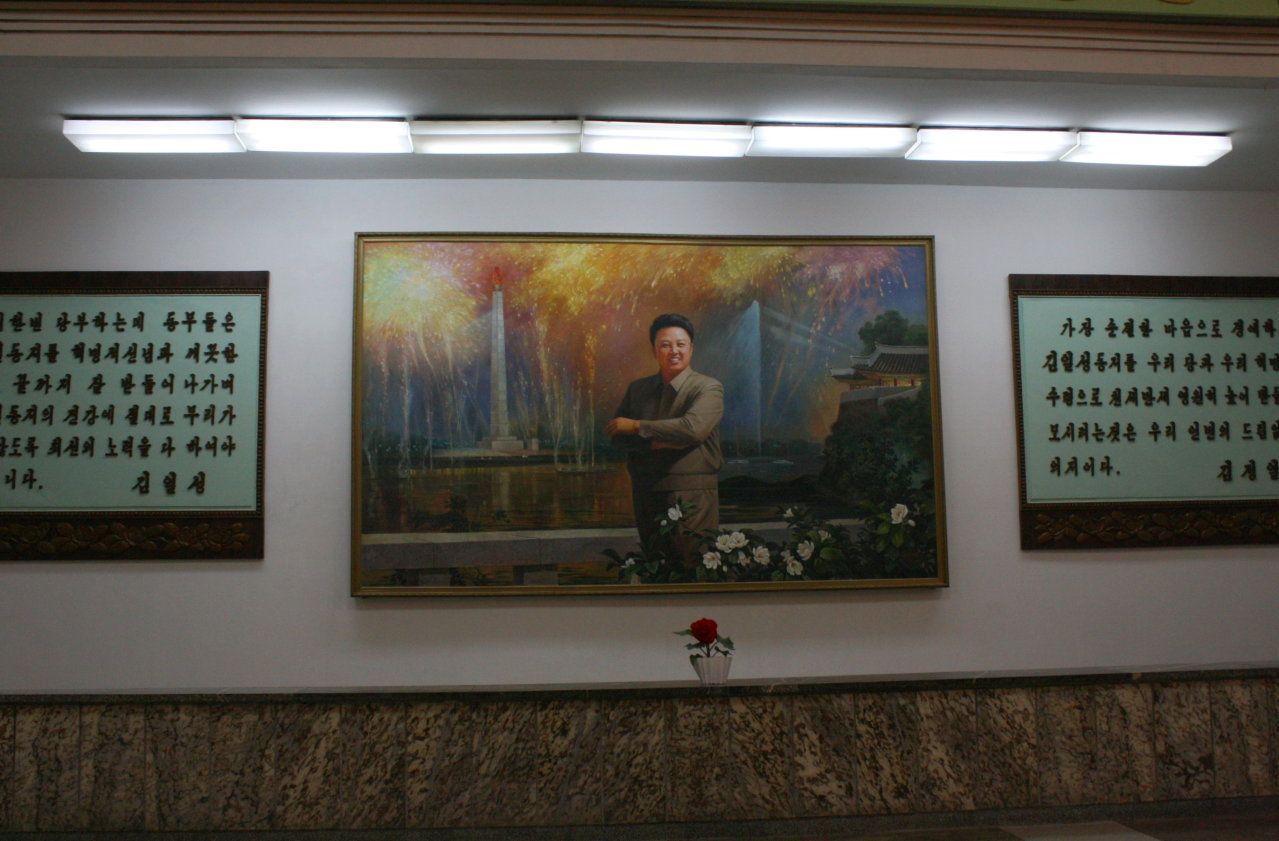
Not to be overlooked, this subdued and tasteful portrait of Kim Jong-il gets a prime spot on the wall just up the escalators from the statue of his father.
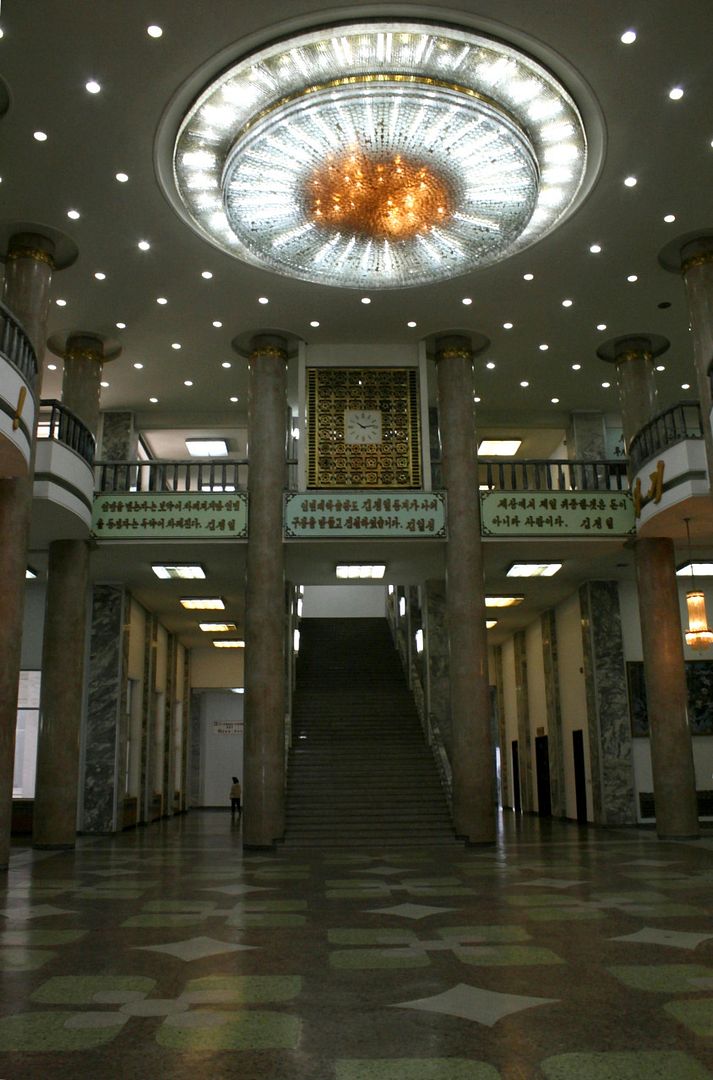
It is claimed the building is capable of holding 30 million books, and while it's certainly large enough to do so, most of the interior space is taken up with huge empty lobbies such as this one and long, dimly lit, corridors where cold marble meets rising damp.
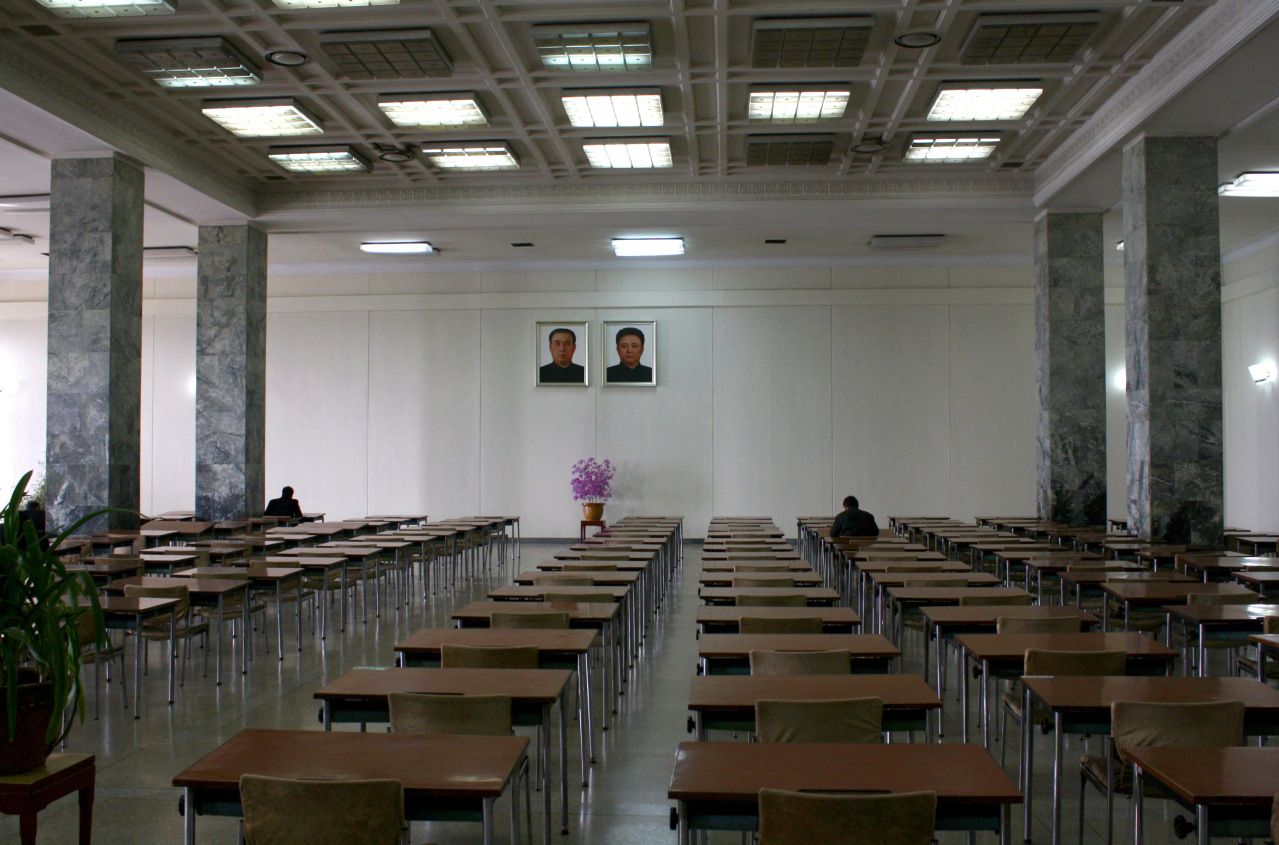
After being led past dozens and dozens of locked doors we were finally allowed into one of the rooms they permit visitors to see. And this is it, a large and mostly empty room with a small number of books up the back and on the side, but mostly taken up with special desks that Kim Il-sung ordered made as he declared it's easier to study when you can adjust the angle of your desk. Therefore the room is not really about leaning but rather a tribute the industrial design genius of Kim Il-sung.
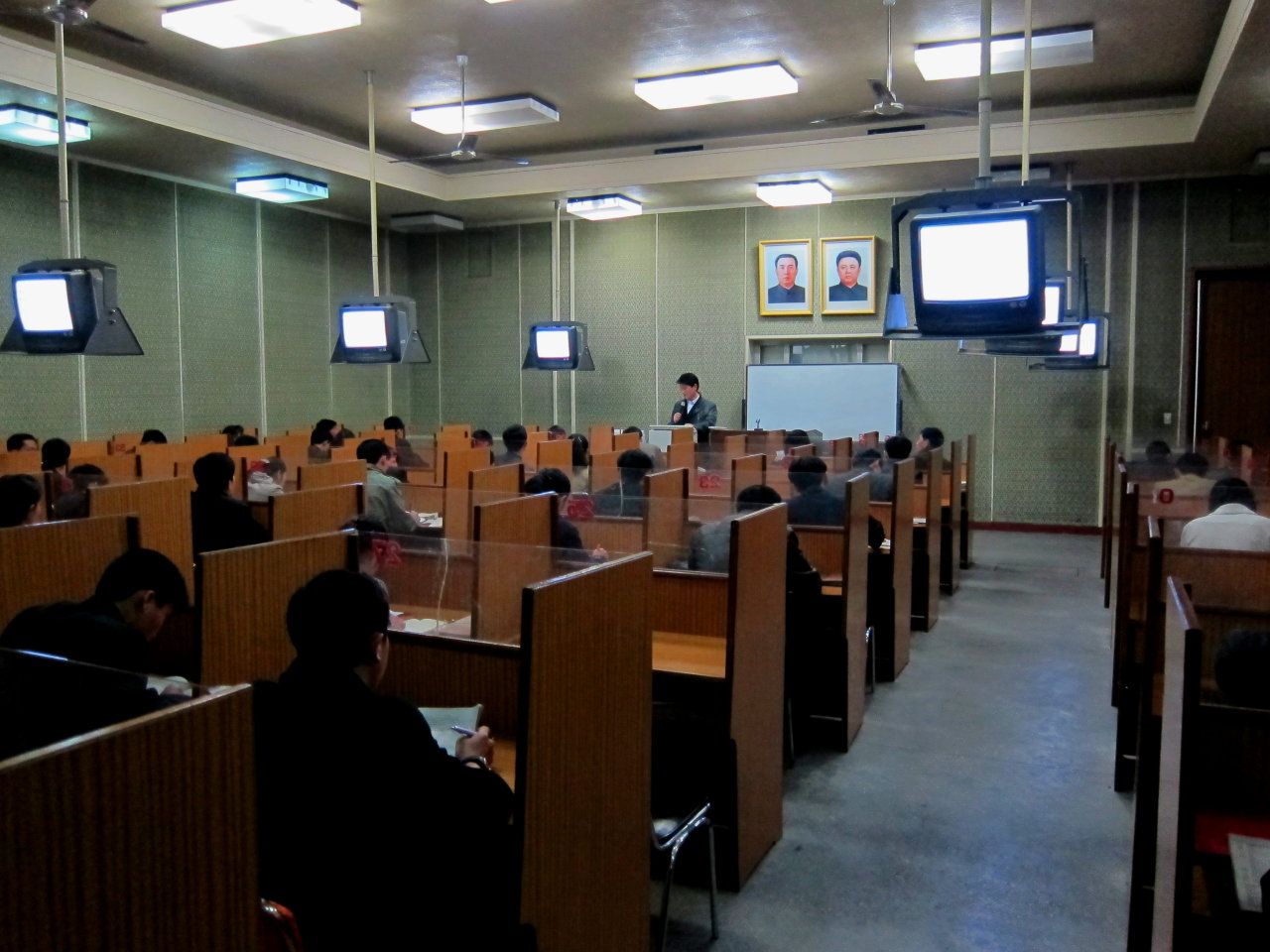
The next room we were taken to was even stranger. Apparently an English class, when we walked in the students were being instructed on how to spell and pronounce the word “walkman”, not something that would be very useful in the West, not that they could ever go there anyway. The type of teaching seemed to be nothing more than call and response rote learning, and despite repeated assurances that anyone could come to the Grand People's Study House and learn, one gets the feeling this was put on only for the tourists benefit and that once we'd all left for the day these people would have been hurried back to their work assignments. While traipsing around the endless echoing hallways I tried to quiz Miss Jong on how the place worked and if she ever came there to study. While normally bursting with information about all things Pyongyang, she became rather evasive and her vague answers about coming here to relax did not ring true to my perception.
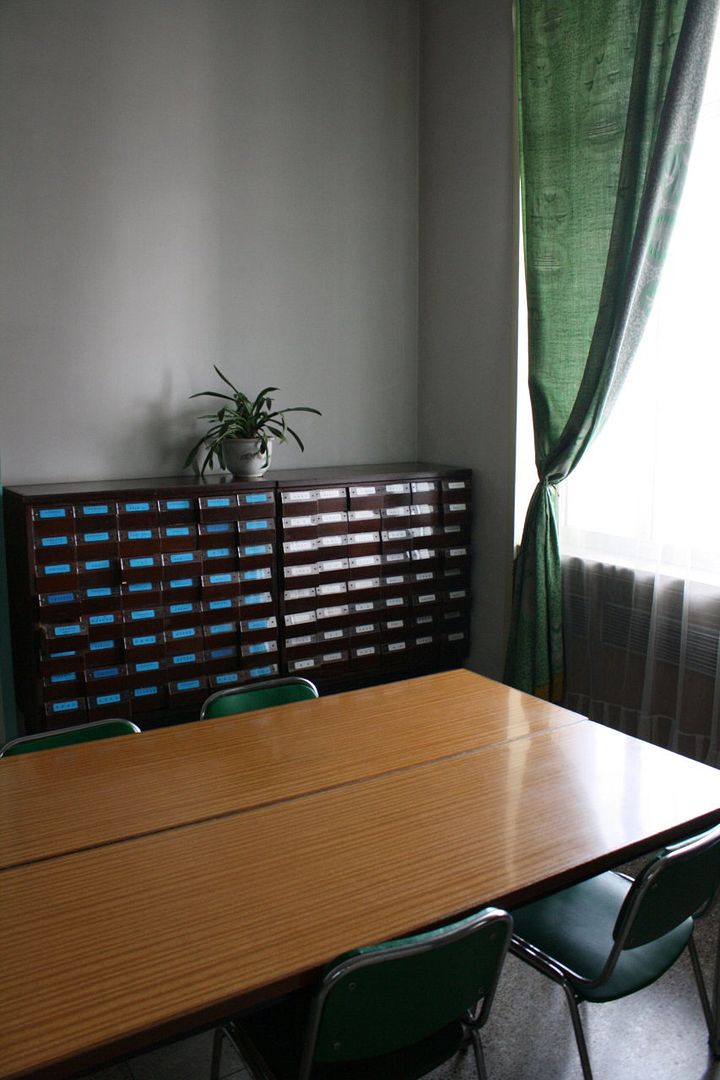
After visiting a professor who claimed to be an expert on North Korean social sciences who you could ask anything (no one could think of a question, which is what they both expect and desire) we went upstairs to a music room, which was full of cassette and CD players. They put on some Beatles for us, but you can't imagine the locals would be allowed to listen to such degenerate Western noise. Not particularly impressed by a song I'd heard thousands of times before I wandered around to look into corners of the room Despite the massive size and liberal usage of marble found in these monuments to the Kim dynasty, there remains a sort of communist cheapness that is found in every building along with the omnipresent smell of stale cigarette smoke and boiled cabbage. For example consider this furniture which looks like it was rescued from a skip outside a recently closed high school in the 1970s, it's clear they spent most of the money on statues and paintings of the Leader leaving very little for everything else.
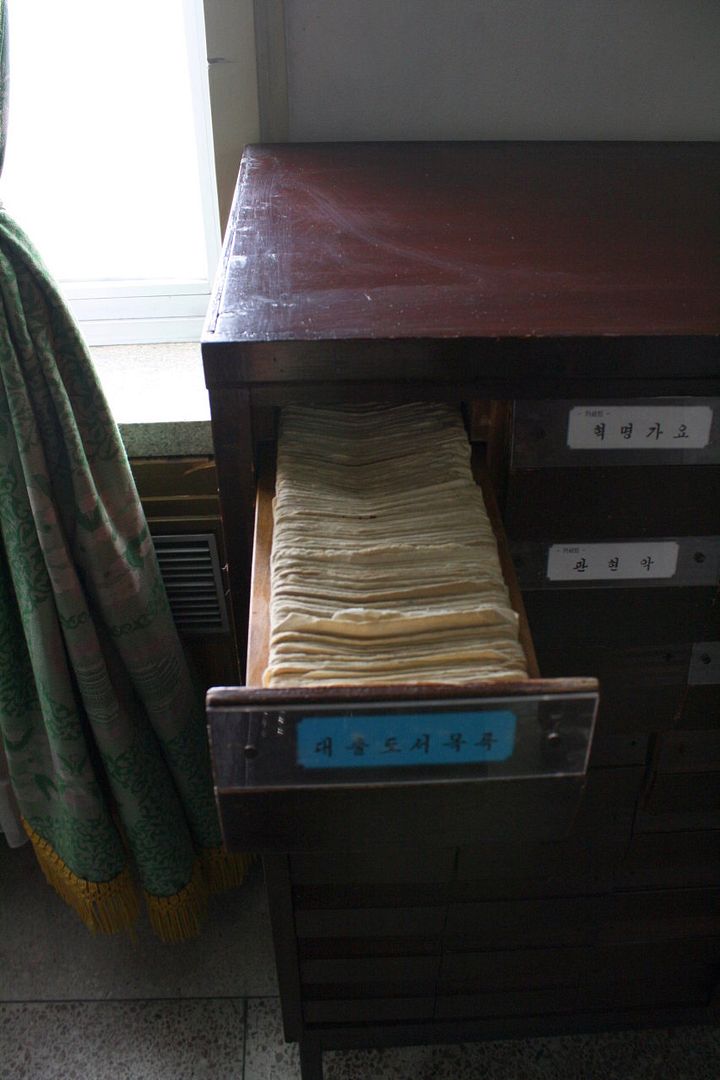
And when was the last time you saw a card catalogue in any sort of library? They had some computers running what looked like pirated copies of Windows 95, but given how little experience most North Koreans would have of computers it's doubtful they get much use.

We then caught a lift to the top floor which provided magnificent views of the ongoing preparations in Kim Il-sung Square. Pity about the smog, but that's what you get for having a coal-fired power plant near the centre of town.
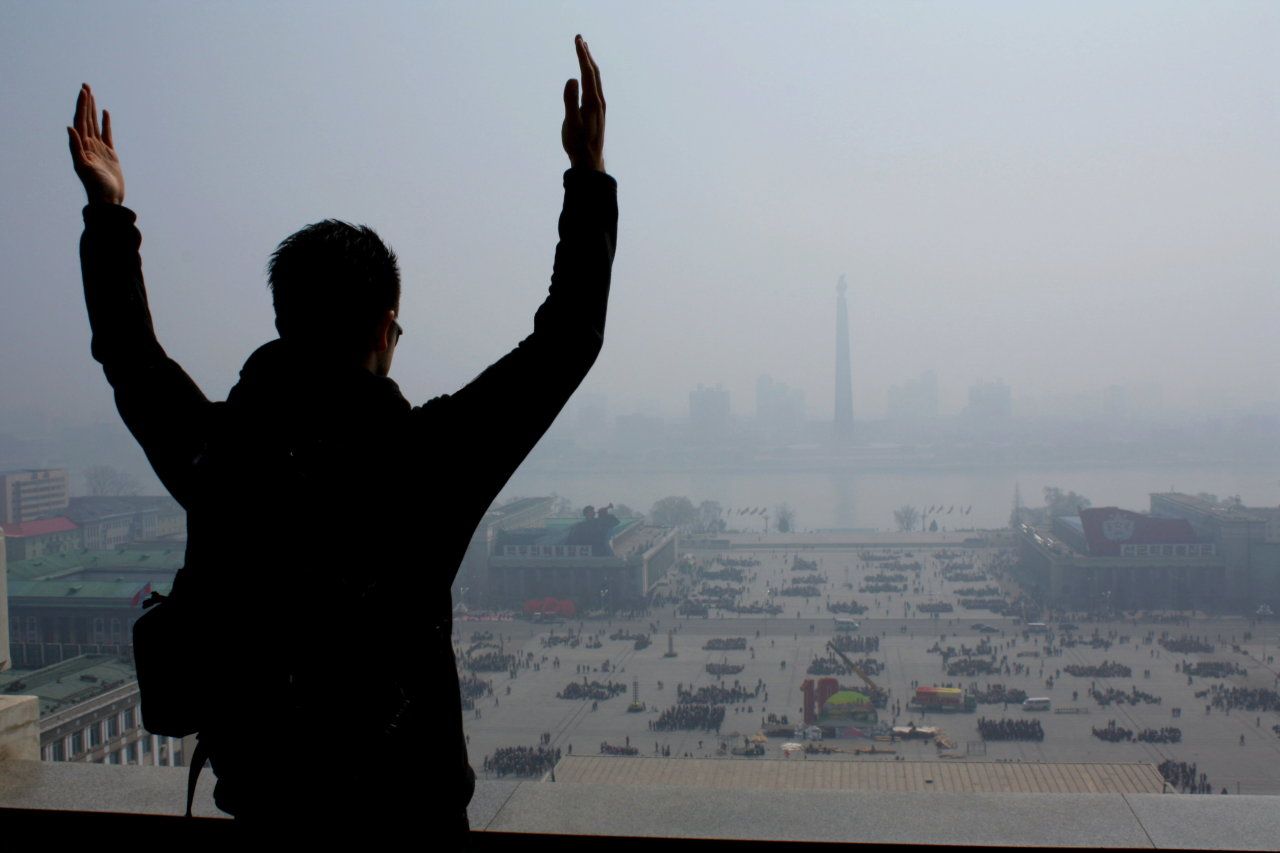
Ash, the great communist dictator acknowledges his loyal subjects.

Back in the square and the people (who were just Pyongyang locals who were drafted into the performance) were now practicing their synchronised movements.
Being surrounded by thousands of people all moving as one like the in the famous North Korean mass games was an incredibly surreal experience that hopefully this video Ash took conveys.

The Tower of the Juche Idea. Juche is the guiding philosophy of North Korea, first articulated in the mid 1950s that had by the 1970s almost totally eclipsed Marxist-Leninism as the official state ideology. Put simply it's a mixture of economic autarky, quasi-fascist and militarist hyper-nationalism with elements of traditional Korean traditionalism thrown in for good measure. At 170 metres tall the tower is a satisfyingly petty 80cm taller than the Washington Monument. Unfortunately it was closed when we were there as normally it can be climbed for peerless views of Pyongyang. Opened on Kim Il-sung's 70th birthday in 1982, each of the 25,550 bricks used in it's construction represents a day in the life of the Great Leader.
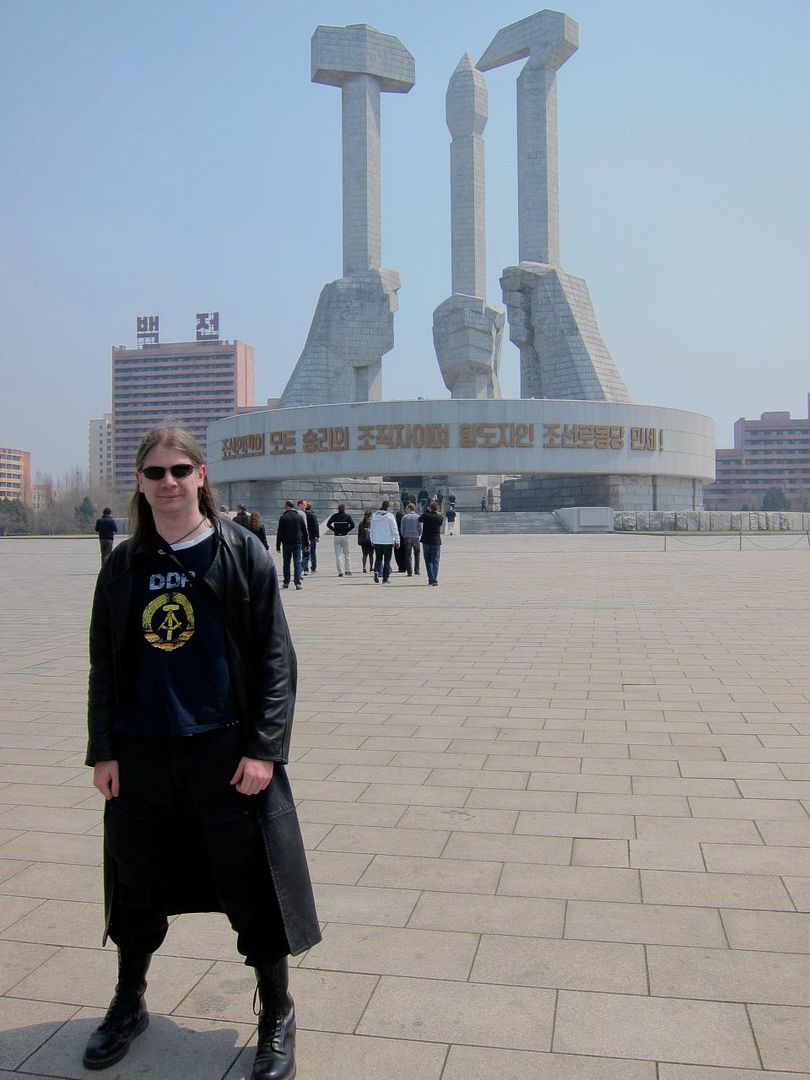
Still, never mind. Up next was Monument to the Party Founding, unveiled in 1997 as a celebration of 50 years since the foundation of the Workers Party of Korea in 1947. Apparently signing off on the design of this monstrosity was one of Kim Il-sung's final actions before his death in 1994. In addition to the stylised hammer and sickle representing the worker and the peasant, the party also added a paintbrush to represent the “working intellectual”.

Opinions on the subject vary, however this must be a candidate for the most hideous structure ever erected by mankind. I think it's brilliant.
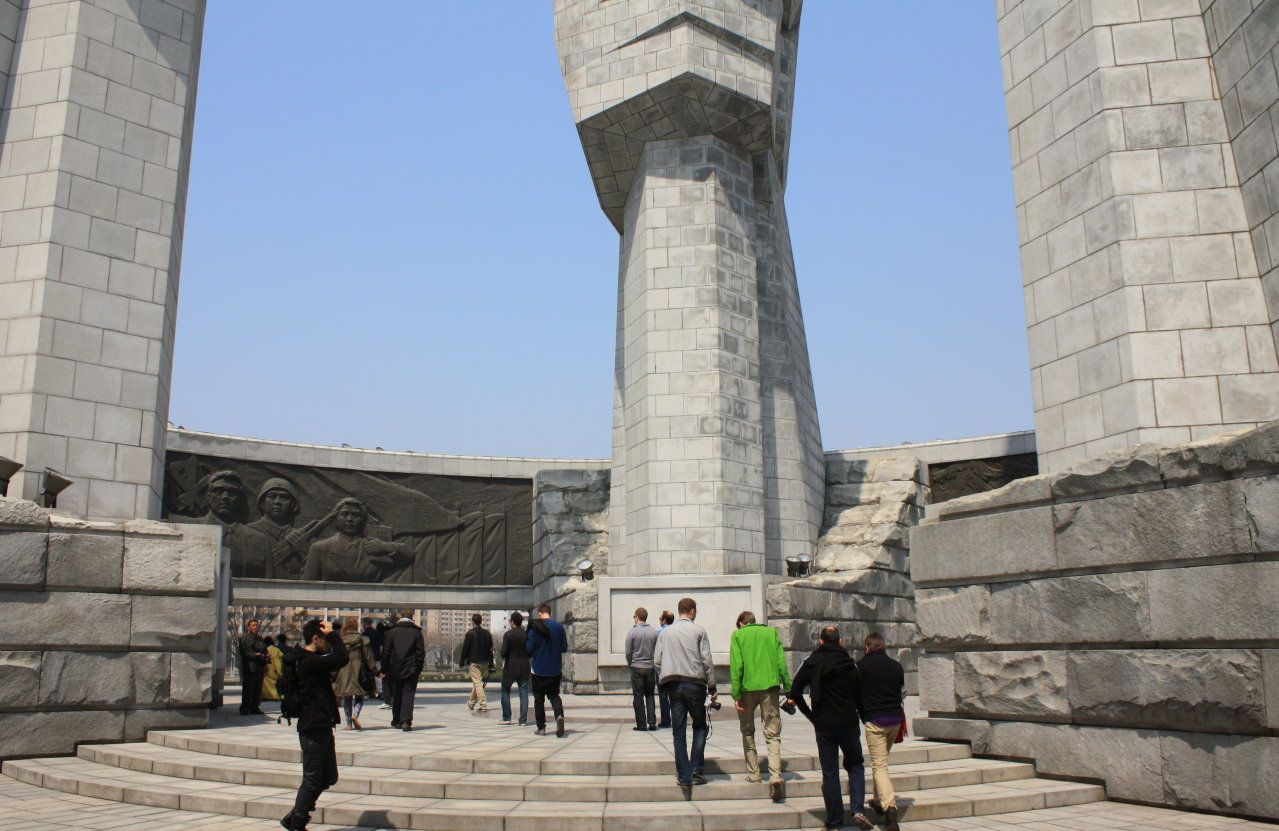
Each of the towering hands gripping their respective tools are 50 metres high to signify 50 years since the founding of the party.
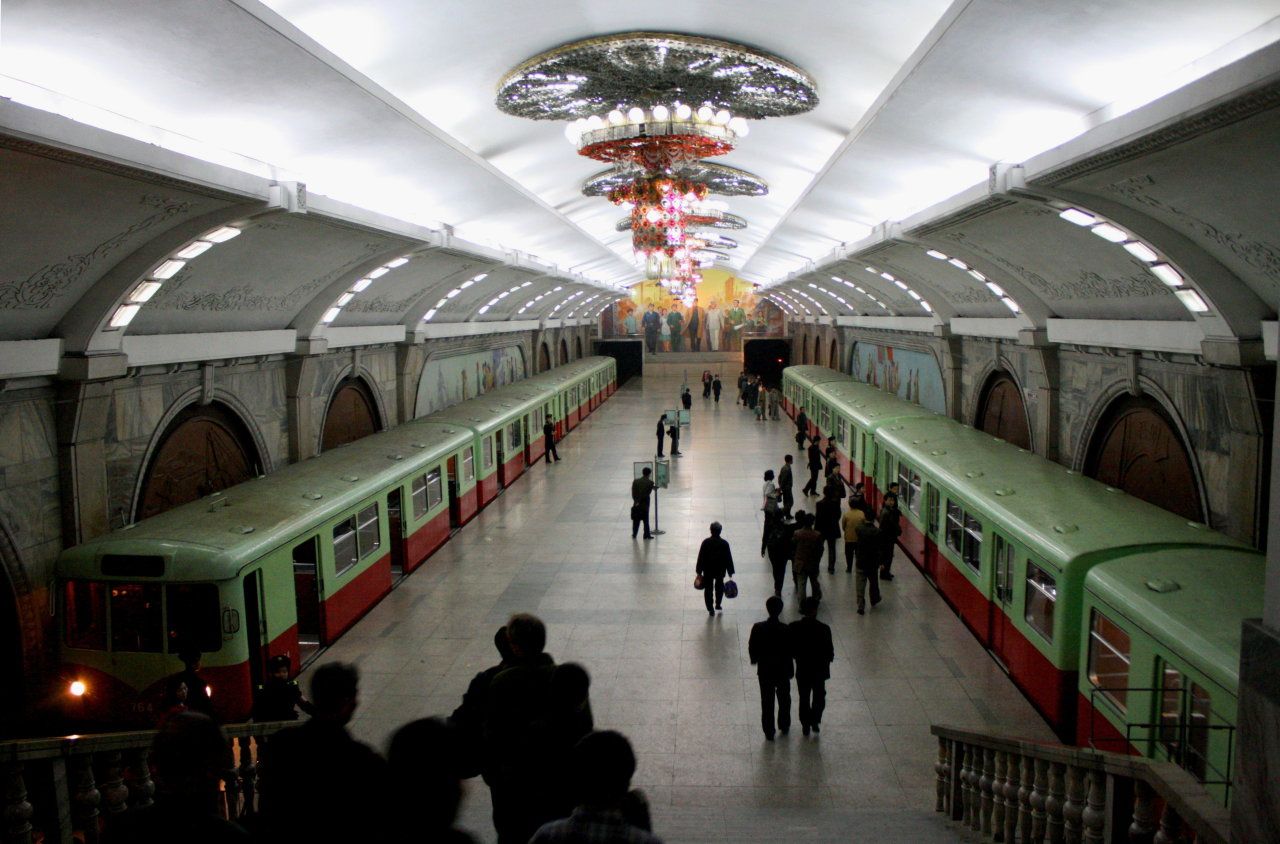
After lunch we got to ride on the famous Pyongyang Metro. Allegedly the deepest underground network in the world, like the Moscow Metro on which it's based it was designed to double as a fallout shelter in the instance of a nuclear strike. As with the Moscow system many of the stations are stunning works of art in their own right.
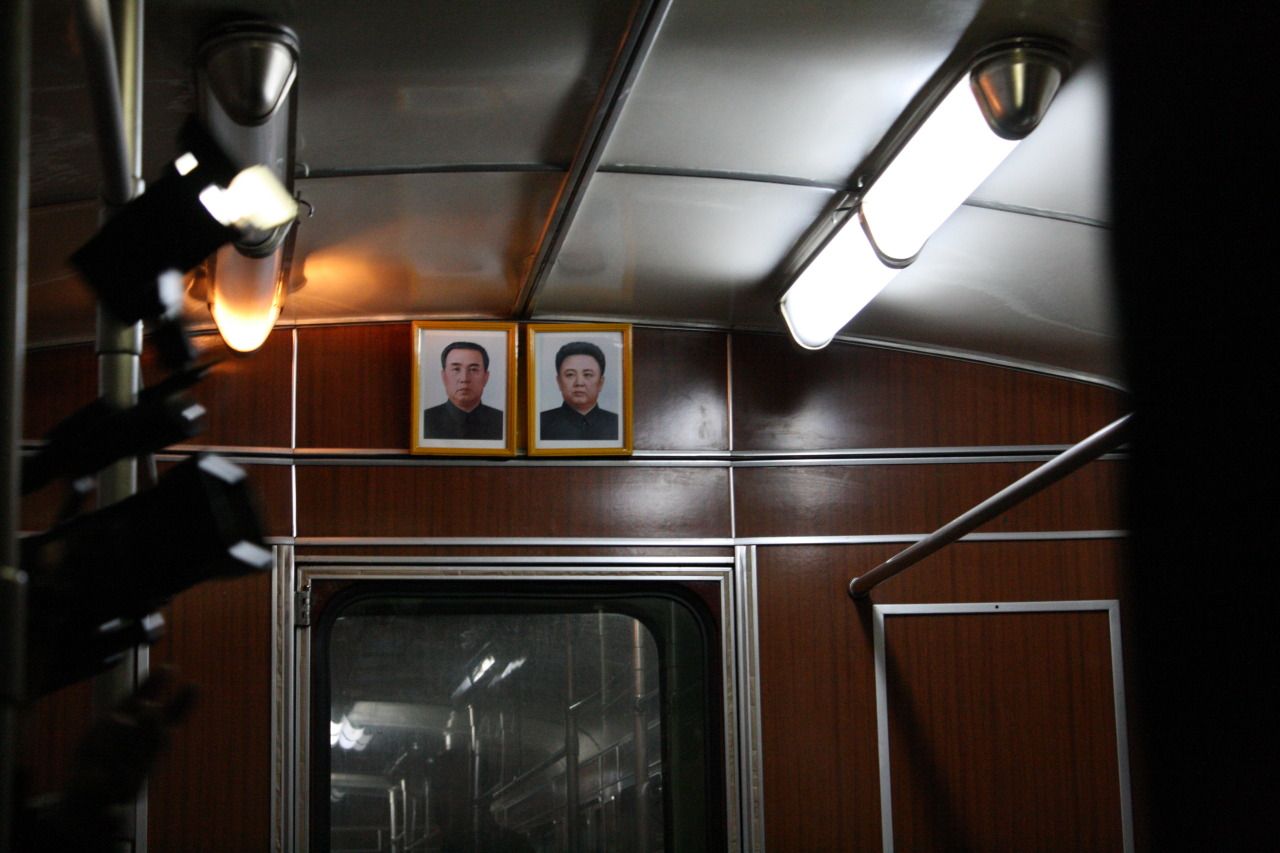
Like the trams on the streets above, the Metro's rolling stock was built in the former East Germany and after years of shunting around the former East Berlin, was sold to the North Korea after the Berlin Wall came down. Despite claims to the contrary, the only domestic work done on the trains was the addition of these portraits.
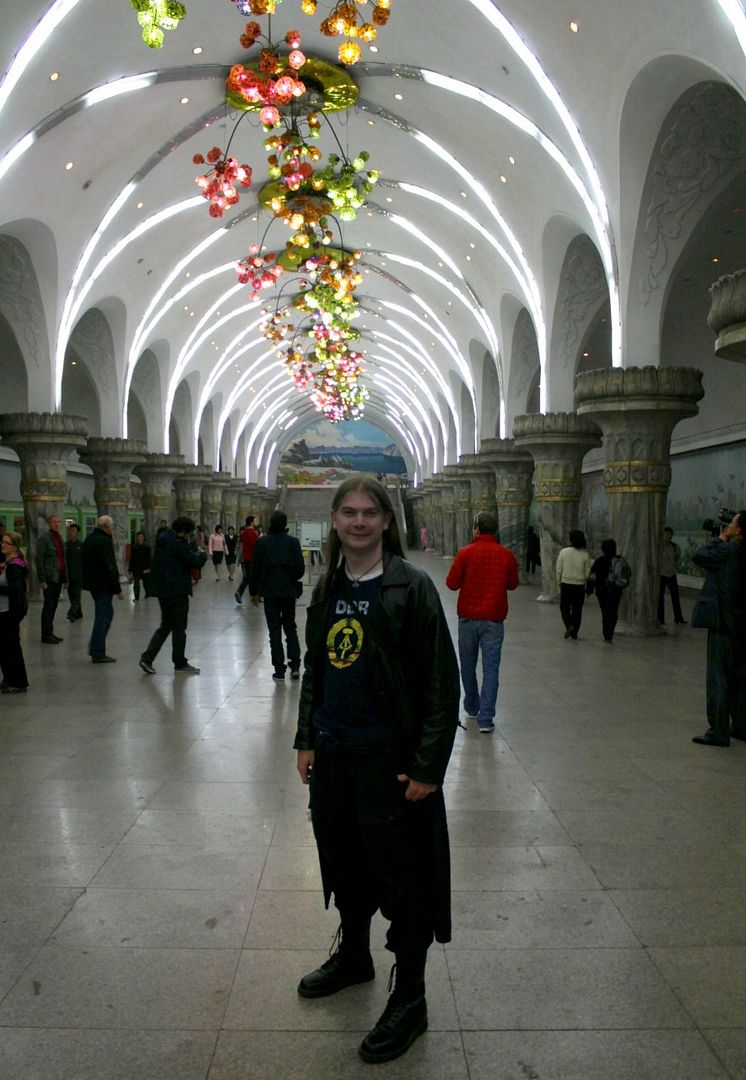
The first station photographed above is Puhŭng or Revitalization and this is Yŏnggwang or Glory. All the stations have names like this, I would have liked to have visited other stops such as Innovation, Red Star, Comrade and my favourite: Complete Victory (In Battle).
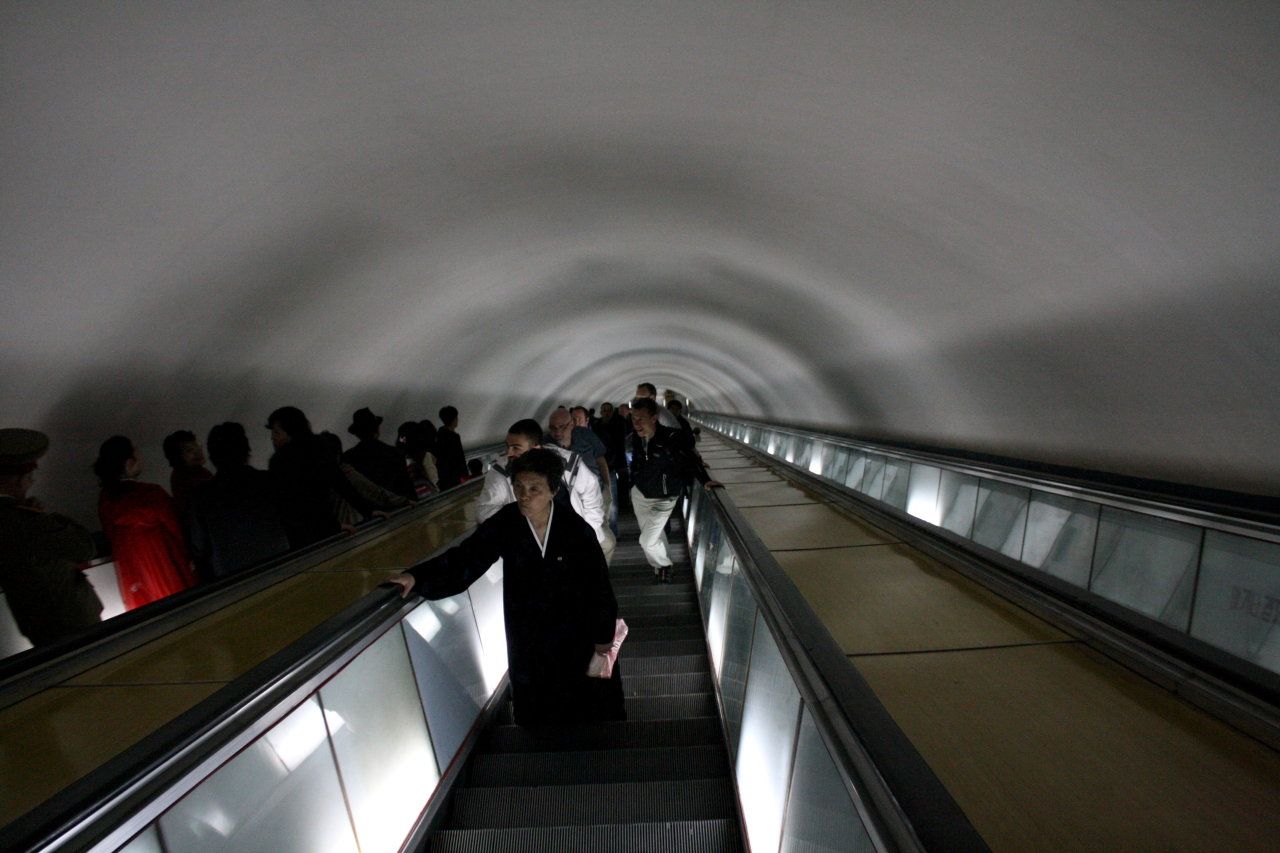
The escalators are more than 100 metres in length seemed to take forever to finally return us to the surface.
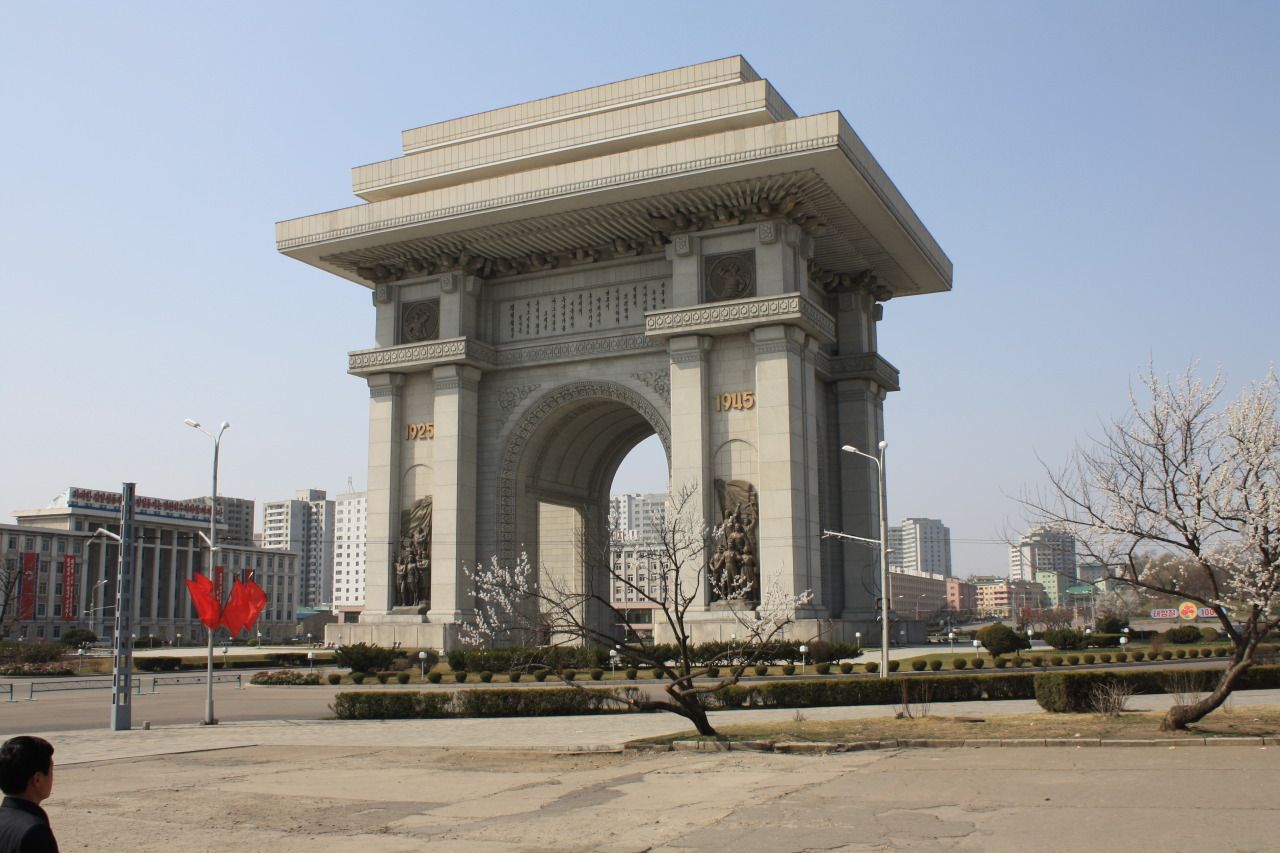
The Arch of Triumph, naturally modelled after the Arc de Triomphe in Paris but as with the Juche Tower a deliberate 10 meters taller. Also completed in 1982 on Kim Il-sung's 70th birthday and again constructed of 25,550 bricks, it was built to celebrate Kim Il-sung's leading role in the defeat of the Japanese in 1945. Once more the deeds of all others are rendered inconsequential compared with those of the Great Leader and the real reasons the Japanese were forced out of Korea go unmentioned.
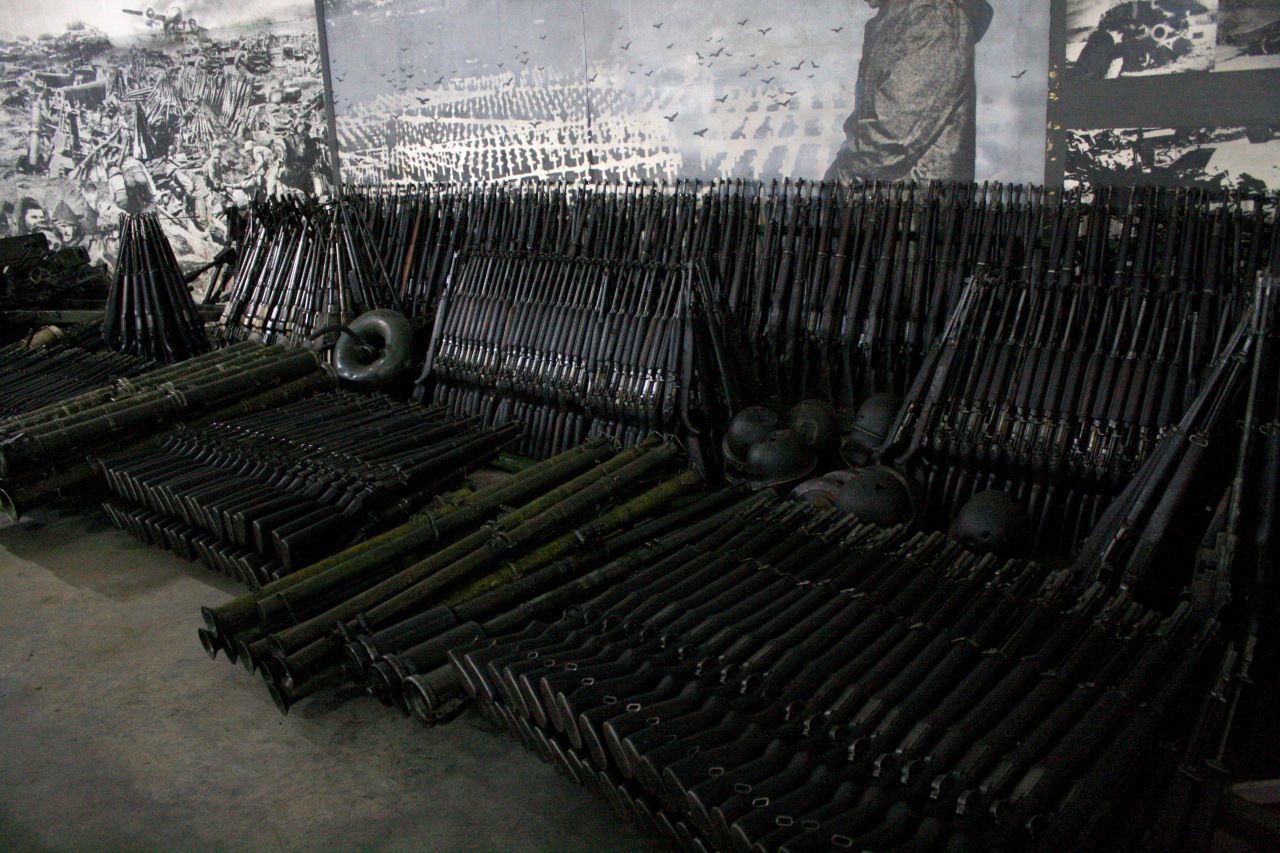
Continuing this theme our next destination was the clunkily-named Victorious Fatherland Liberation War Museum, where one can learn more about Kim Il-sung's almost single handed defeat of the Americans this time, during the Korean War. Here is a small part of the massive collection of weapons and vehicles the Korean People's Army captured off the UN forces.
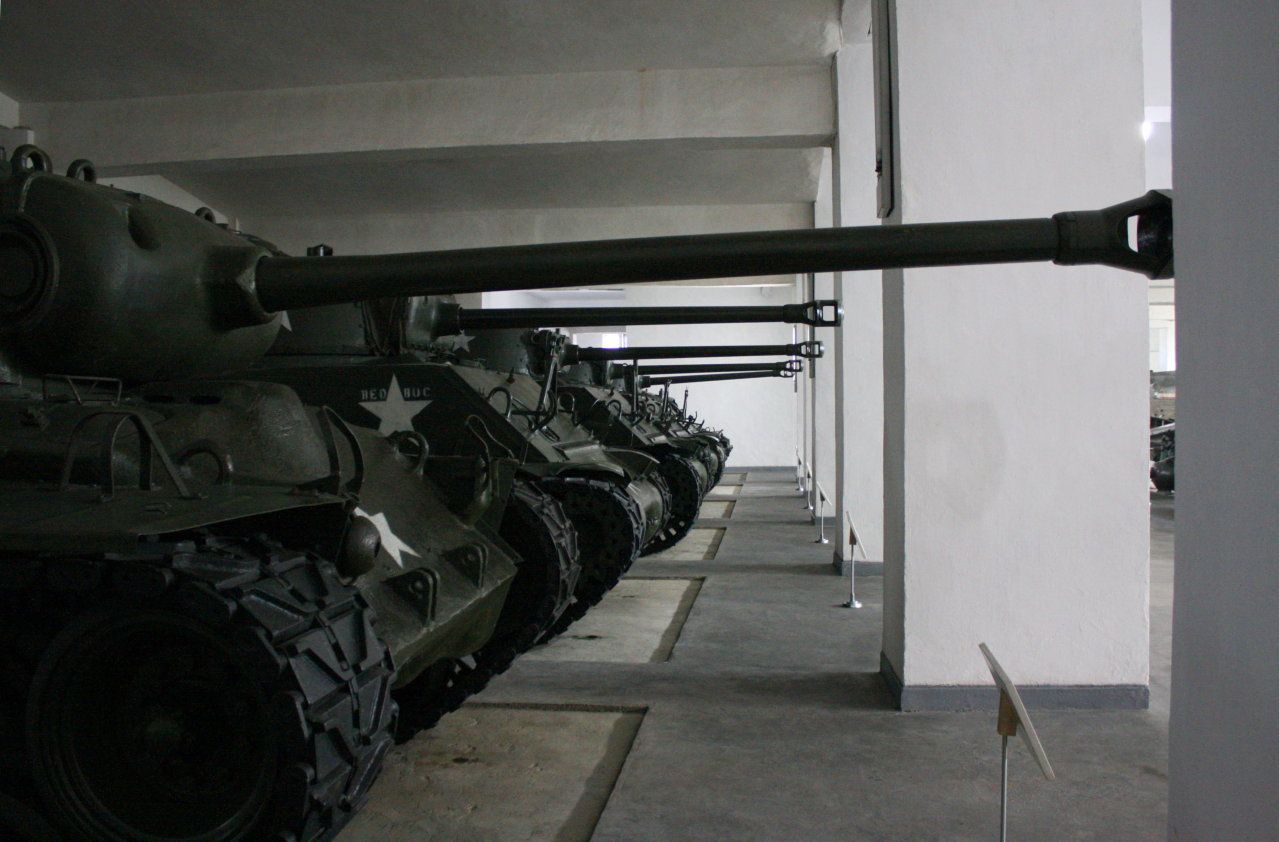
Captured American tanks.
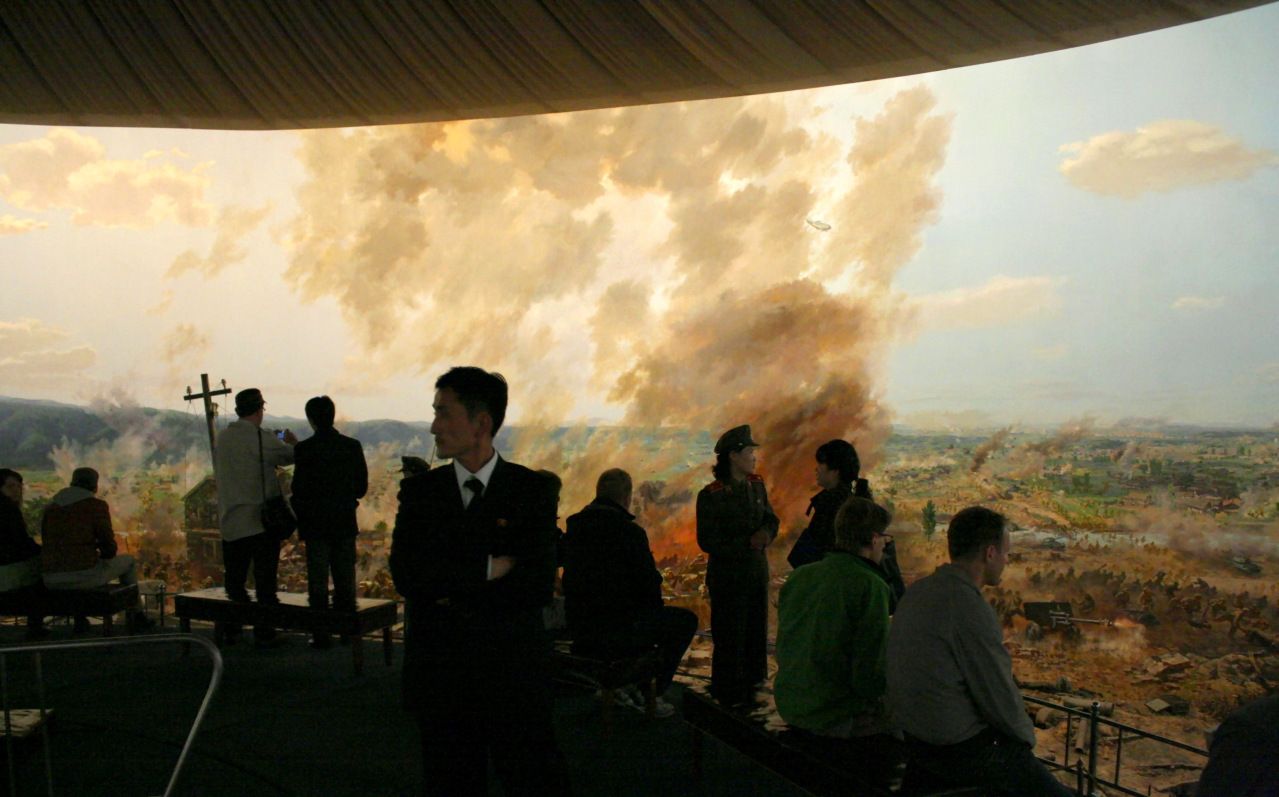
A 360 degree panoramic painting/diorama showing idealised scenes of North Korean victories and American defeats. Not shown or mentioned anywhere, the USSR and China who contributed more to the war's eventual outcome than you know who.
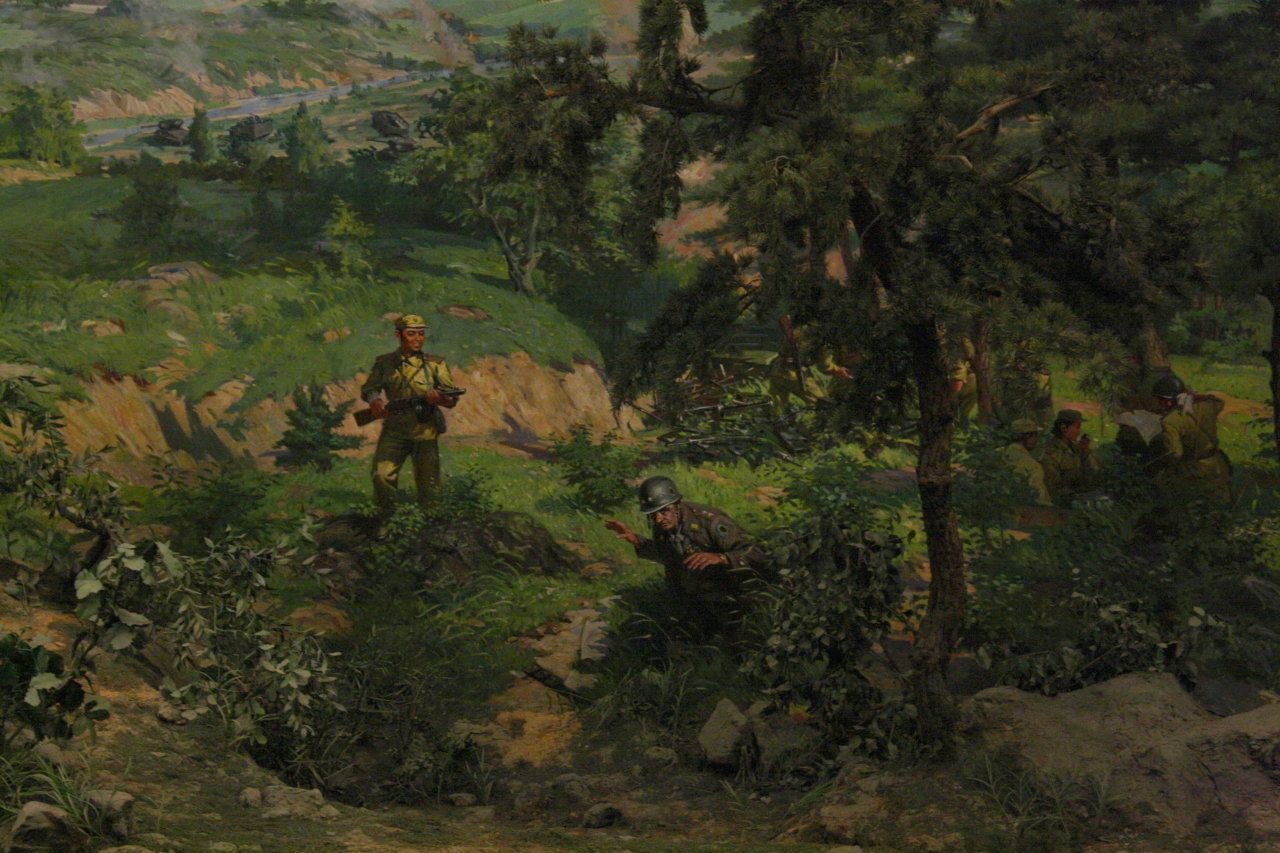
My favourite scene from the painting, here we can see a cowardly American general cowering behind a bush in a humiliating surrender while a laughing DPRK soldier comes accept it.
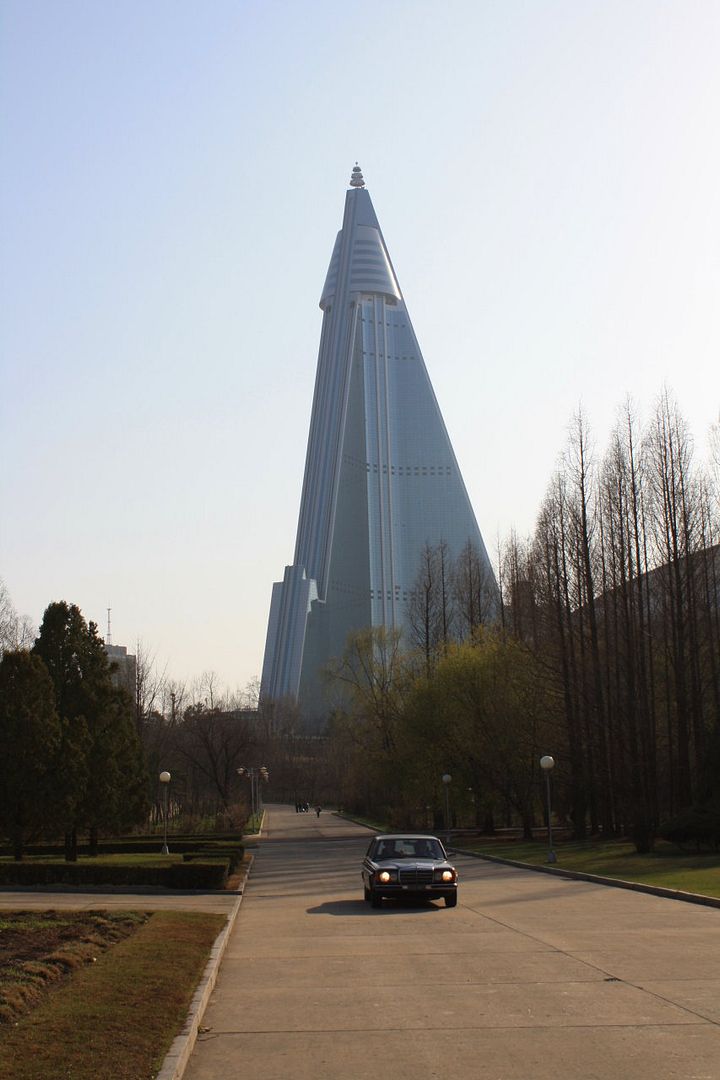
The museum is located not far from the famous Ryugyong Hotel, also known as “the worst building in the world” and sometimes “the hotel of doom”. When construction began in 1987 it was intended to be the tallest hotel in the world, and it would have been had the country not run out of money in 1992 after the collapse of North Korea's largest trading partner/benefactor, the USSR. With no funds available to resume construction the incomplete structure stood as a colossal monument to the failure of communism, and the regime responded by airbrushing it out of propaganda photos of Pyongyang, no mean feat considering it's 330 metre height. In 2009 an Egyptian company won the contract to finish construction and while progress has been made, rumours that it's opening would coincide with the celebrations for the Kim Il-sung centenary came to naught.
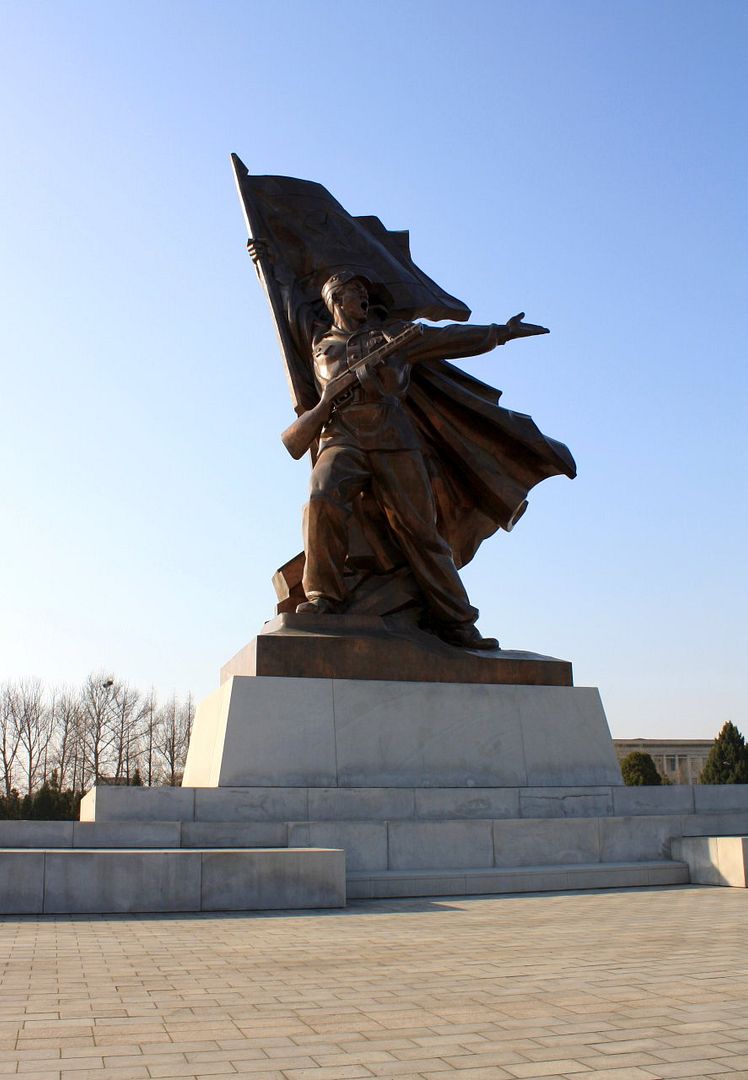
Socialist realist sculpture at it's finest. It's little wonder that African dictatorships are lining up to have statues of themselves made by North Korean artisans.
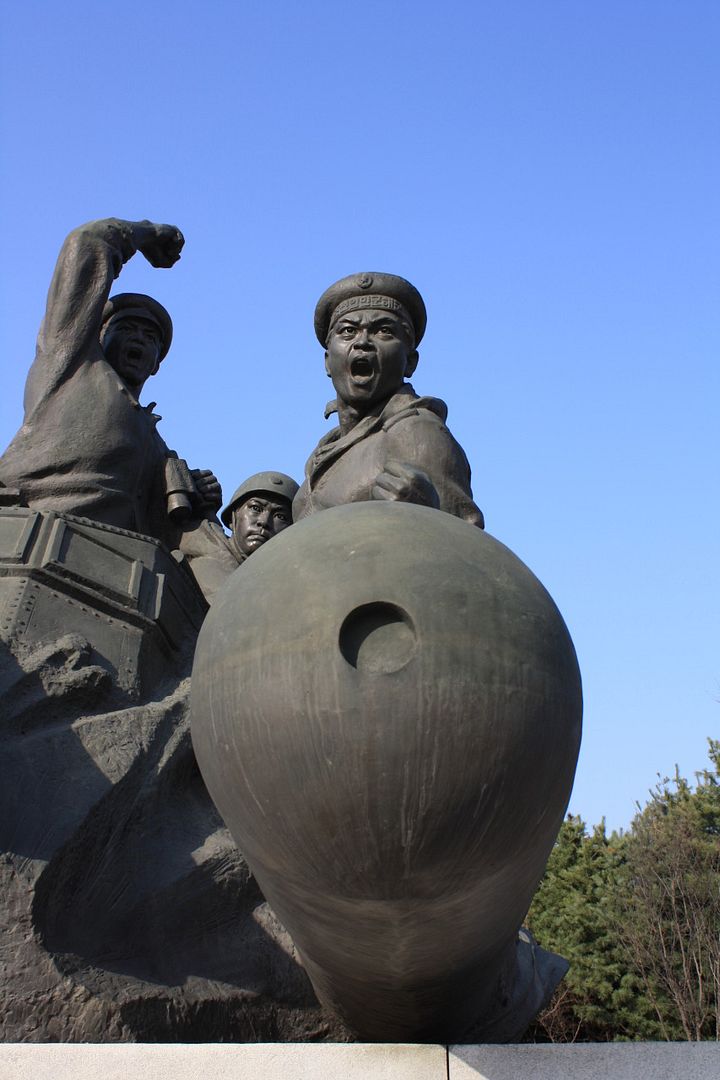
This and the previous picture were taken at huge war memorial next to the museum. Interestingly in all the Korean propaganda everyone seems to be yelling. Possibly about defeating the imperialists, or considering the subtext implied by my choice of angle here, maybe about something else.
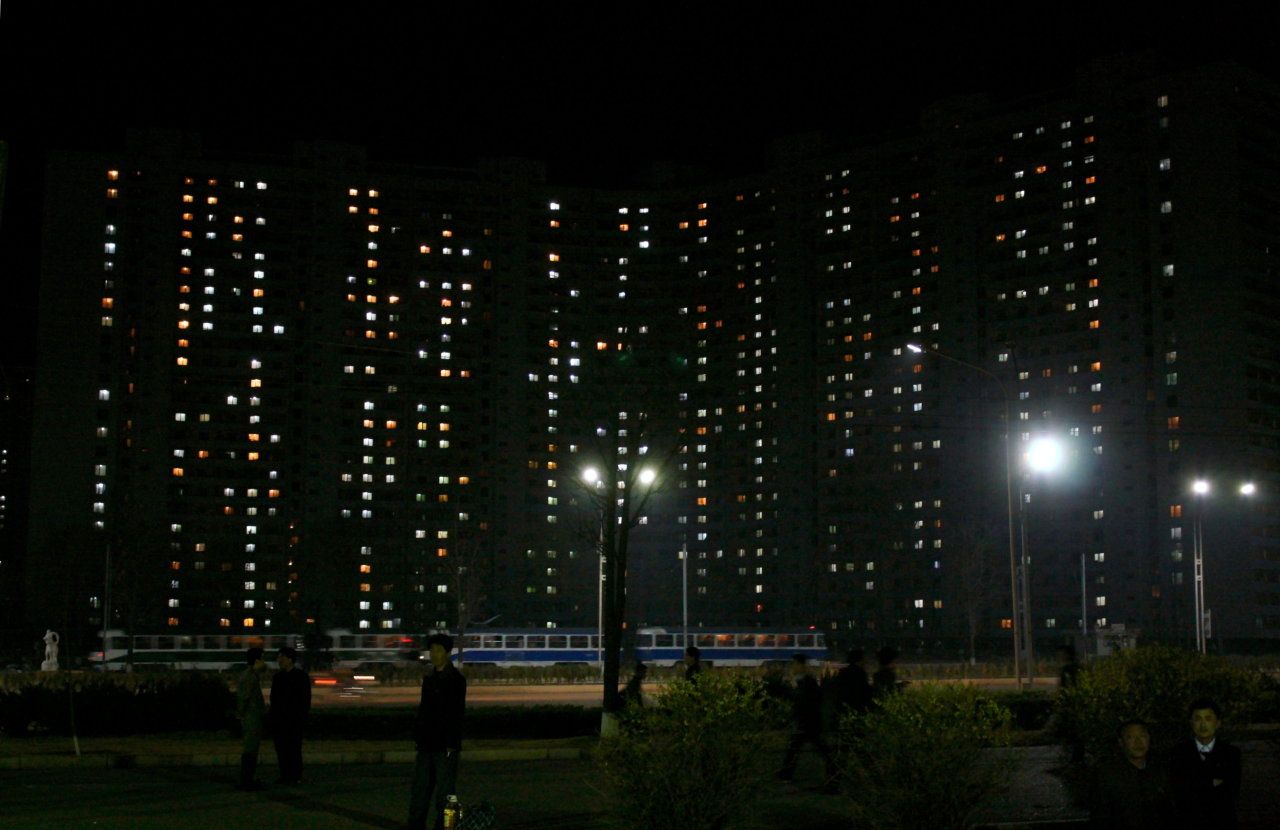
After a bit more of a wander around we enjoyed a delicious duck BBQ dinner. These monolithic apartment blocks lined the street outside the restaurant. Such structures are typical of communist countries, beloved for both their cheapness of construction and the less tangible ideological benefits whereby individual expression becomes difficult when everyone is living almost identical lives.
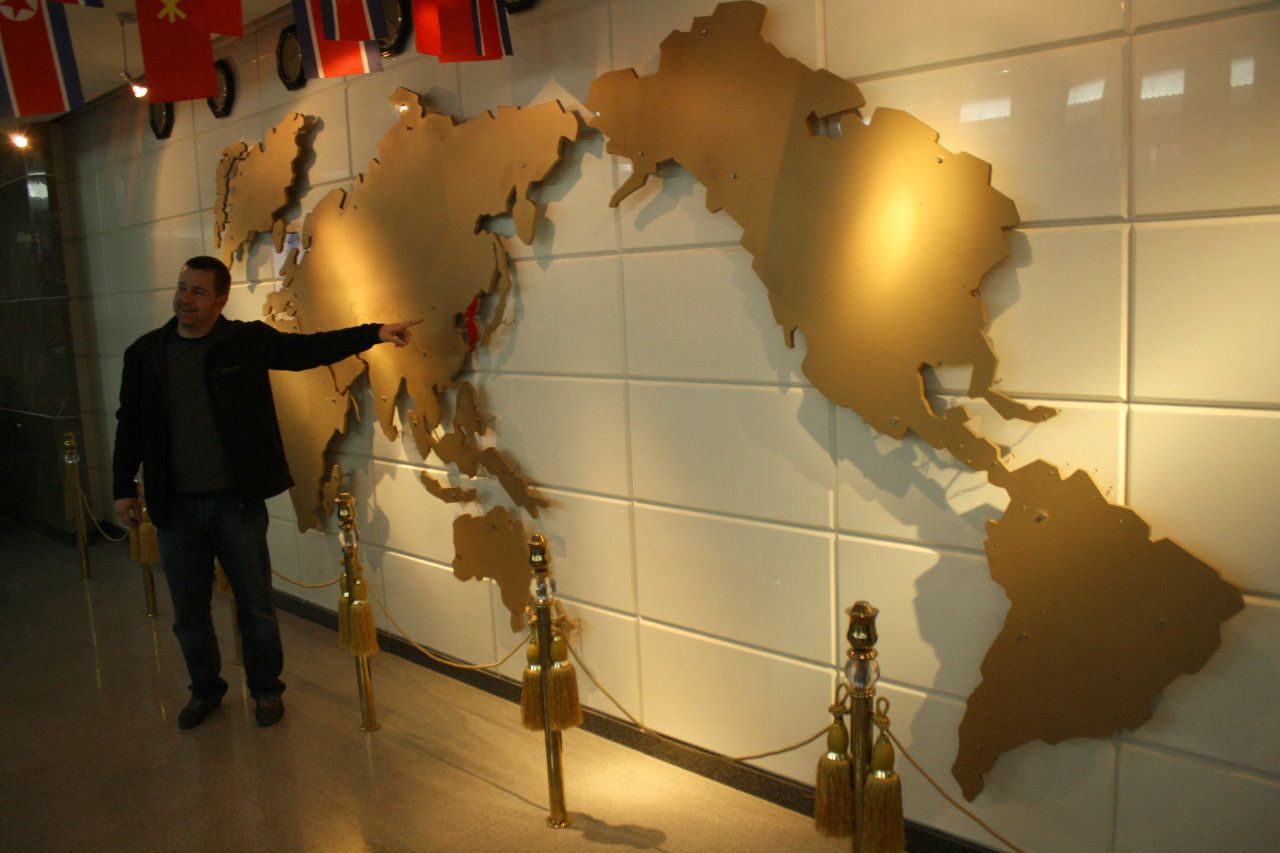
Then it was off to the Taedonggang Diplomatic Club or just “The Diplo” for short. Considered Pyongyang's hottest nightspot, although since it's only competition would be the front bars of the 6 hotels in town that may not be saying much. While the Korean peninsula may be rendered accurately on the wall of the foyer, sadly the same cannot be said for the rest of the world's geography.
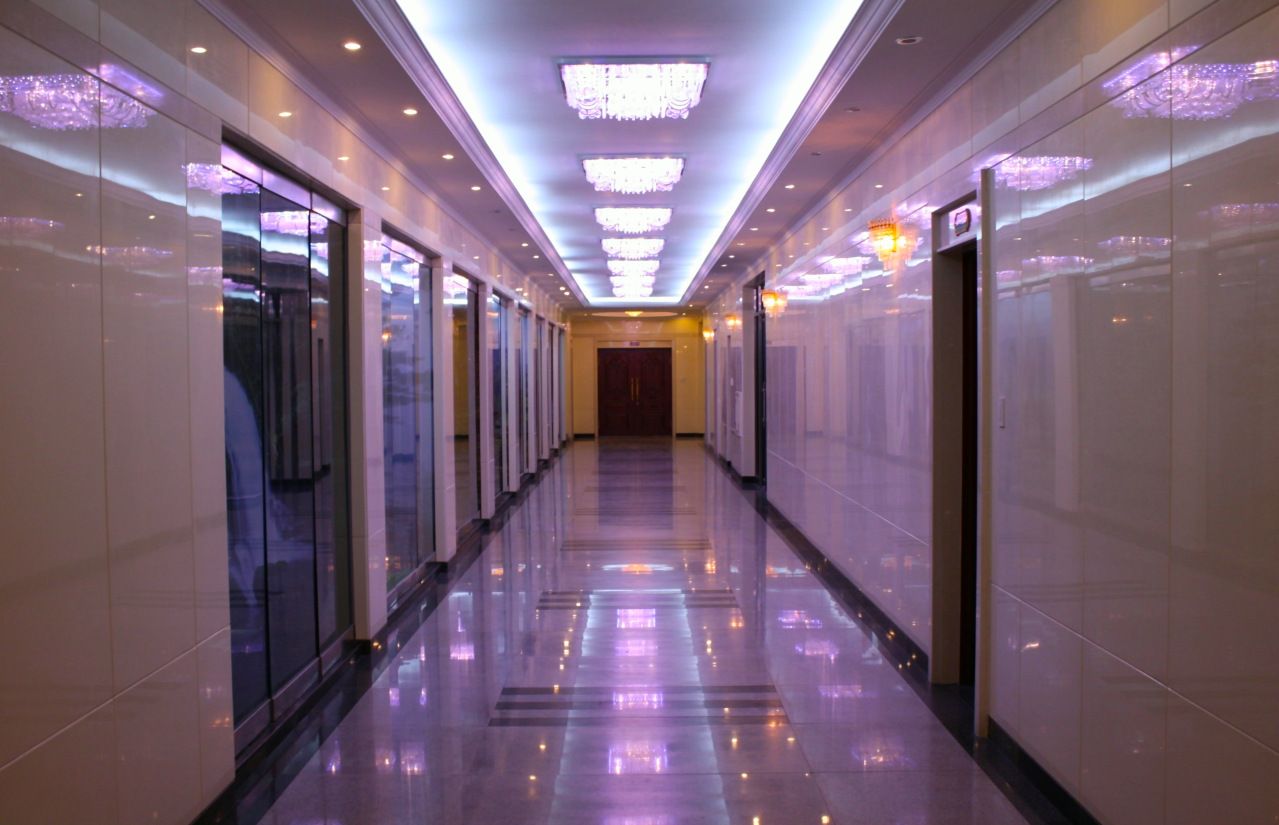
After the cold and austere buildings found everywhere else in the country, the gaudiness of the Diplo was a shock to the system.
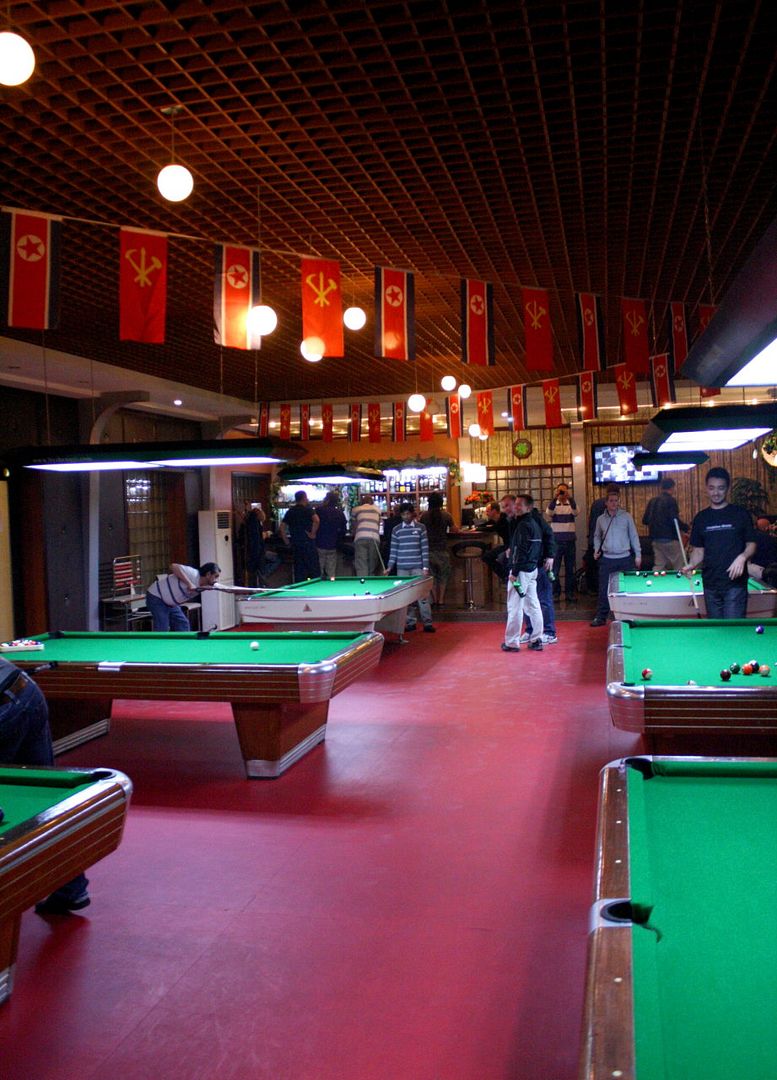
This was a quite a surreal moment, smashing back beers and vodka and playing pool with Kylie Minogue thumping out on the stereo while underneath the flags of the Worker's Party of Korea in the world's last Stalinist state. On the way back to the hotel everyone was most merry and Miss Jong, who had entertained us with her beautiful singing voice on the way back from the DMZ, finally got some reciprocal performances, though none threatened the bar she had set at a height rivalling that of the Juche Tower. Others sang their national anthems, I told some off-colour jokes stolen from Frankie Boyle and Jimmy Carr while Ash did a splendid rendition of Monty Python's “Sit on My Face”. I'm not sure if Miss Jong appreciated our material but all I know is that moments like this are not what most people would anticipate when thinking about travel in North Korea.
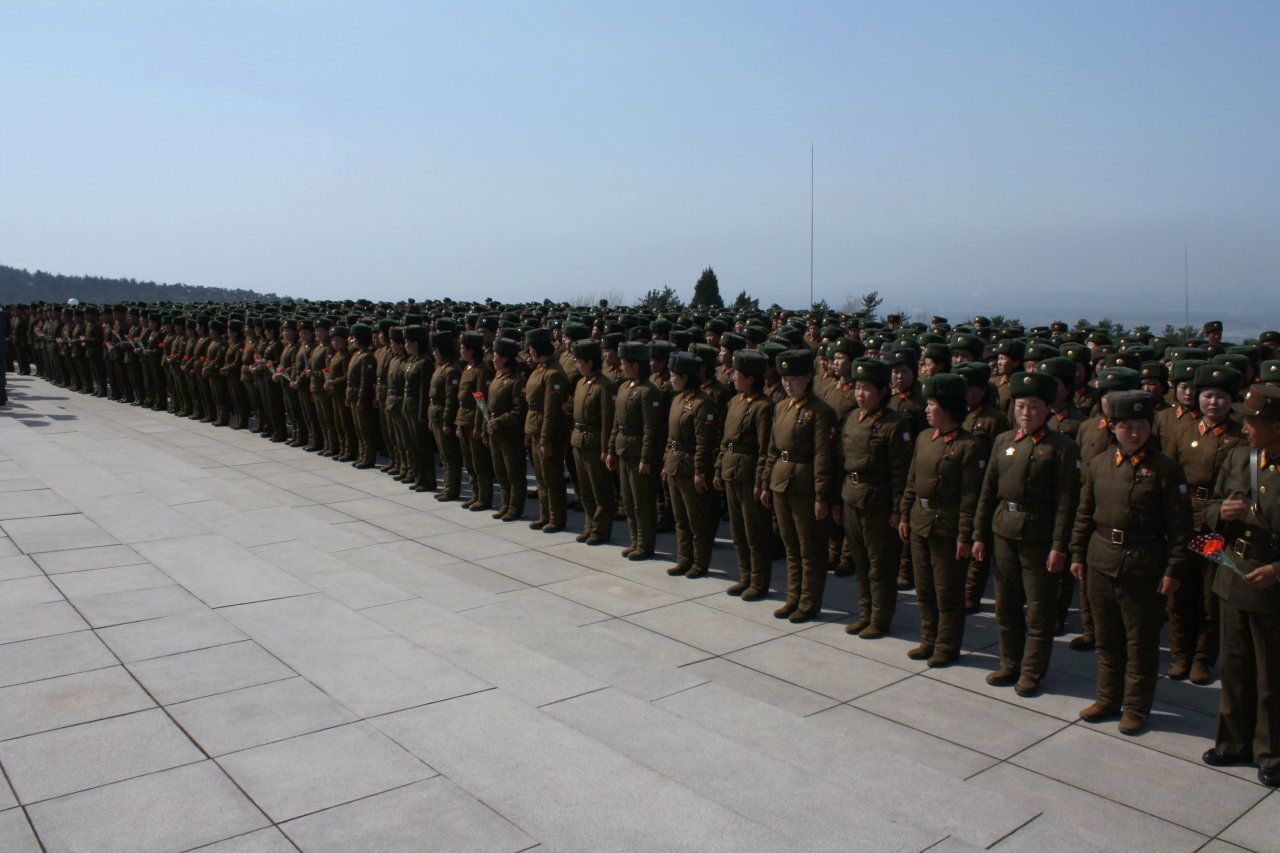
April 15th, the day of the sun, the first day of Juche 101 and 100 years since the birth of Kim Ils-sung in 1912. Also on that day apparently some boat called the Titanic ran into a spot of bother in the Atlantic, but why would you care about some old leaking tub when you get to visit the Revolutionary Martyrs Cemetery to pay tribute to the heroes of anti-Japanese struggles as we and all these soldiers did?

The bust of the woman in the centre is that of Kim Jong-suk, first wife of Kim Il-sung and mother of Kim Jong-il. She features in quite a bit of the state propaganda however as she died in childbirth in 1949 her role is less prominent.
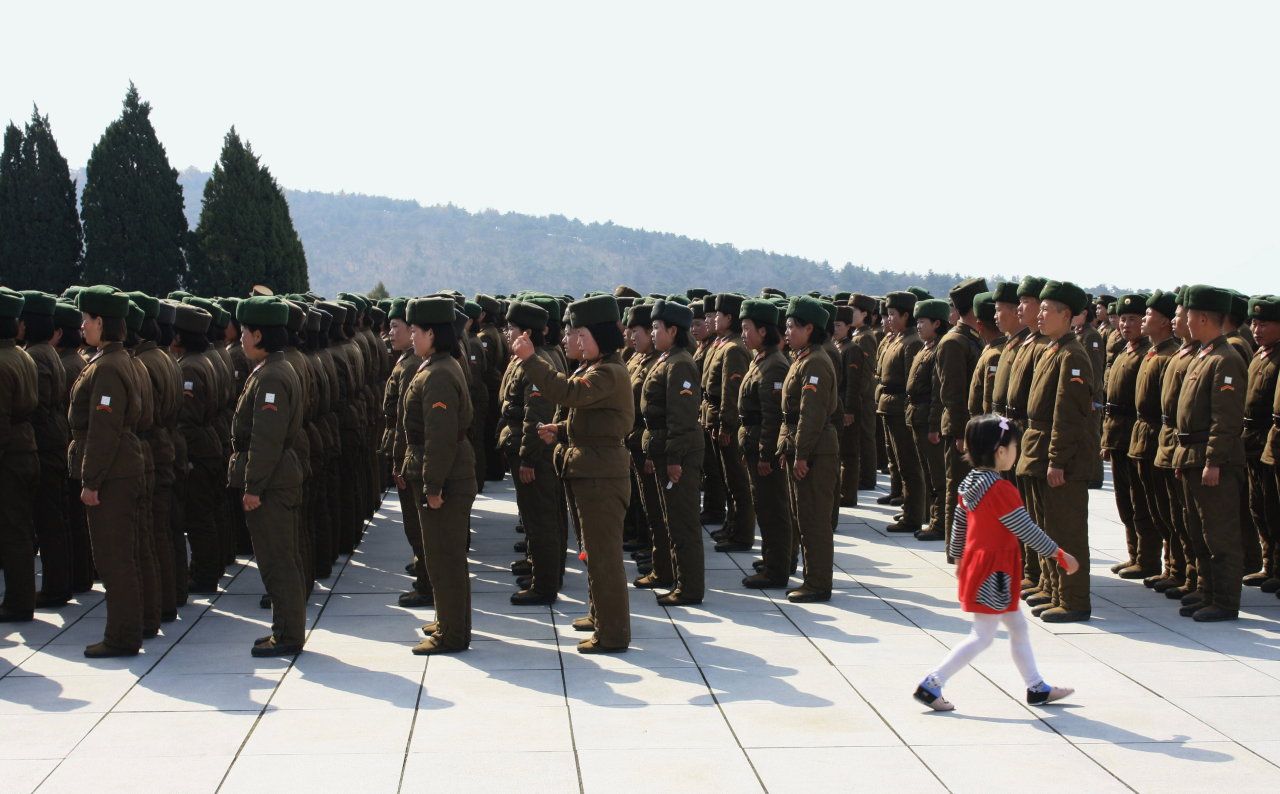
As I was photographing the massed troops this little girl wandered into frame, couldn't have set this up better if I'd tried.

At the bottom of the hill where the cemetery was located was a fun park, although in North Korea, even the rides and play equipment are shaped like missiles.
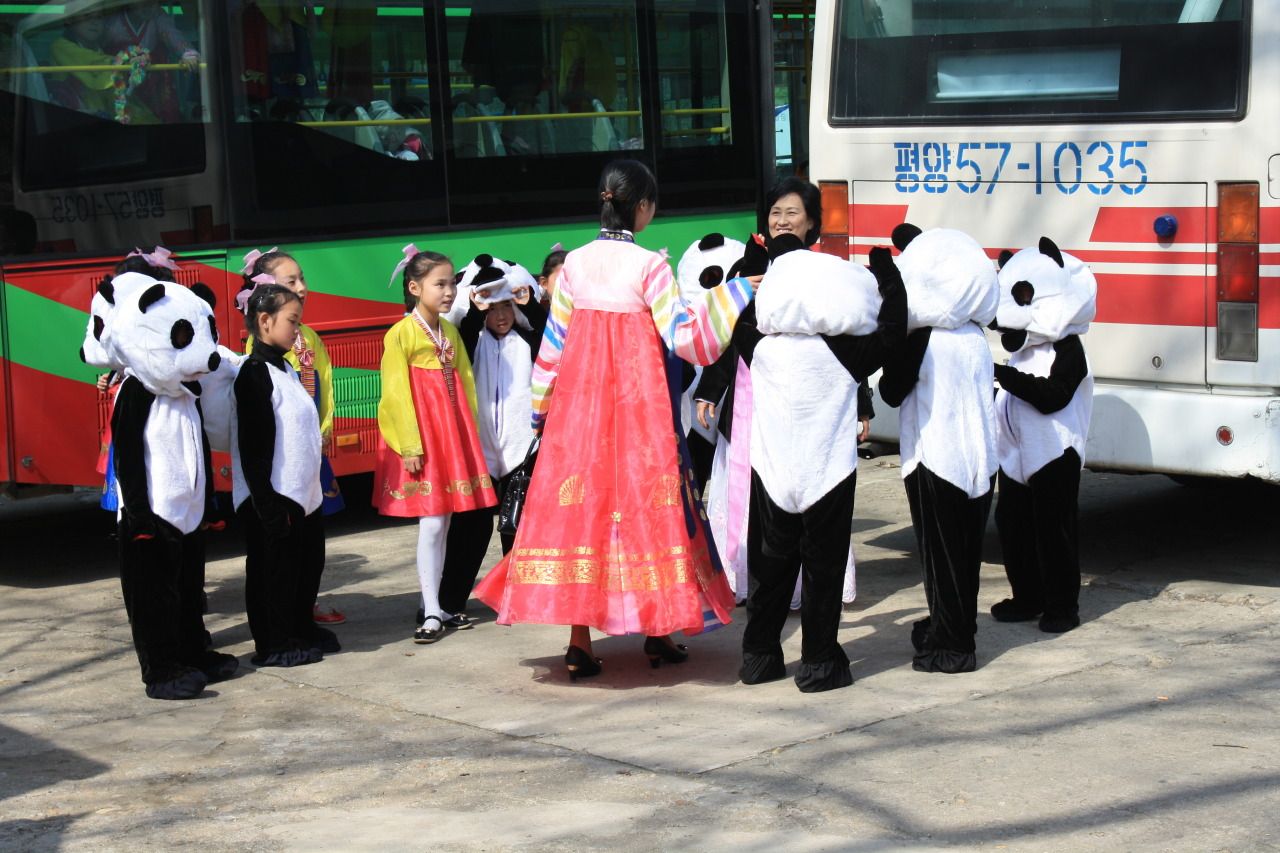
At an oval in the park they were having this festival which mostly consisted of a large numbers of foreign simpletons being entertained by childish party games while a brass band and female dancers did their best to create an atmosphere of 1950s wholesome fun. In between these bouts of enforced frivolity other acts would come on, and these girls in panda costumes were one of them.
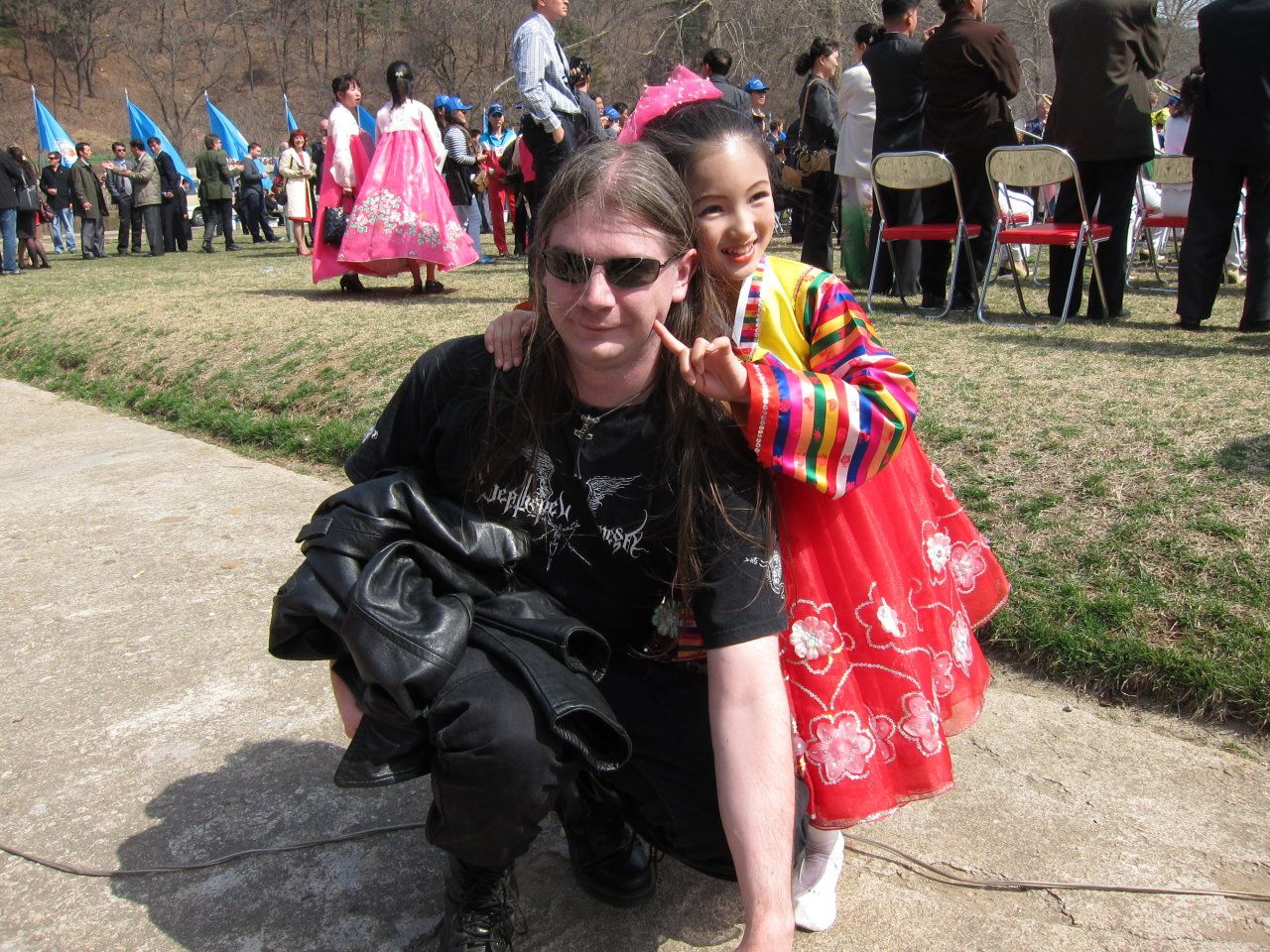
At one point this little girl grabbed me and for some reason delighted in poking me in the face. As you can see she's having a great time doing it, not sure if it was because I was an interesting foreigner or maybe Koreans would object to being prodded in such a manner but whatever, she seemed happy.
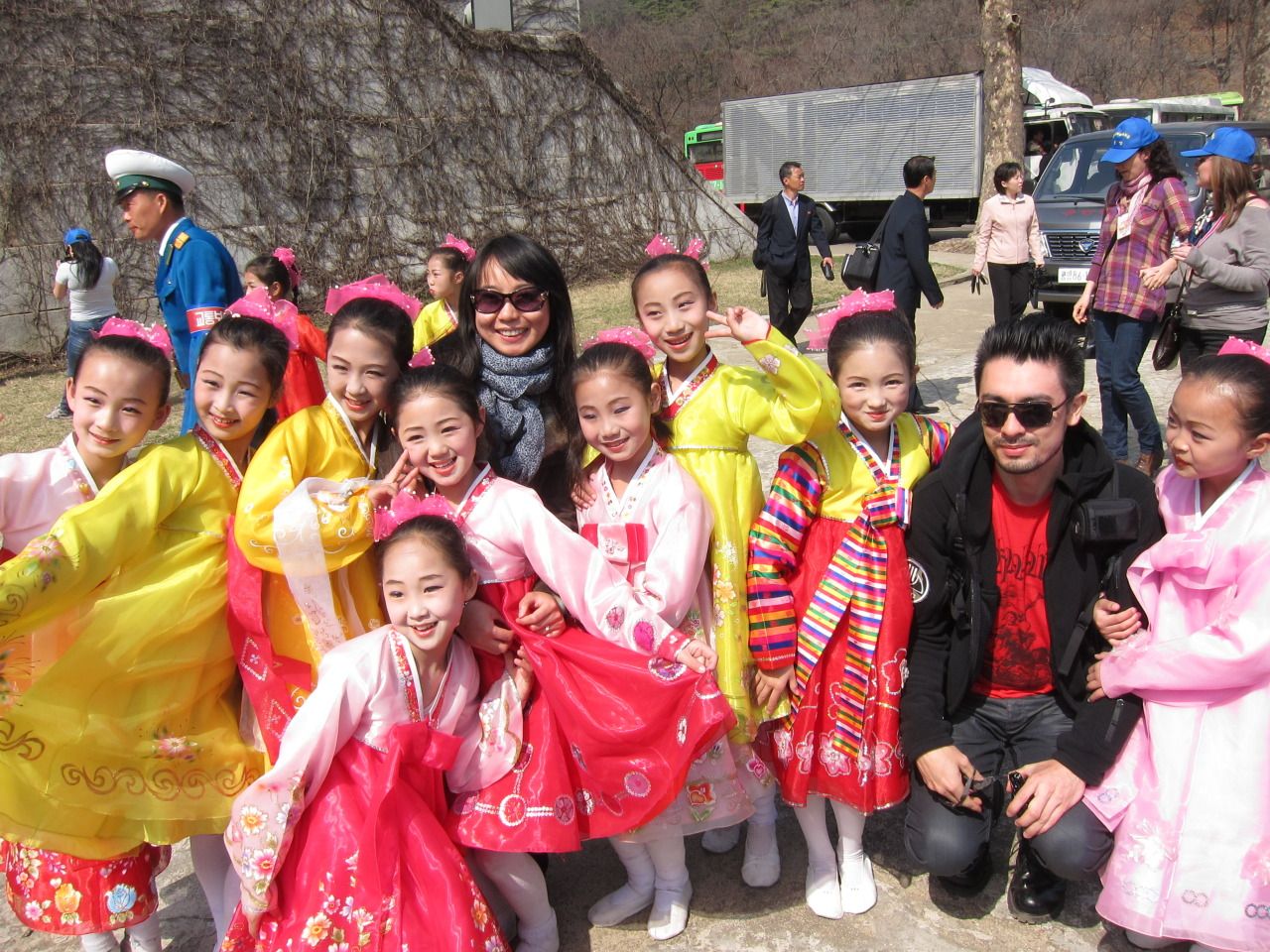
I got off lightly though compared with Ash and Shan, they were positively mobbed by kids.
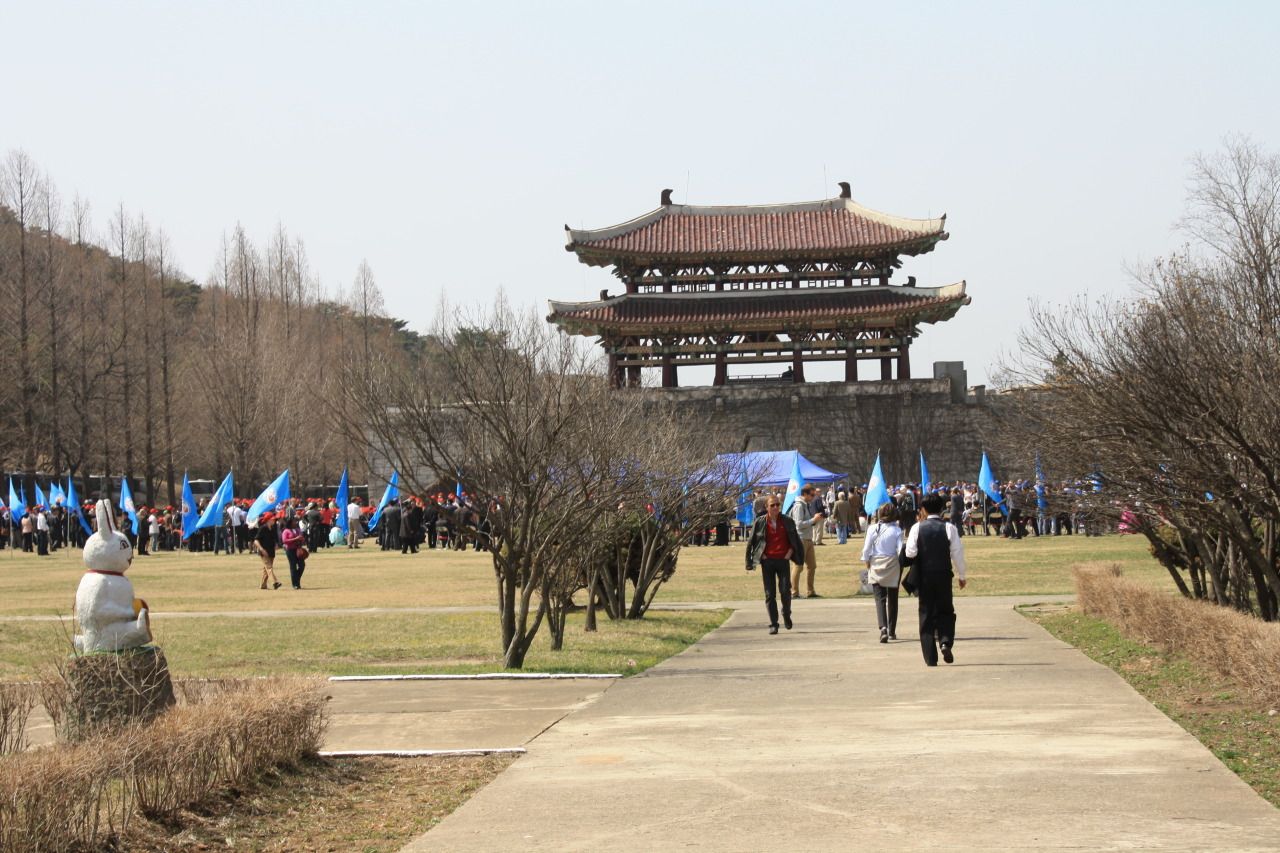
Wide shot of the oval where this festival was taking place.
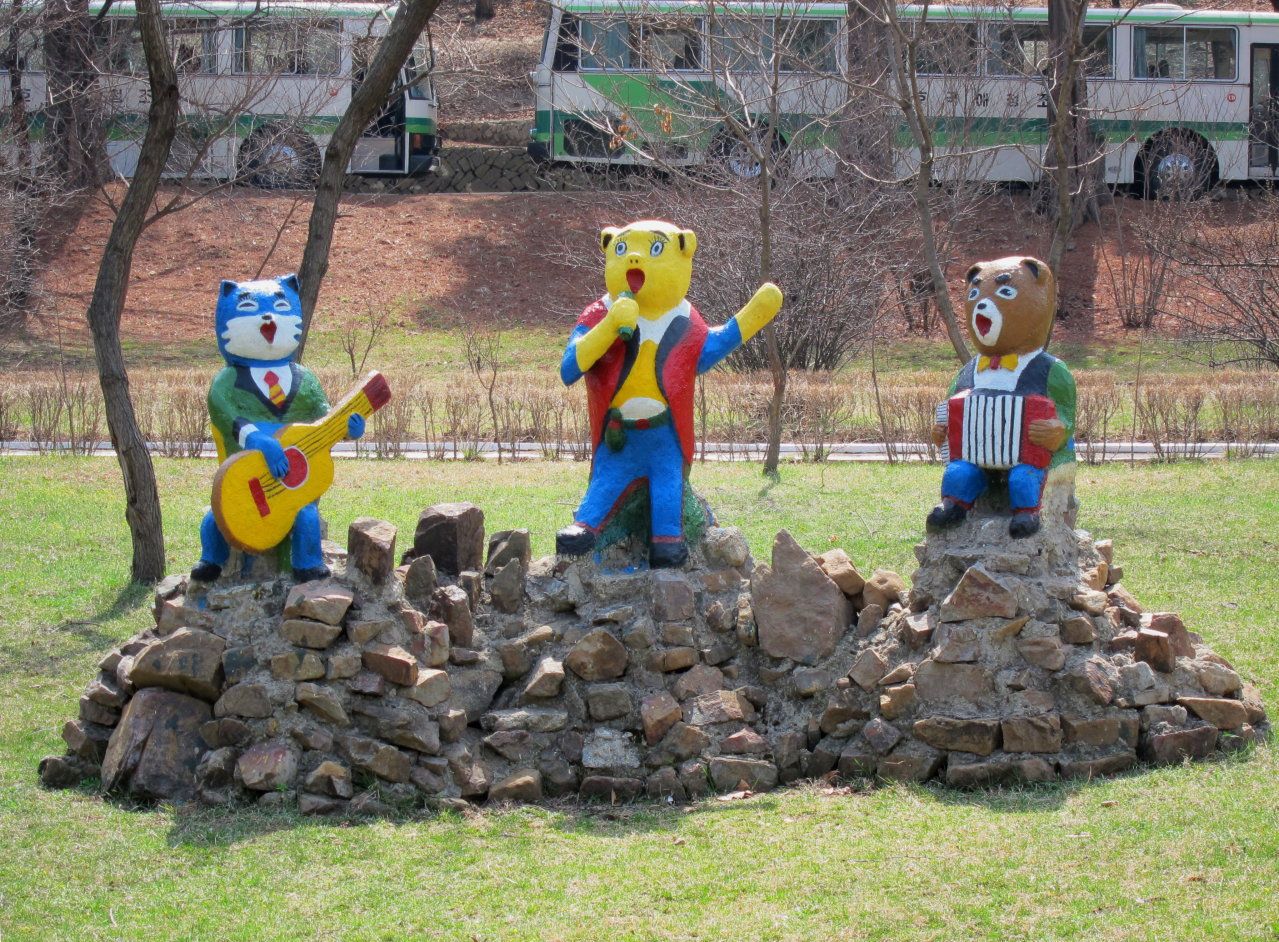
A different type of hideous sculpture.
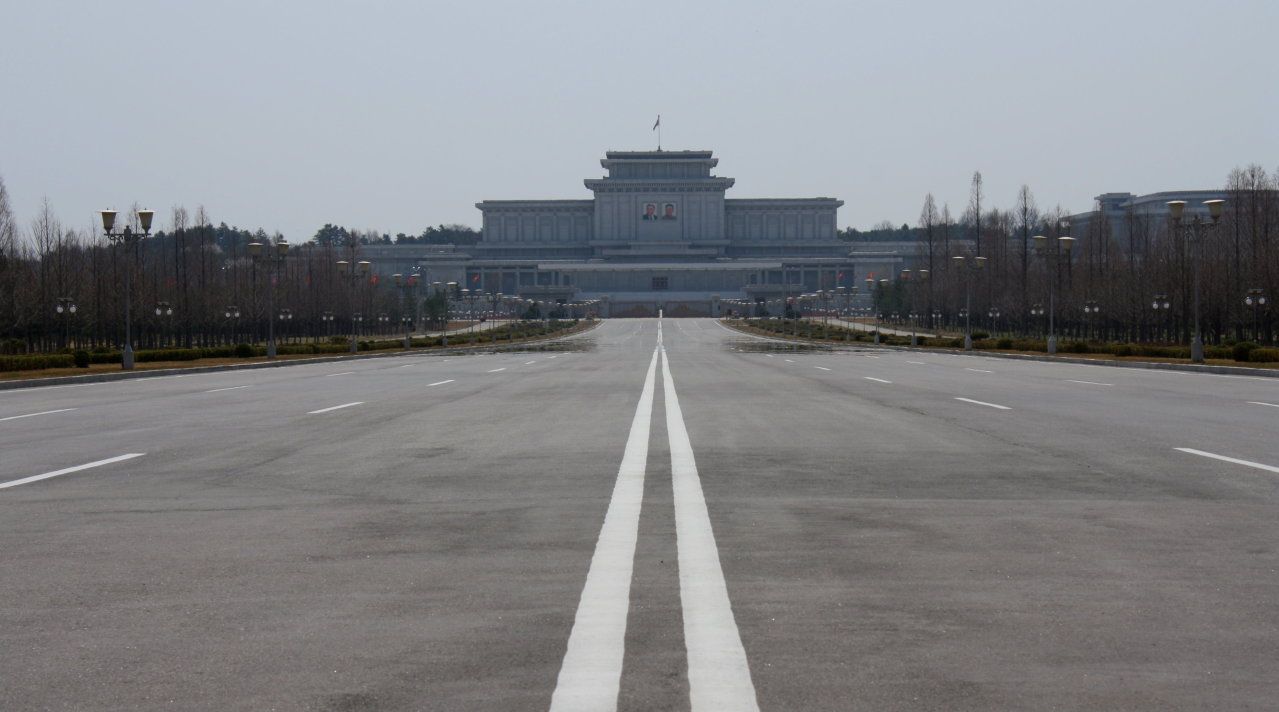
On the way back into Pyongyang this was a frustratingly close as we were permitted to get to the Kumsusan Palace of the Sun. Originally the residence of Kim Il-sung, upon his death in 1994 it was turned by Kim Jong-il into the world's largest mausoleum, it makes Lenin and Mao's tombs seem puny and unimpressive by comparison. This was originally on our itinerary but at the last minute all foreigners were banned from there, possibly due to the planned installation of Kim Jong-il's preserved body along side that of his father.
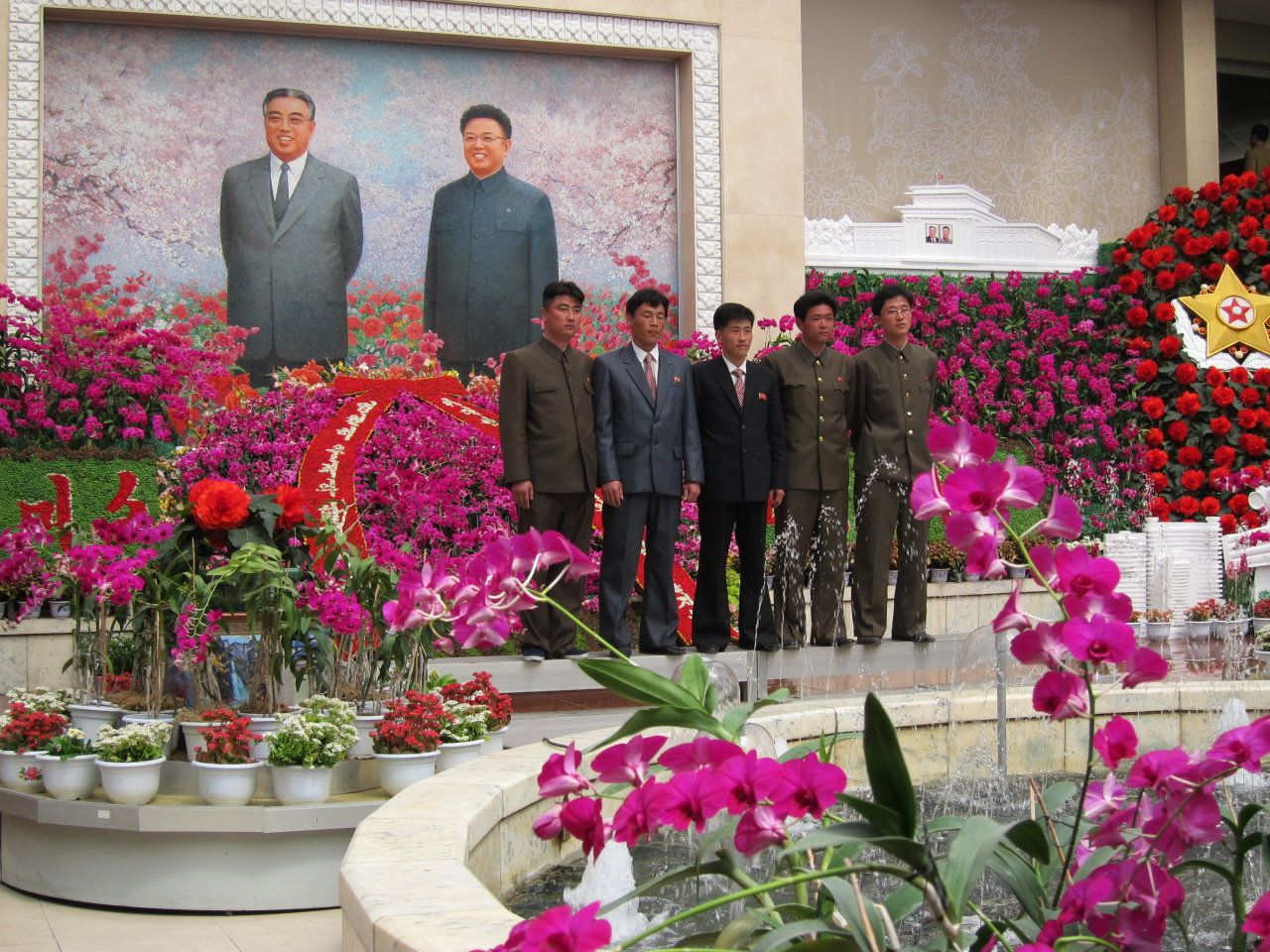
Once back in town we visited a unique flower show. Unique because it only really featured two species of flowers, yep you guessed it, the Kimilsungia (an orchid) and the Kimjongilia (a type of begonia).
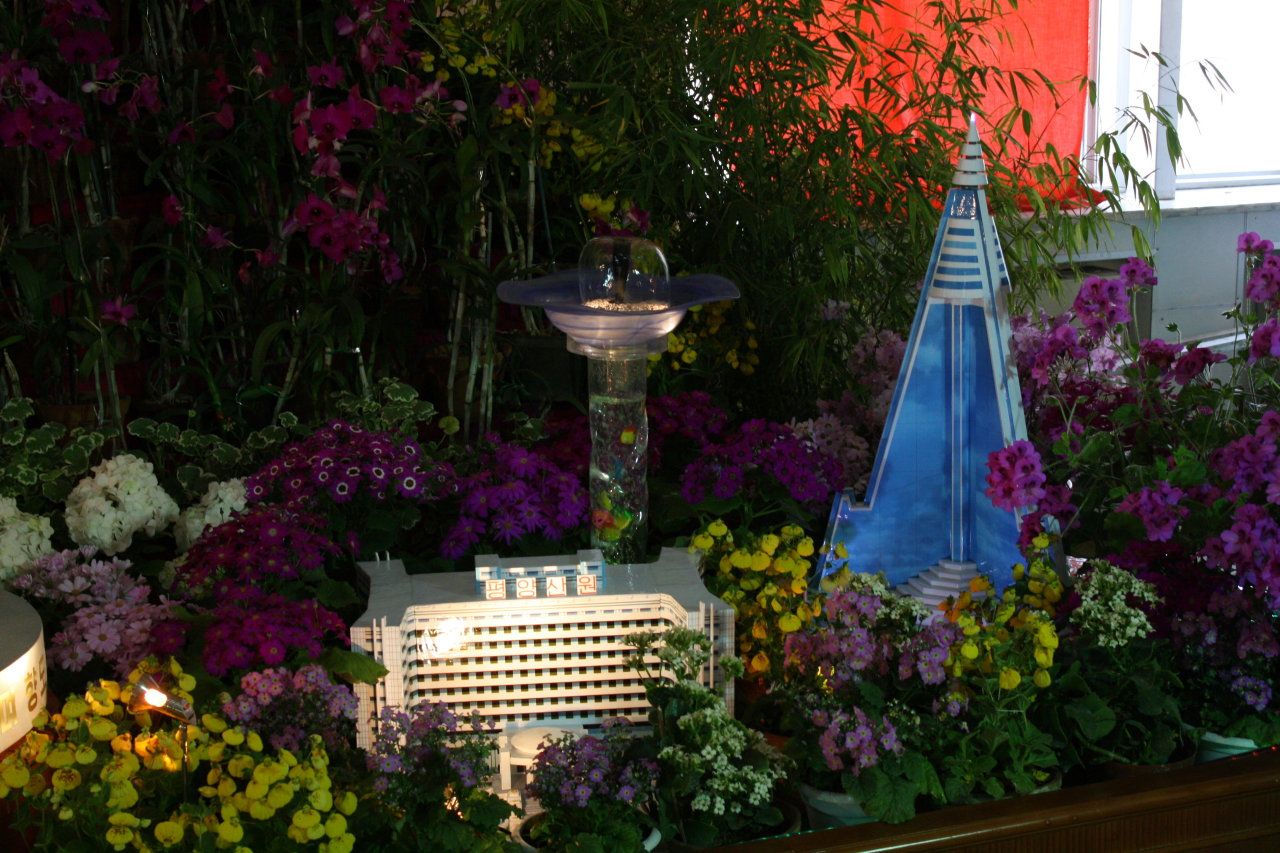
To liven things up, there were little displays scattered throughout the flowers. Of course there were little plastic missiles, tanks and jet fighters, but there were also models of buildings as you can see here and best of all, a miniature revolving version of the Monument to Party Founding, which Ash and I decided would make a great centrepiece at the dinner table.
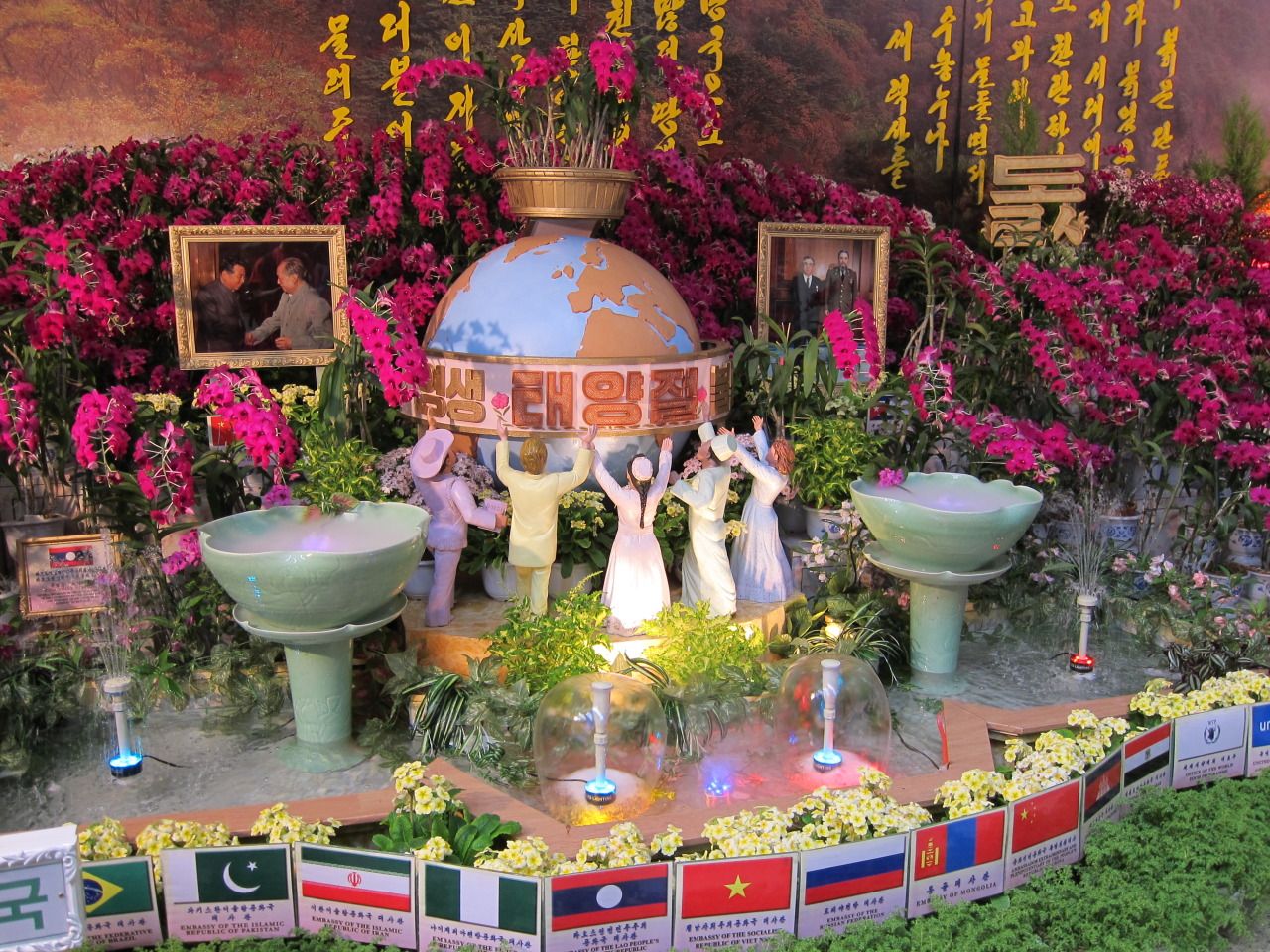
Diorama of stupendous crappiness showing all the peoples of the world worshipping the Great Leader, the dude in the pink cowboy outfit on the left is holding a book labeled Juche. Kim Il-sung is shown in photographs alongside those great statesmen Mao Zedong and Fidel Castro while you can see the flags of the various regimes who North Korea could count amongst it's international friends, a veritable rouges gallery of states.
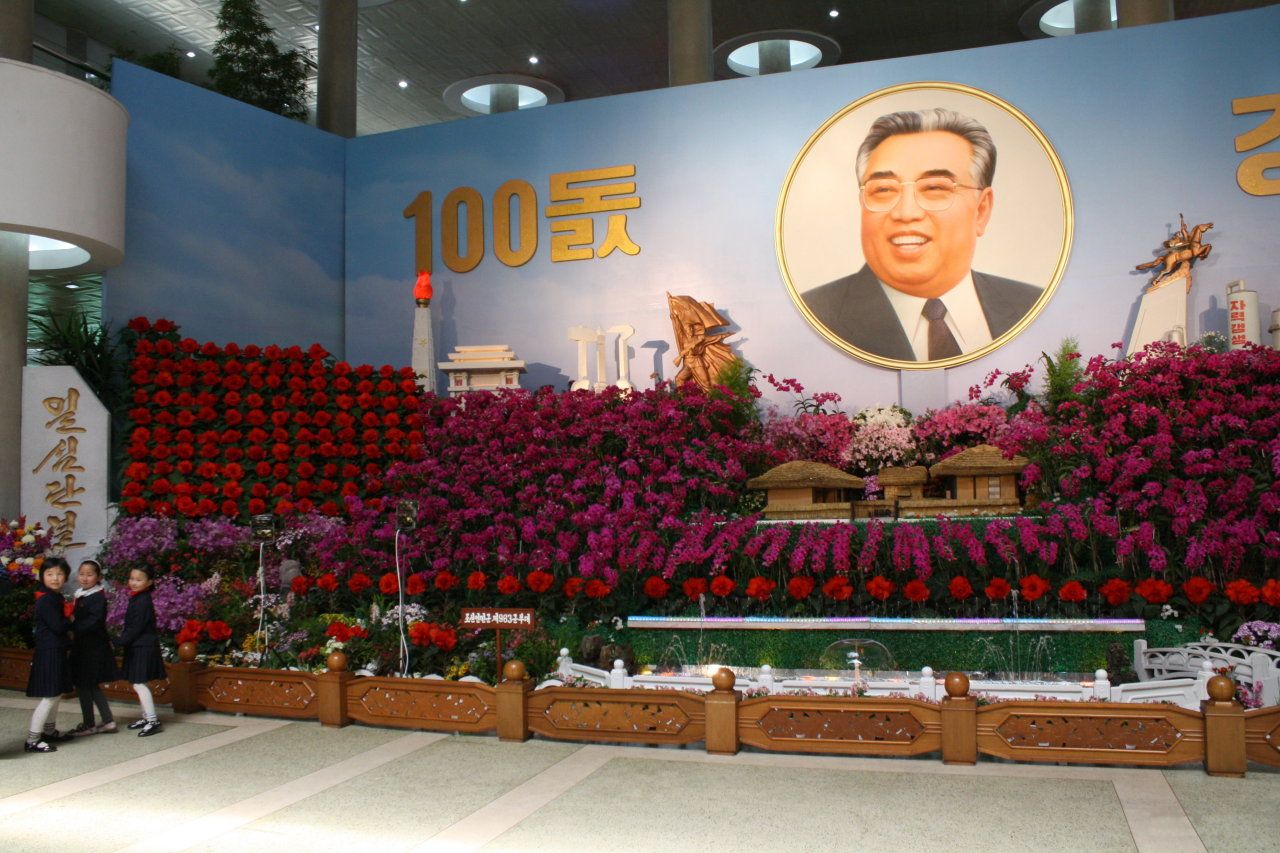
Everywhere you go in North Korea his face is always benevolently smiling down upon you.
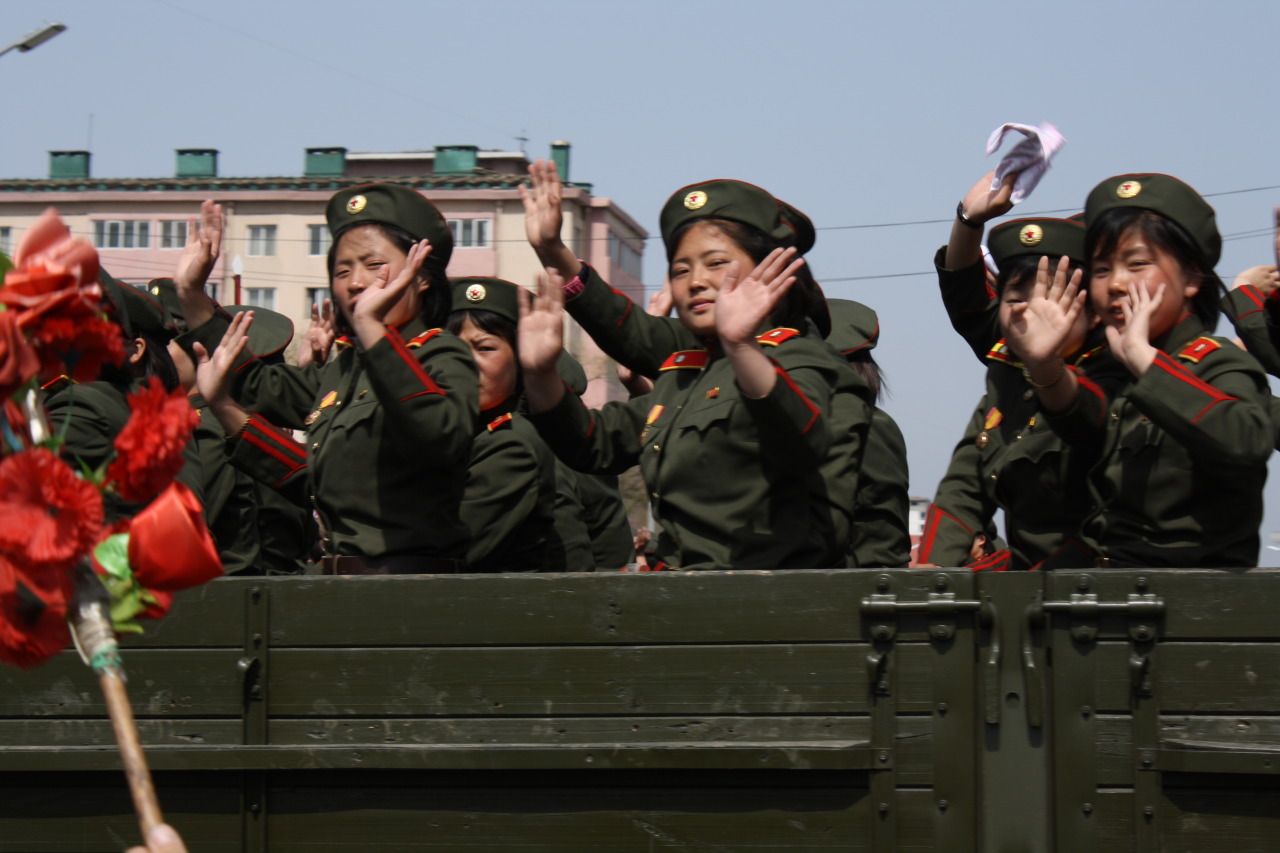
While only specially invited guests got to see what was going on at the centre of the celebrations in Kim Il-sung Square (basically this) that were so massive they were visible from space, the rest of us plebs got to see a smaller parade of soldiers which, along with the rehearsals we'd witnessed the day before, gave a real sense of the sort of military pomp and splendour the DPRK does so well.
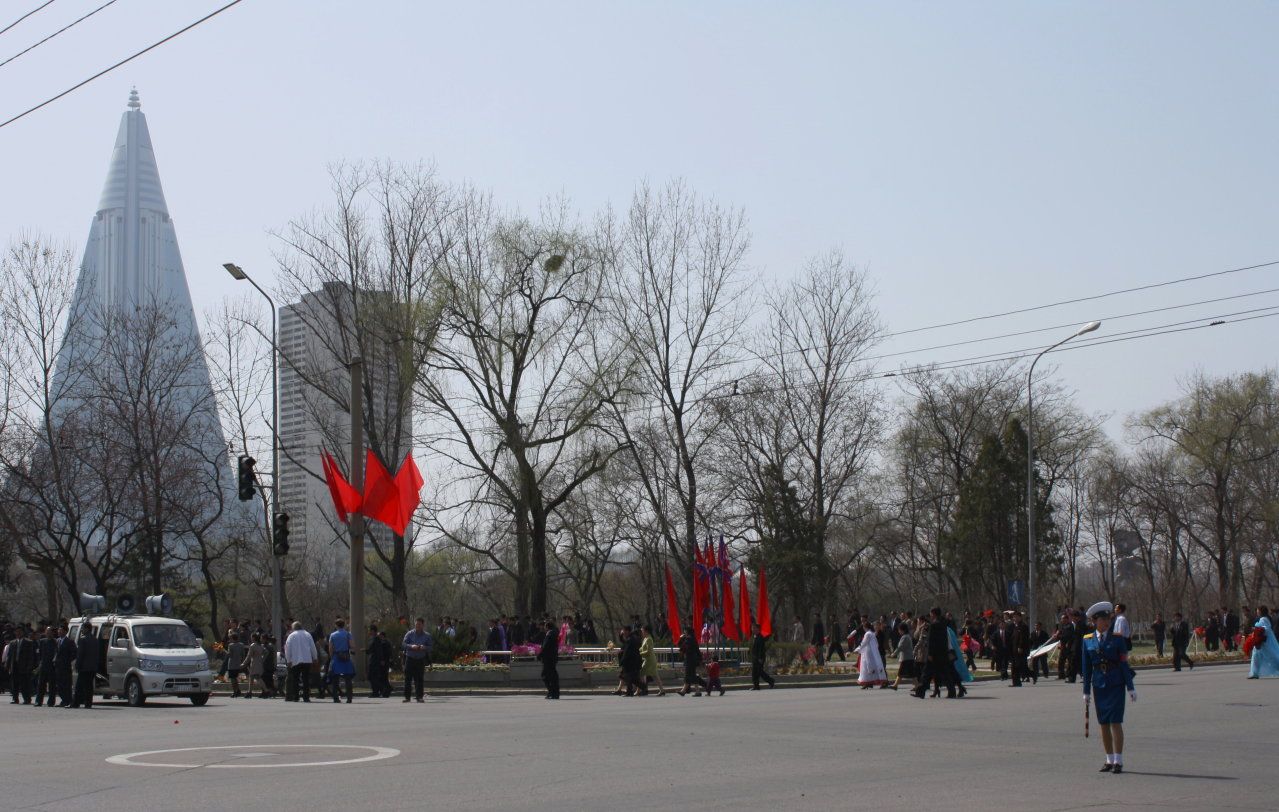
We only caught the tail end of this parade and as soon as the last truck had disappeared the crowd began do disperse, guided along the way by one of Pyongyang's famous traffic girls seen here in the lower right doing a better job than any traffic light or sign ever could at managing the flow of people and vehicles.
To show why the traffic girls have become an icon of Pyongyang and the DPRK please watch this amazing video that neatly captures the stillness broken only by strictly regulated movement that defines life in North Korea. This music also made an appearance as we were leaving as I shall describe below.
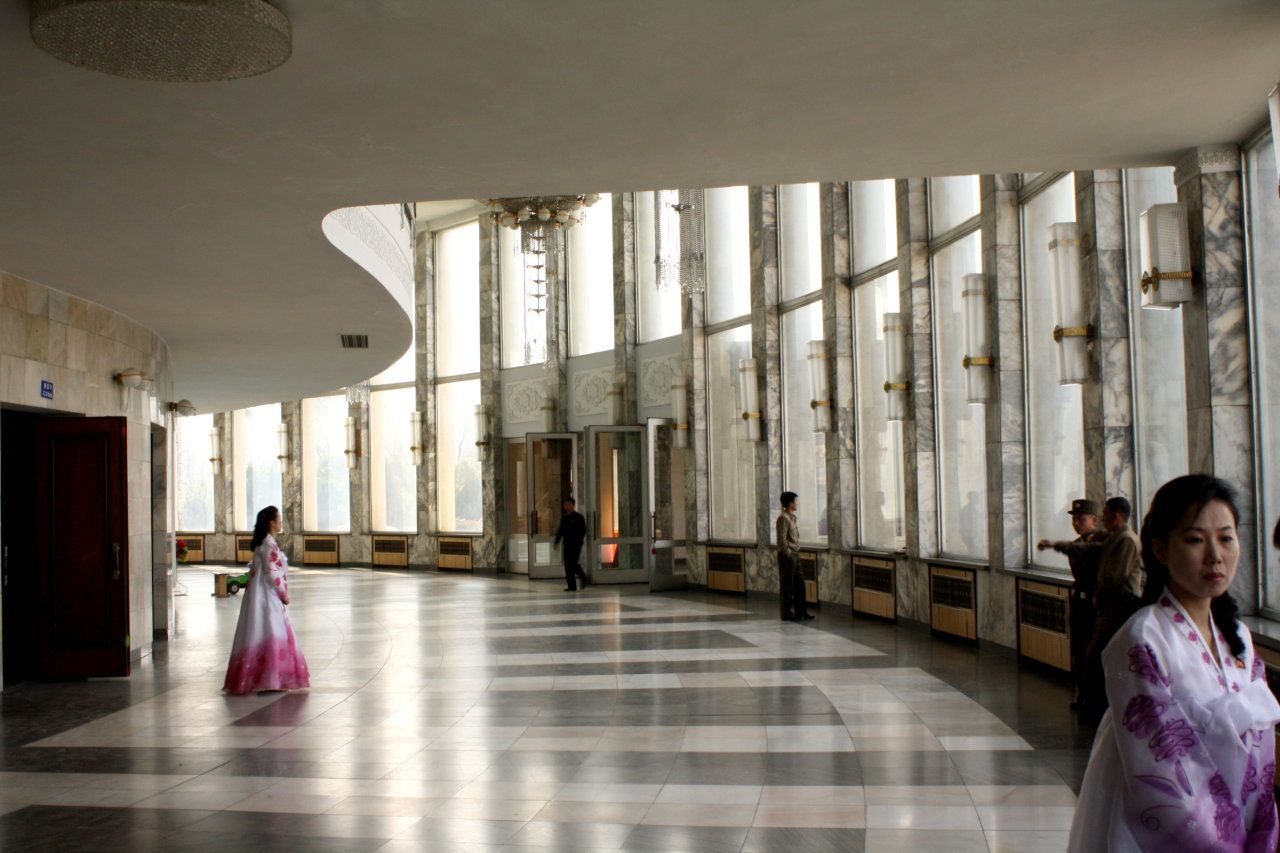
This rather severe looking building houses the Pyongyang Military Circus, one of the few North Korean groups that perform overseas. Rather than a brightly-coloured bigtop they were housed in a grey marble edifice, but at least the show was fun.
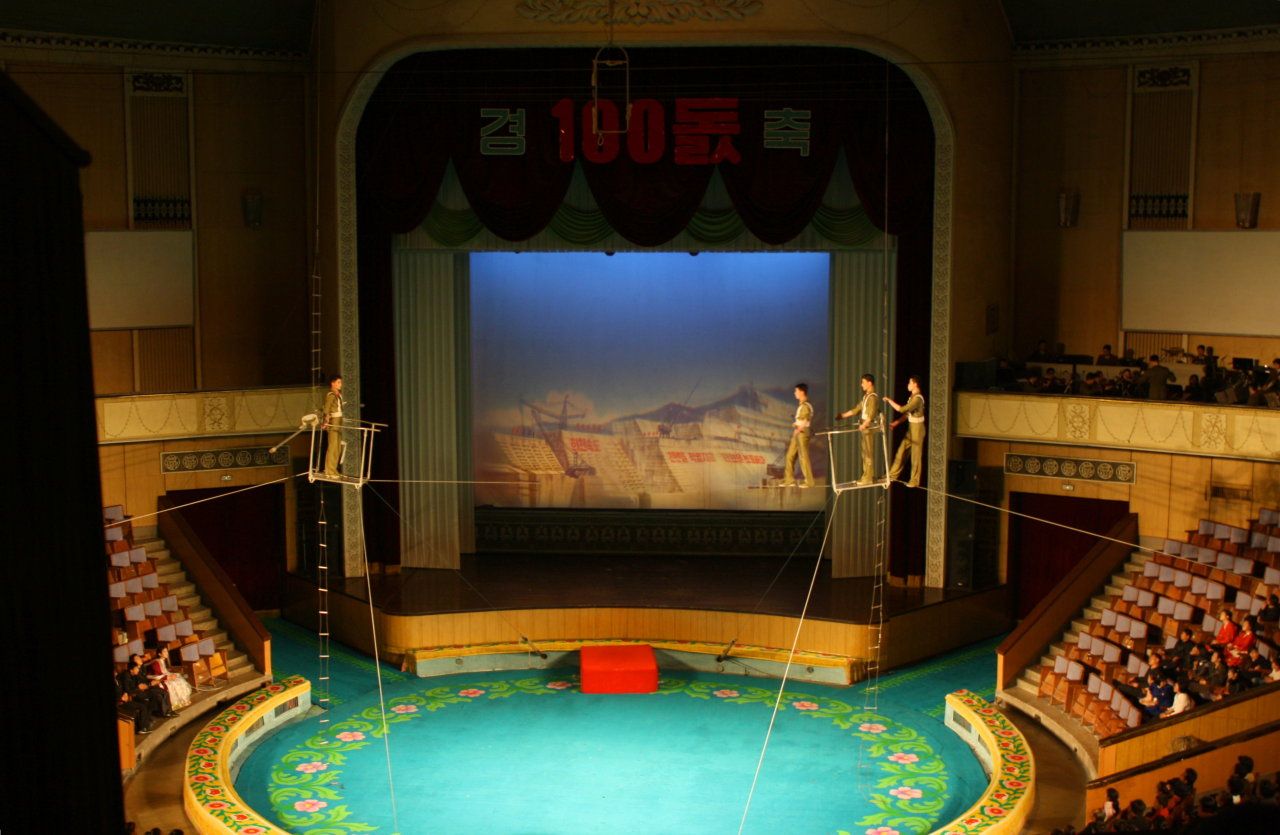
I hadn't been to the circus since I was a small child, and was surprised at how much I enjoyed it. While the performers were incredibly skilled, for me one of the chief joys was the awesome 1970s-style progressive rock soundtrack many of the routines were backed by. Several of the acts from that day (including the tightrope walkers pictured here) were filmed and uploaded by a kind person to YouTube. Despite a few empty seats behind the ring it was mostly a full house and the show was well received by all.
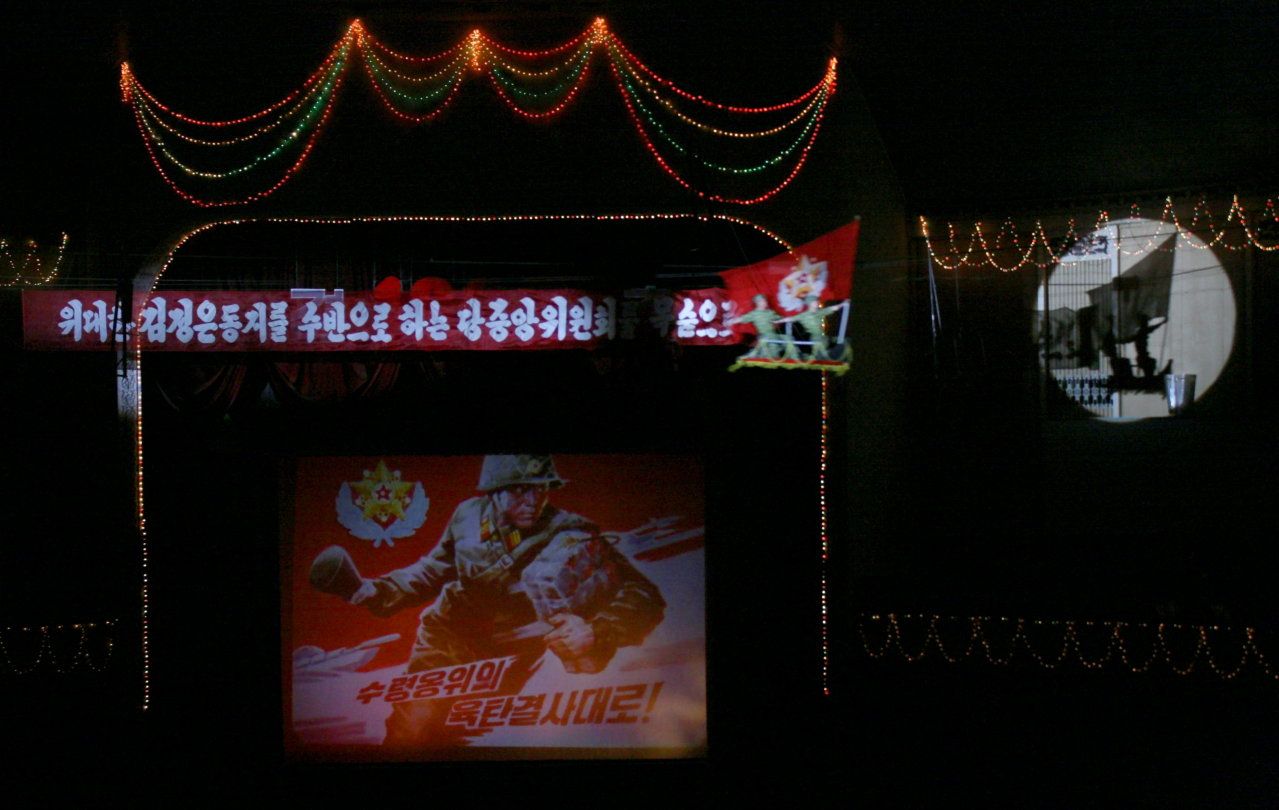
However this was a surprise, after the last act these guys shot across the roof of the place on a wire while a photo of grenade carrying soldier was shown on the main screen.

Then at the end when all the performers came out to take their bows an image of missiles was displayed, once again demonstrating the songun or “military first” ideology that dominates every aspect of life in the DPRK.
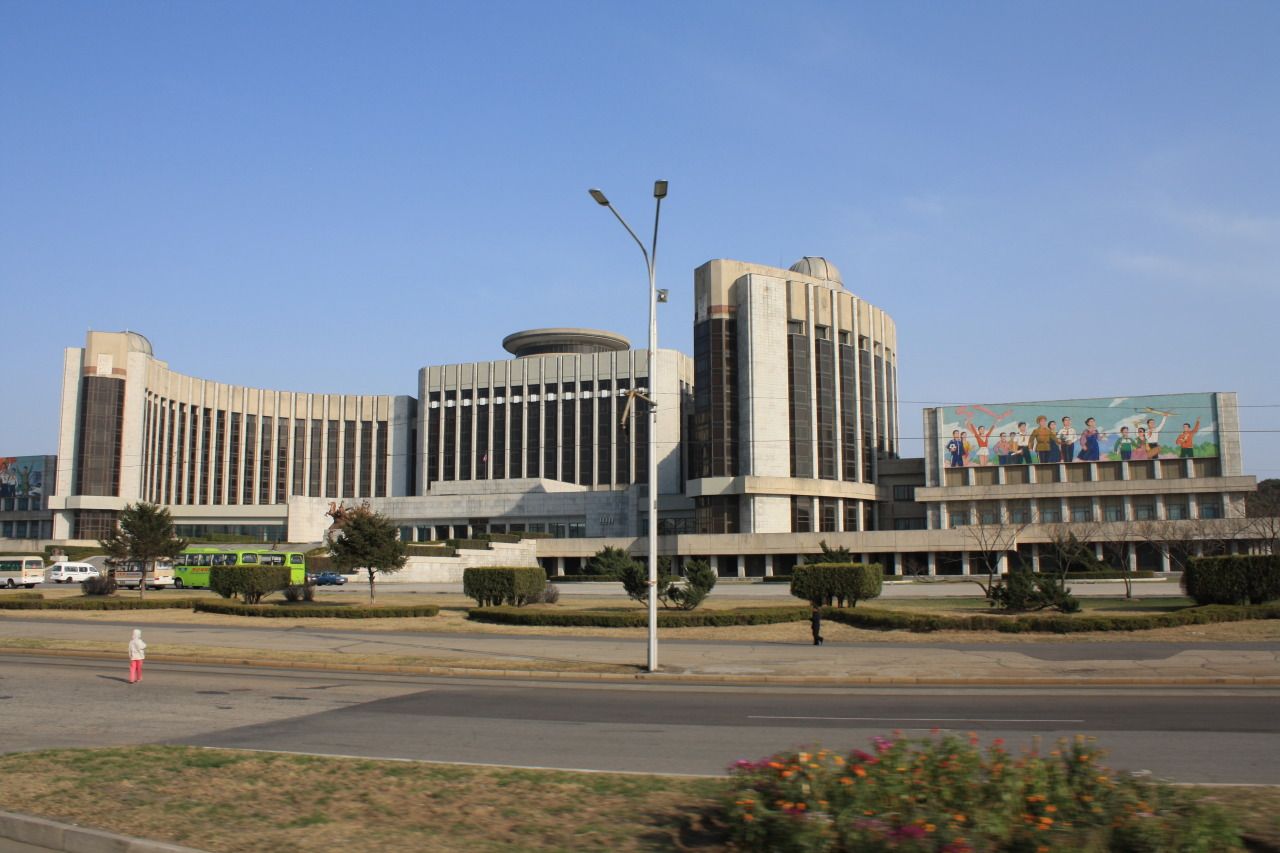
And the performances didn't end there, before we knew it we were at one of the Pyongyang's two “Children's Palaces” to see the kiddies put on a show.
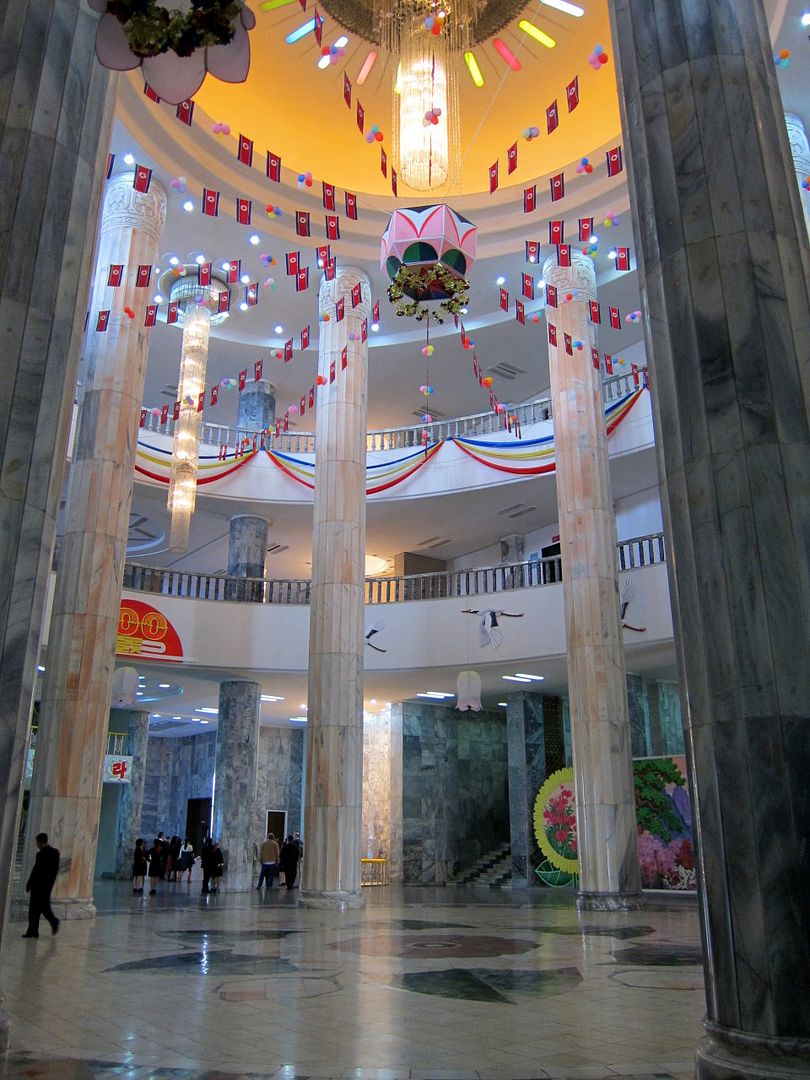
The interior was yet more freezing cold marble enlivened only marginally by colourful bunting. Shan had wisely advised us to rug up before leaving the pleasant sunshine to go inside any buildings and this came in useful, heating is almost non-existent and their cold climate and love of marble meant that our breath was frosting inside on many an occasion.

While there was an awful lot of saccharine music, screechy singing and more fixed grins than the synchronised swimming programme at the Olympics, the extraordinary talent of the children was undeniable. One does have to wonder at the sort of practice they have to undertake to achieve this level of perfection but then again pushy parents and strict teachers can be found the world over.
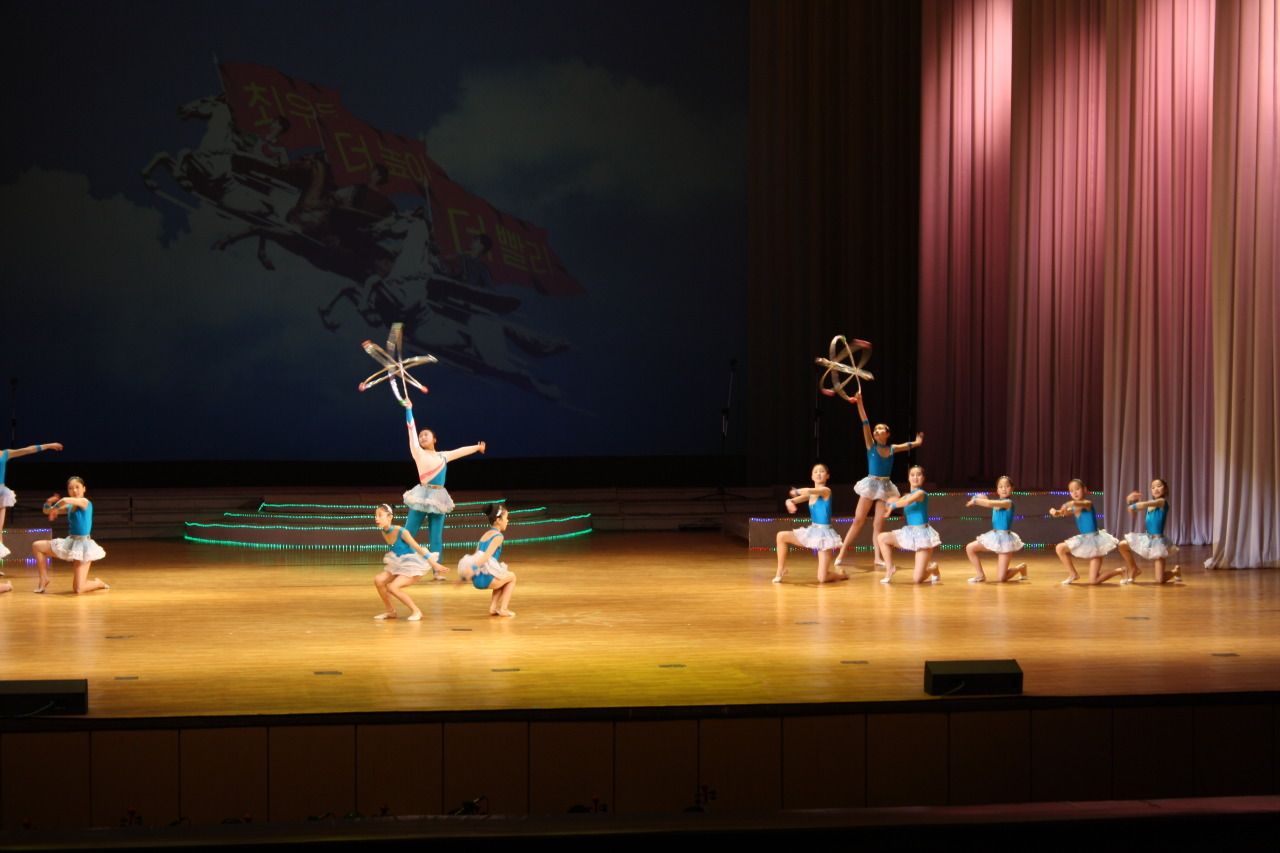
Remember that scene in Team America: World Police where Kim Jong-il's entertainment consisted of people dancing around underneath prop tank barrels and missiles and you thought “Oh that's ridiculous satire”? Then you visit the country continually at the centre of the nuclear debate there and there are little girls running around carrying big models of atoms and you realise that often the truth really is stranger than fiction.
This film was taken at the performance were at (full explanation below), watch out for extra talented girl from 12:30, I especially enjoy her drum solo.
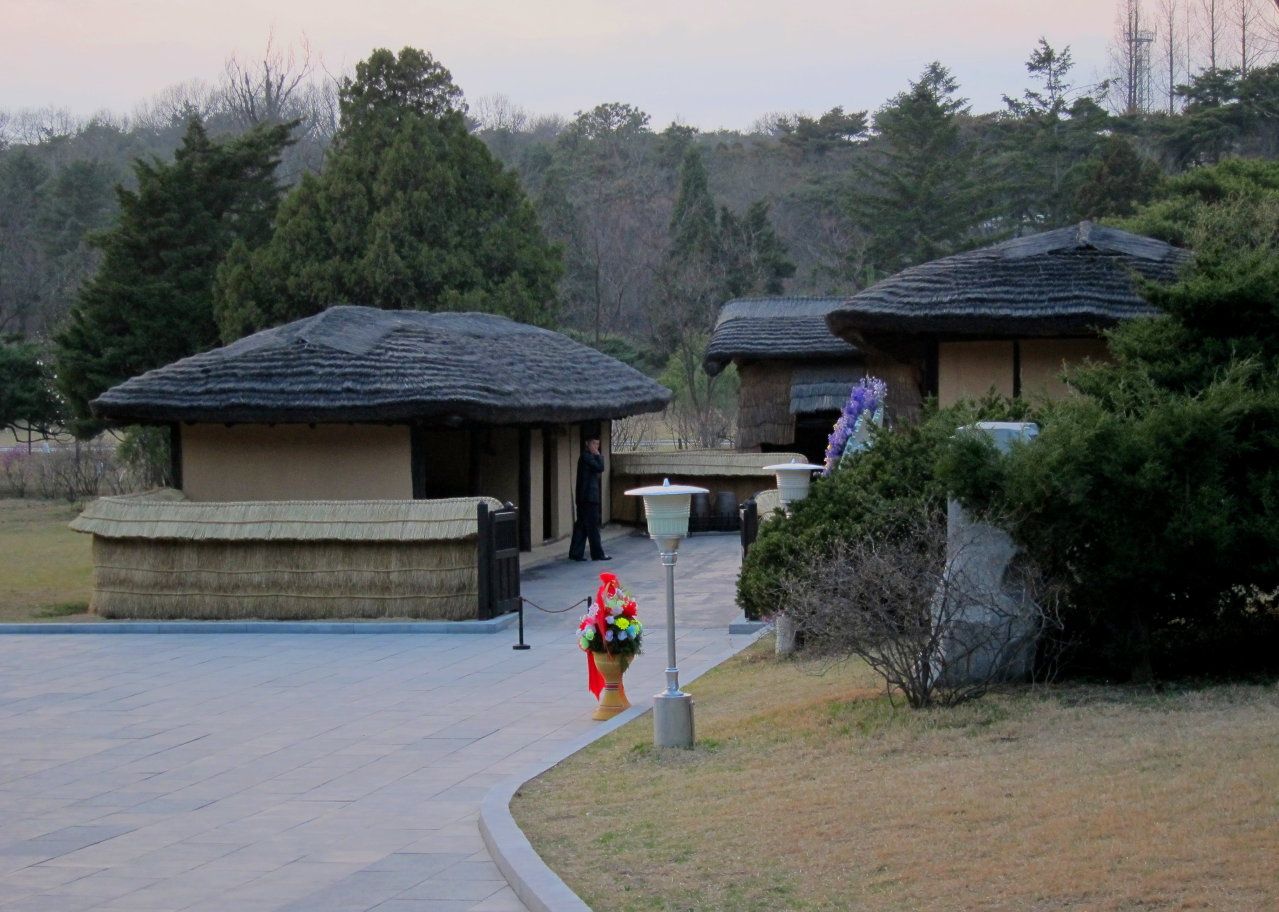
As the sun sank we walked through gardens to the Kim Il-sung birthplace which by the time we got there was shut for the day. Never mind, they had a well there which the Kim family used for drinking water so I had my first taste of non-bottled water since we'd left Melbourne, cool, crisp and unlike Pyongyang tap water, most drinkable.

Half way through our evening meal at another BBQ restaurant word came through that the celebratory fireworks were about to begin, so after a quick conference it was decided to abandon dinner temporarily and speed back towards the centre of Pyongyang to try and catch some of display. We didn't make it to the Taedong river where they were being launched form, but this square was a good vantage point and we toasted the late president's health.
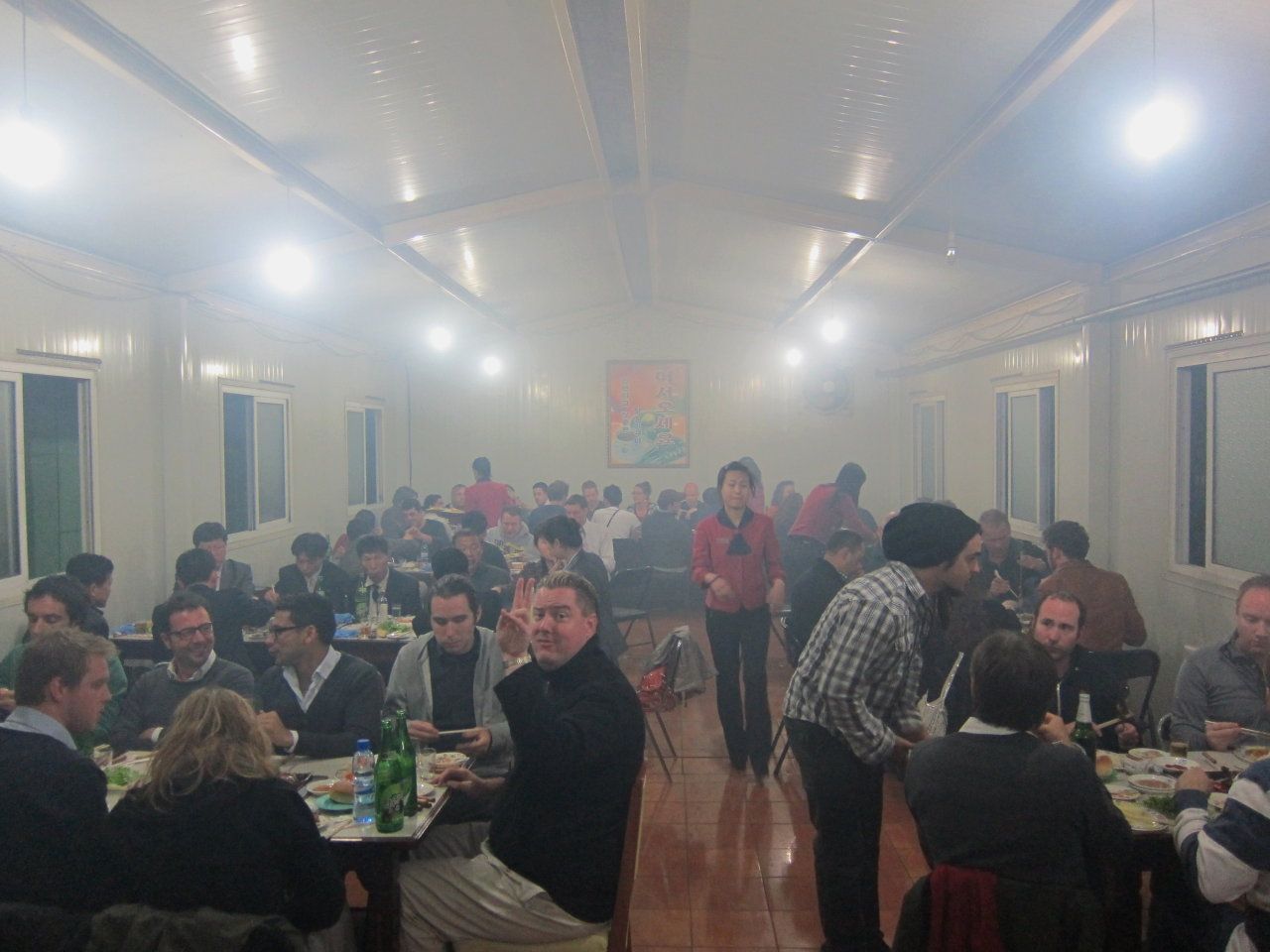
Picking up the nomming where we left off, this is what happens when you have a shitload of people barbecuing indoors without an extractor fan (there was one but it didn't work or wasn't switched on). Rather than getting us the second round of beers we'd ordered the waitresses instead broke out an accordion and started so sing, thus giving us our fourth Korean musical performance of the day. Ash even got roped into dancing with some of the waitresses and later they all wanted to a photo with me, mostly because of my hair. Of course as Richie was around I only had the second most outrageous male hair in the whole country, however we stood out as North Korean men are compelled to trim their hair in accordance with the socialist lifestyle.
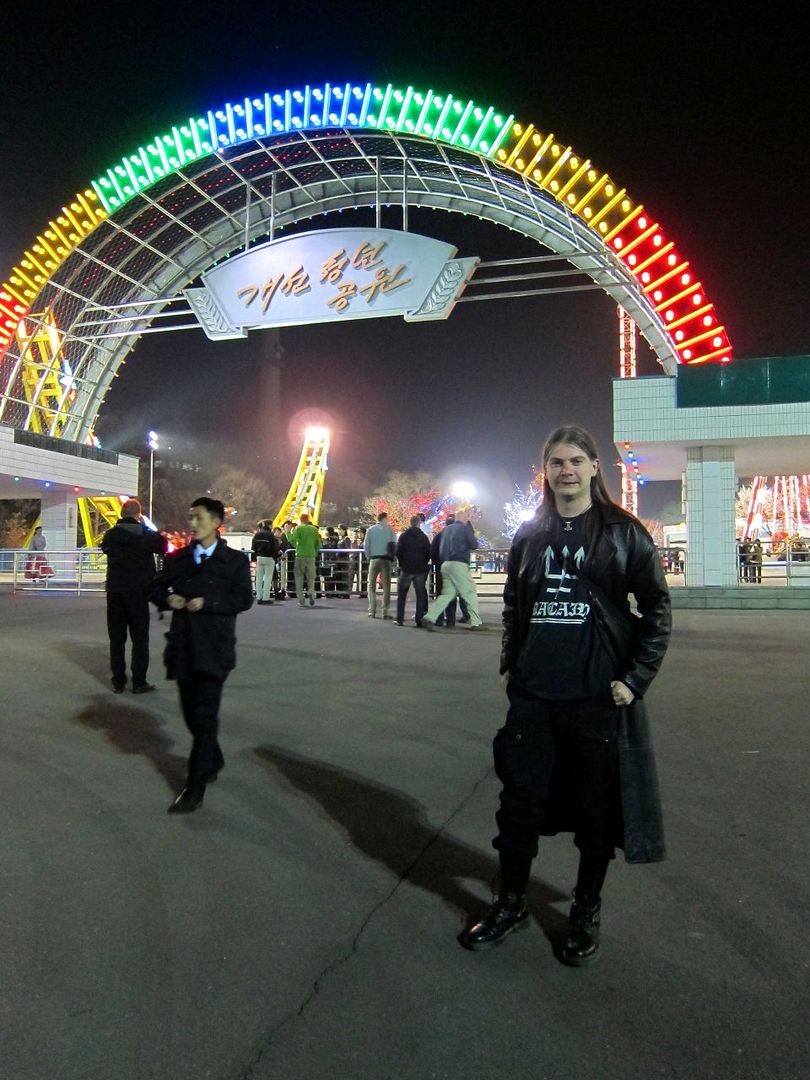
Kaeson Amusement Park, which featured the very latest in theme park ride technology from Europe as well as playing host to North Korea's only fast food outlet (where they call hamburgers “minced meat and bread” as the word “hamburger” might remind people of America) which is owned by Kim Jong-il's sister. It even gets the Kim Jong-un seal of approval when he came and looked at it, you can see this great moment here accompanied by legendary newsreader Ri Chun-hee's thunderous narration.
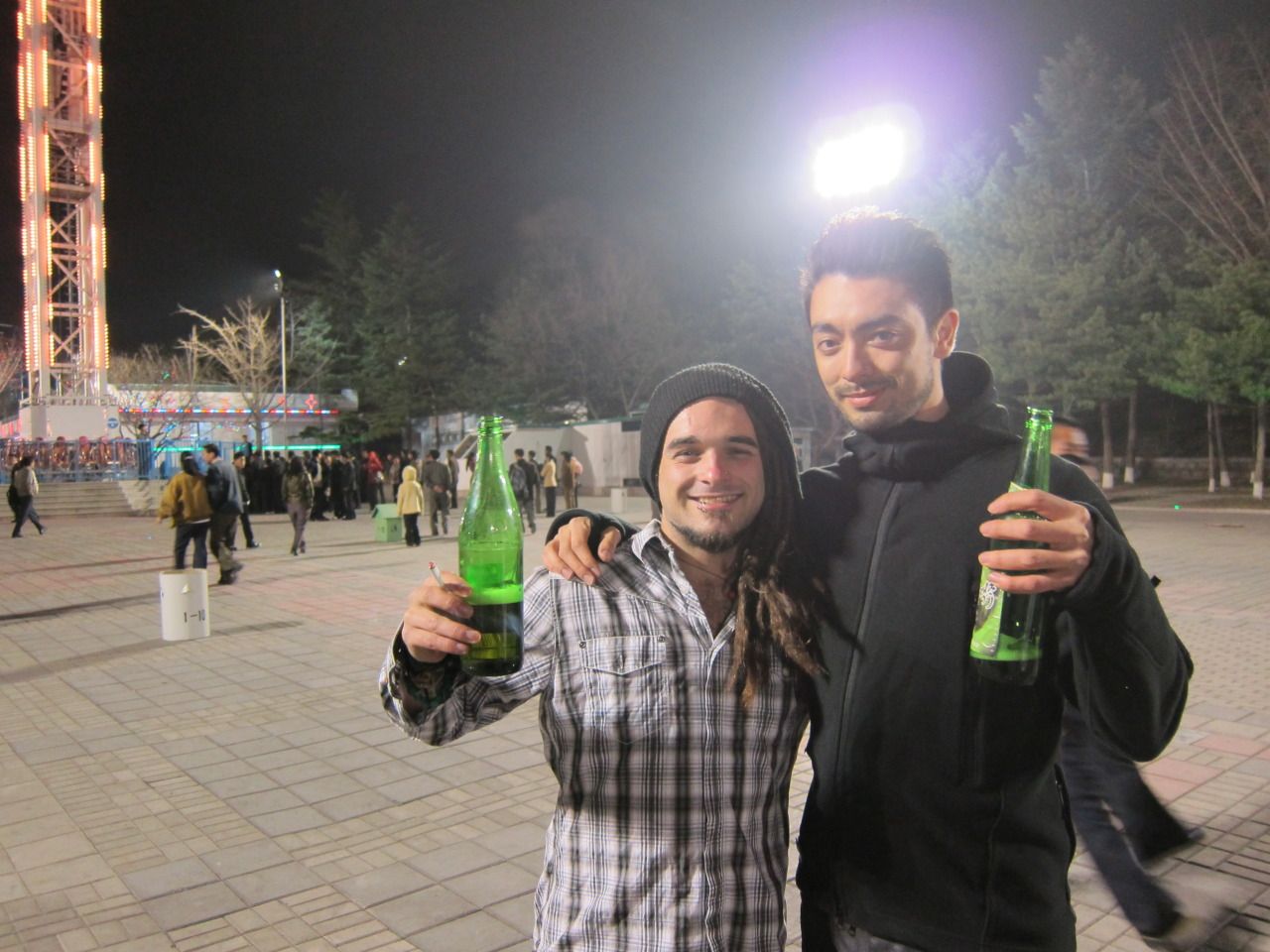
Ash with Richie, the Young Pioneer guide for group B, we were with Shan in group A (numbers were so large we were split in three). An Englishman originally from Milton Keynes, although not that old he's a seasoned traveller and very well versed on all matters North Korean. Had a blast boozing up with him and sharing stories, the freezing temperatures that night did not dampen anyone's enthusiasm for either drinking or enjoying the rides.
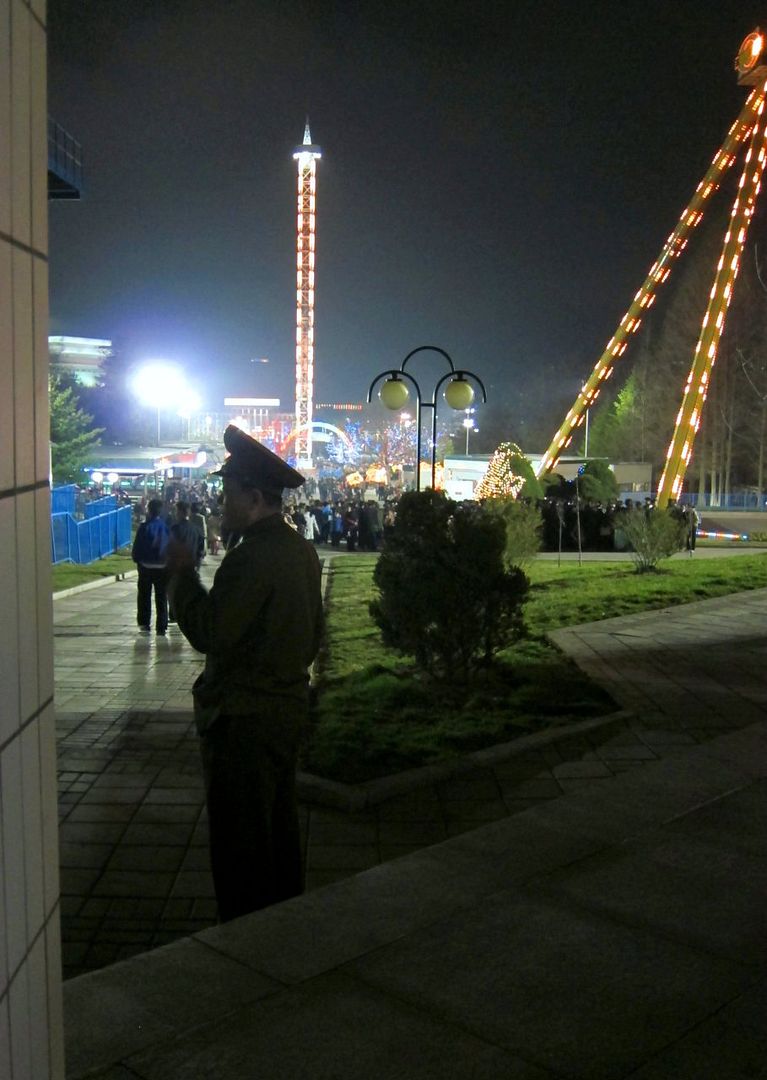
My photo taken with Ash's camera as my battery had died at the Kim Il-sung birthplace. I wanted this silhouetted shot as a pretentious commentary on the pace of change within the DPRK.
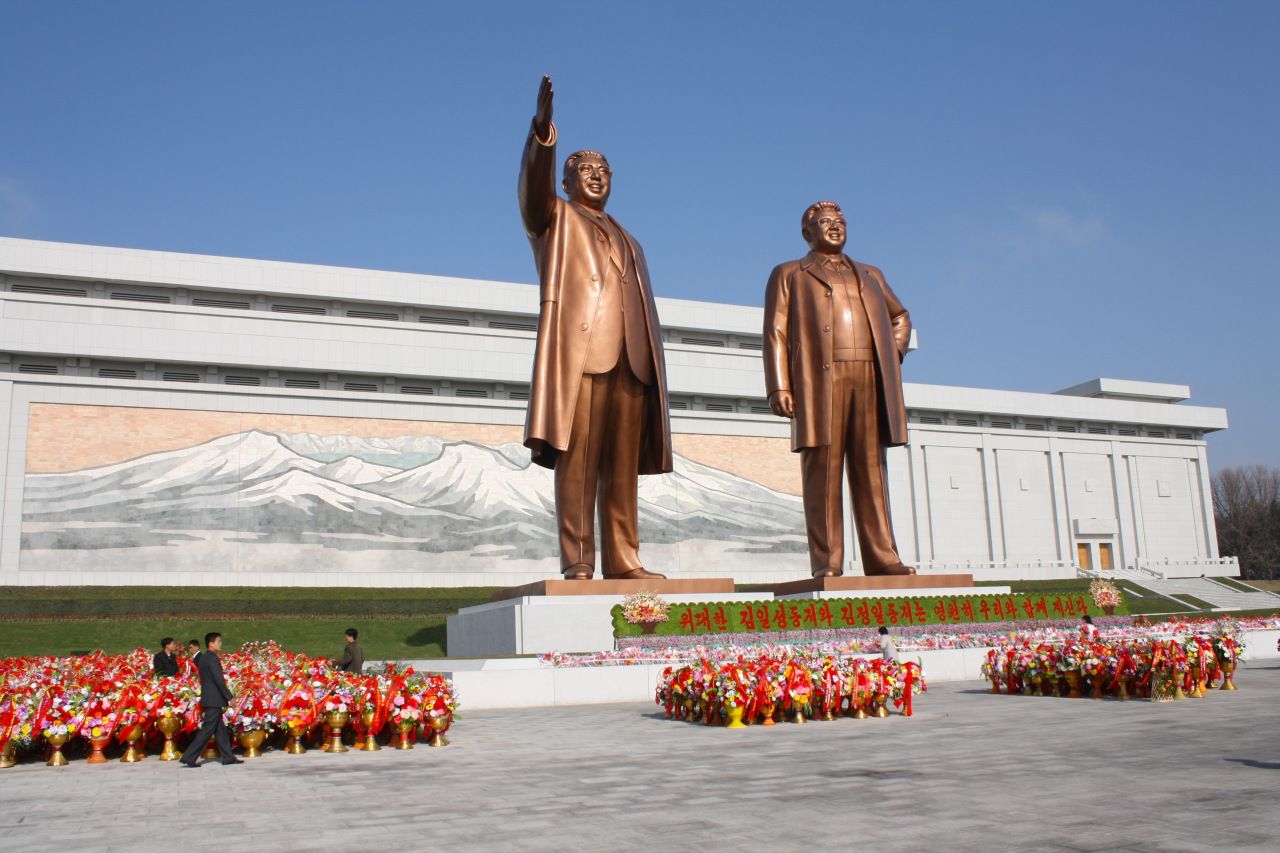
After a final 6:00am wake up call (what you need when your mobile phone has been confiscated) we paid our obligatory respects to the 20 metre tall statues of the Great Leader, and the late Dear Leader, whose's gigantic bronze likeness had only been unveiled three days previously. This photo would meet the authorities standards as they forbid people to take pictures cutting off any part of the statues....you really can't make this stuff up. I also spent €5 on a bouquet of flowers to lay at the feet of the statue, something I hope won't be held against me should I ever again seek employment with the Australian federal government.
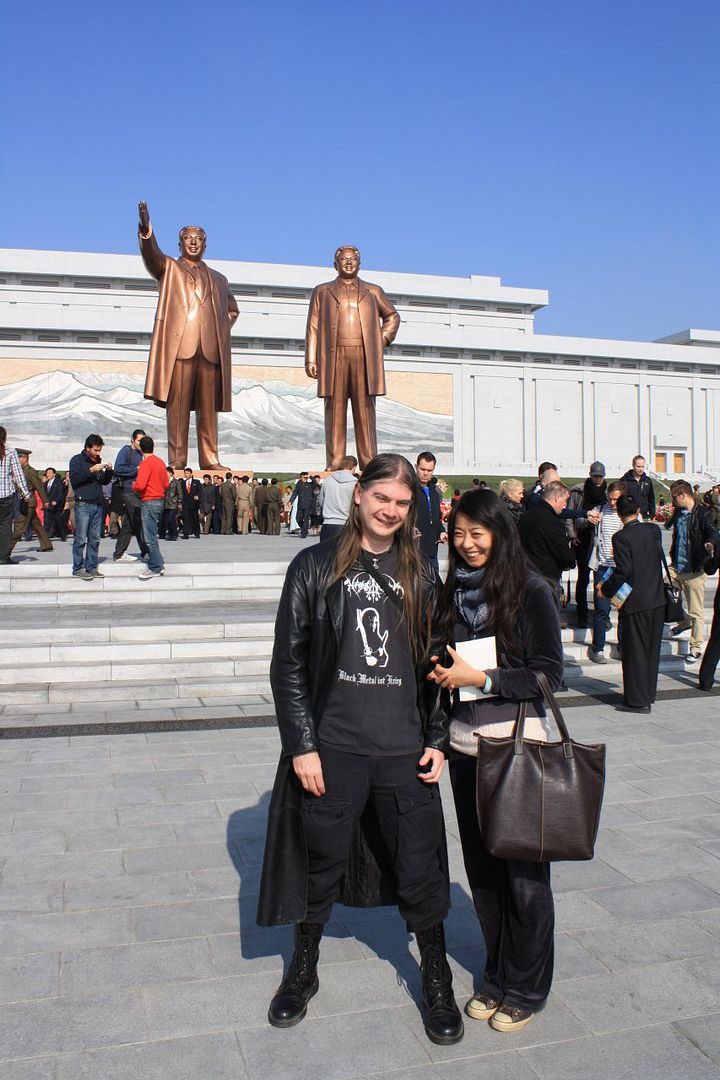
I had to get a picture with our wonderful guide Shan who kept everyone together and was always a reliable source of information and advice on etiquette in this strange land. As you're not permitted to wear sunglasses in the vicinity of the Kim statues we're both laughing and grimacing at the painfully blinding sun, still low in the morning sky.
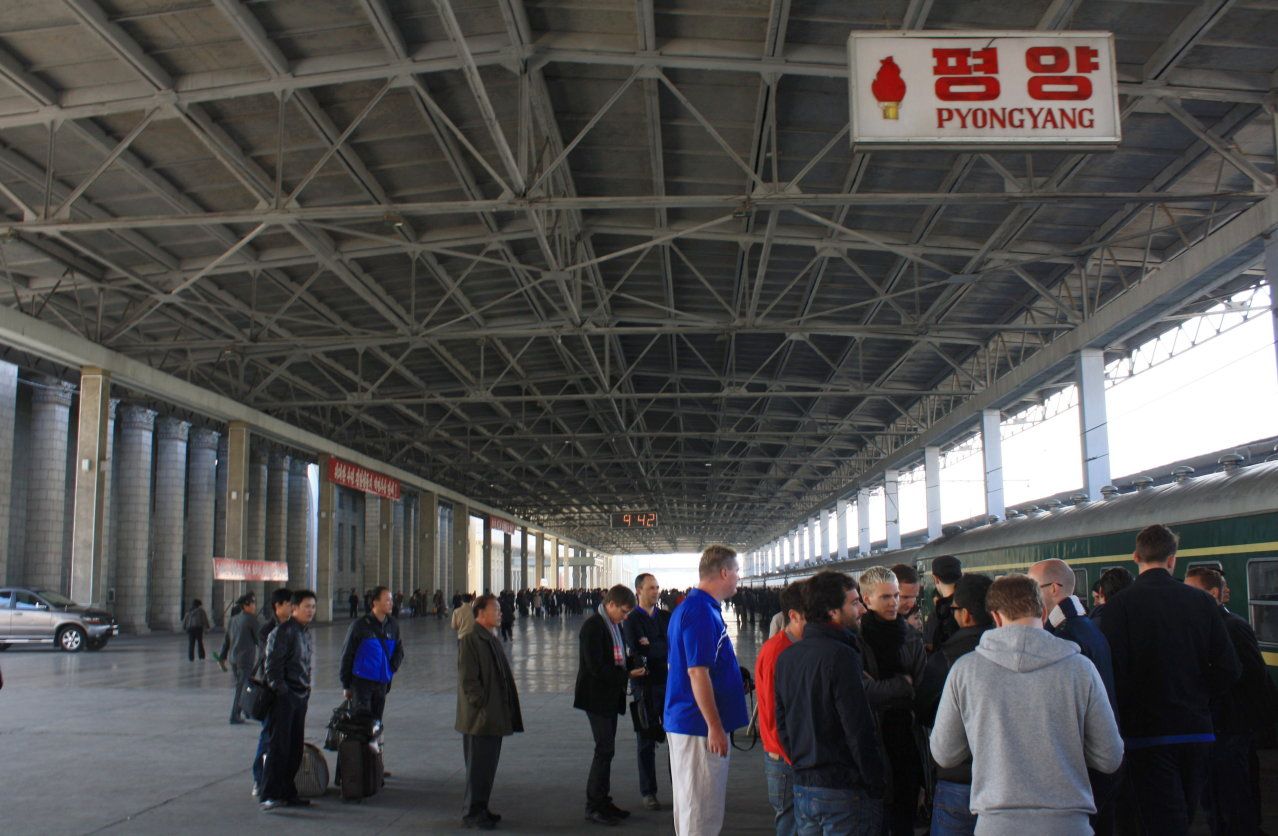
Pyongyang station, where goodbyes were said as only a handful of us were training it out that day, others were either staying an extra day or flying out that afternoon.
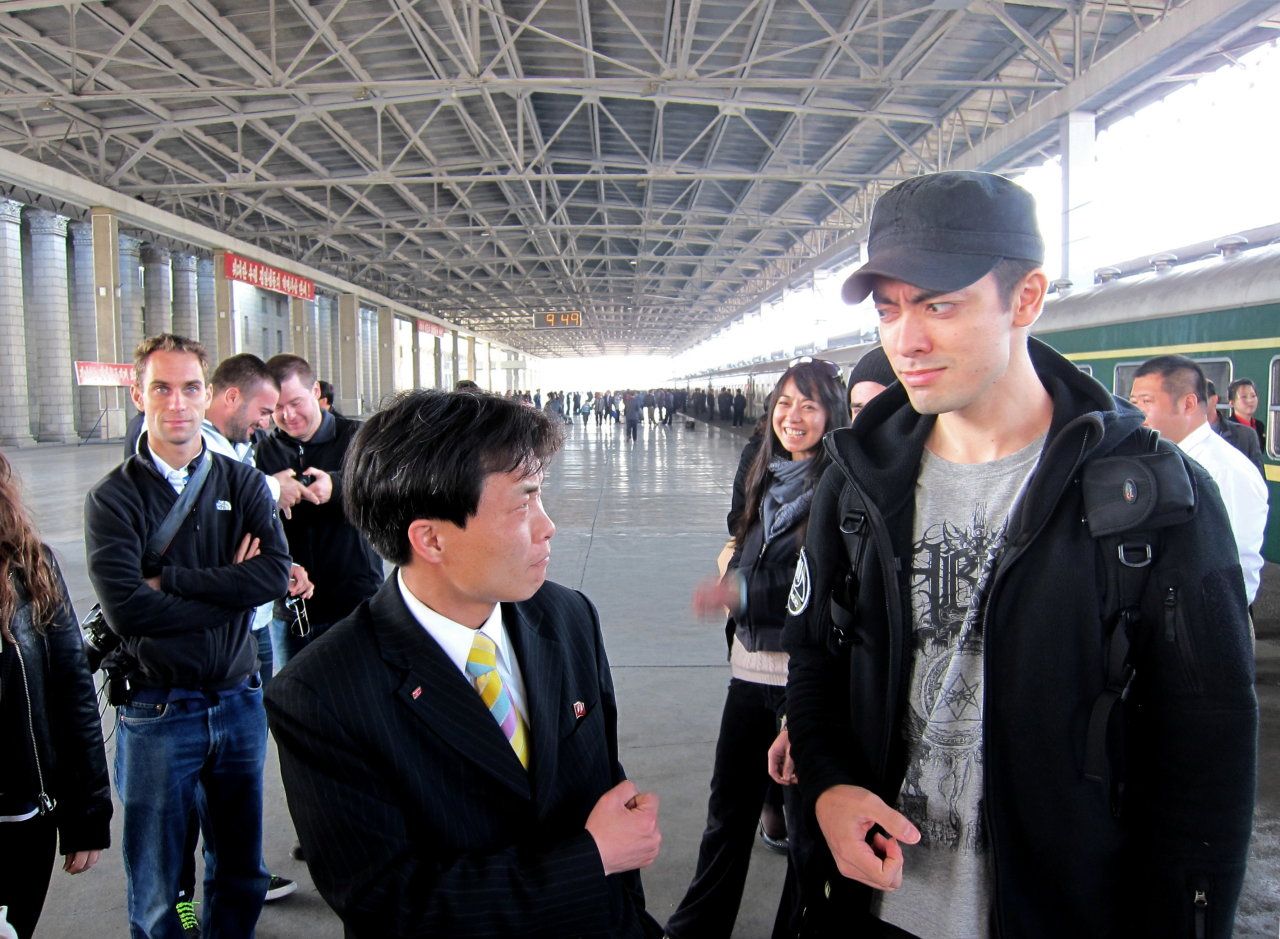
Ash with Mr Oh, the main Korean guide with group B. A pocket-sized dynamo of barely repressed aggression he would switch from easy jocularity to full on rage guy in a heartbeat. When not giving information out for his group he would complain about things like his lack of a wife or the fact that due to overcrowding at our hotel he had to spend one night on a chair in the lobby. Despite his stress-lined face he's actually the same age is me - Ash and I quickly decided he really should channel all this rage positively by being the frontman in a hardcore band. In this picture Ash asked him to do his rage face one more time and Mr Oh is shouting “WHAT?” and obligingly making this face. You can see that his antics are also greatly amusing Shan in the background.
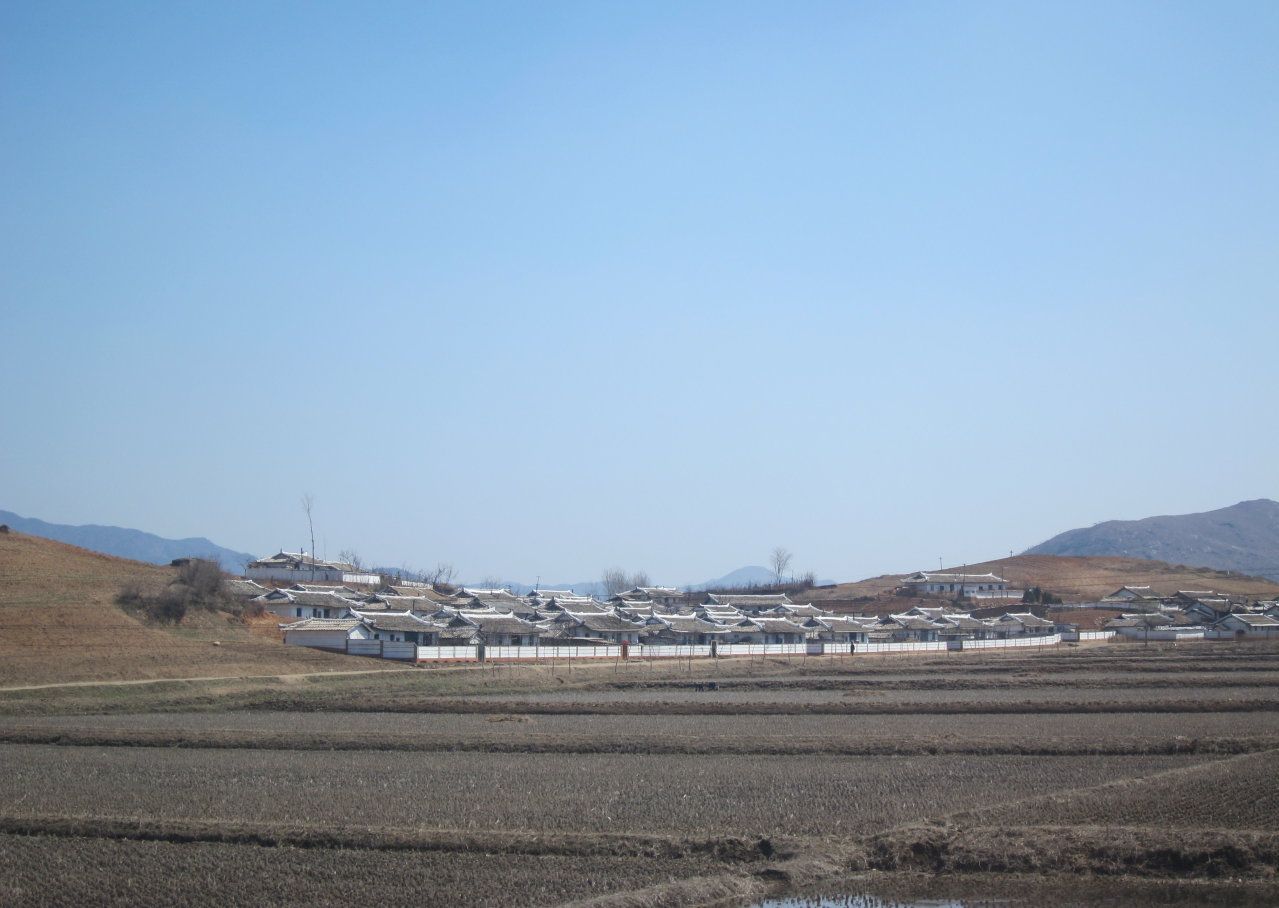
After leaving Pyongyang the train rumbled through what was mostly farming landscape as almost all the non-mountainous area of North Korea is turned over to agriculture. The reason everything looks so dry and dead is not due to mismanagement as many in the media including the BBC have claimed, but the climate. Despite being April it was still bitterly cold at times, and Richie told us that just weeks before there had still been snow on the ground. With the Spring rains would come greenery.
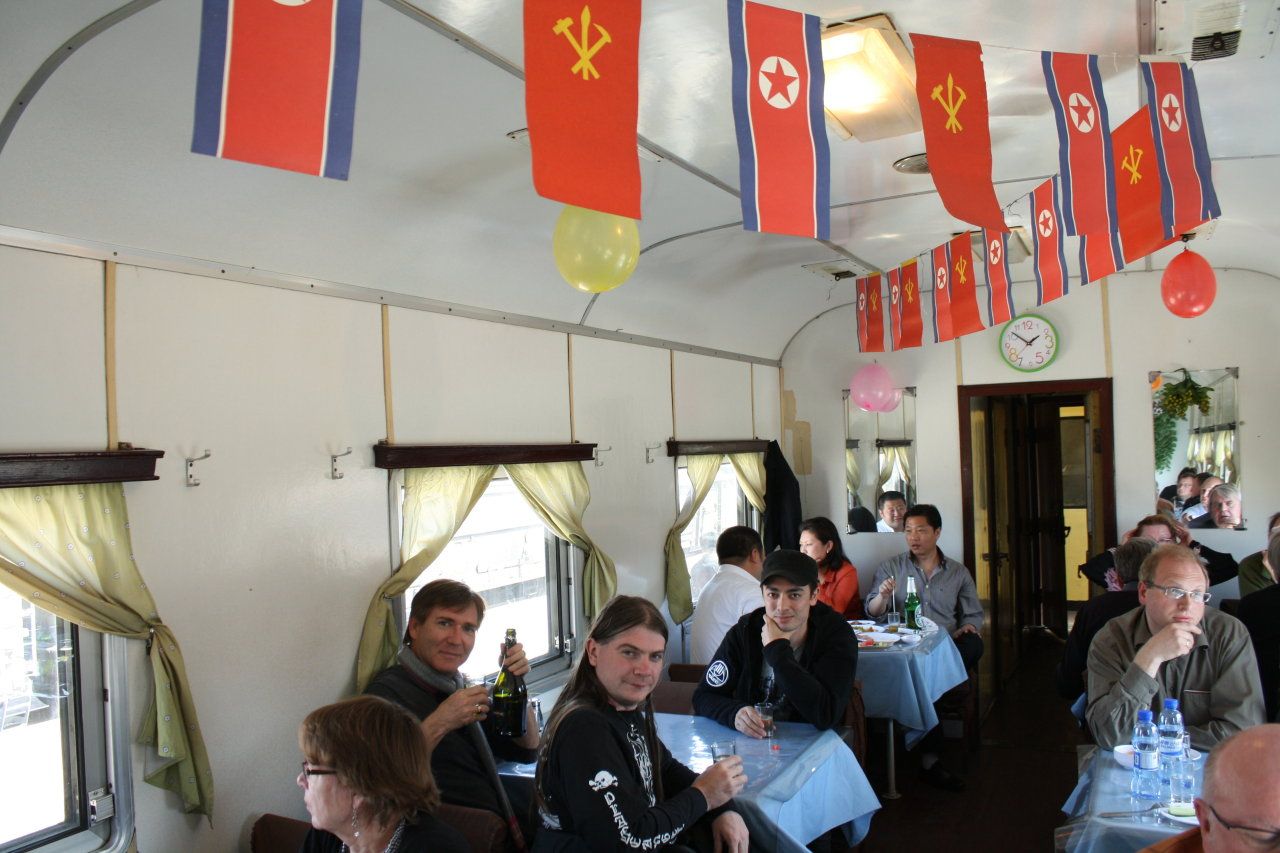
Around midday we wandered down to the dining car where for just €5.50 we got an incredible 7 course lunch finishing our run of large and delicious meals in North Korea. We were joined by a couple of our fellow travellers, one of whom pictured here was kind enough to crack open a bottle of champagne he'd been saving and shared it with Ash and myself. We figured that aside from maybe Kim Jong-un and his inner circle we just might be the only people in the whole country drinking champagne at that point. We toasted the end of a once-in-a-lifetime experience while under the flags of the state and the Workers Party of Korea as the dry and empty landscape rolled slowly by.
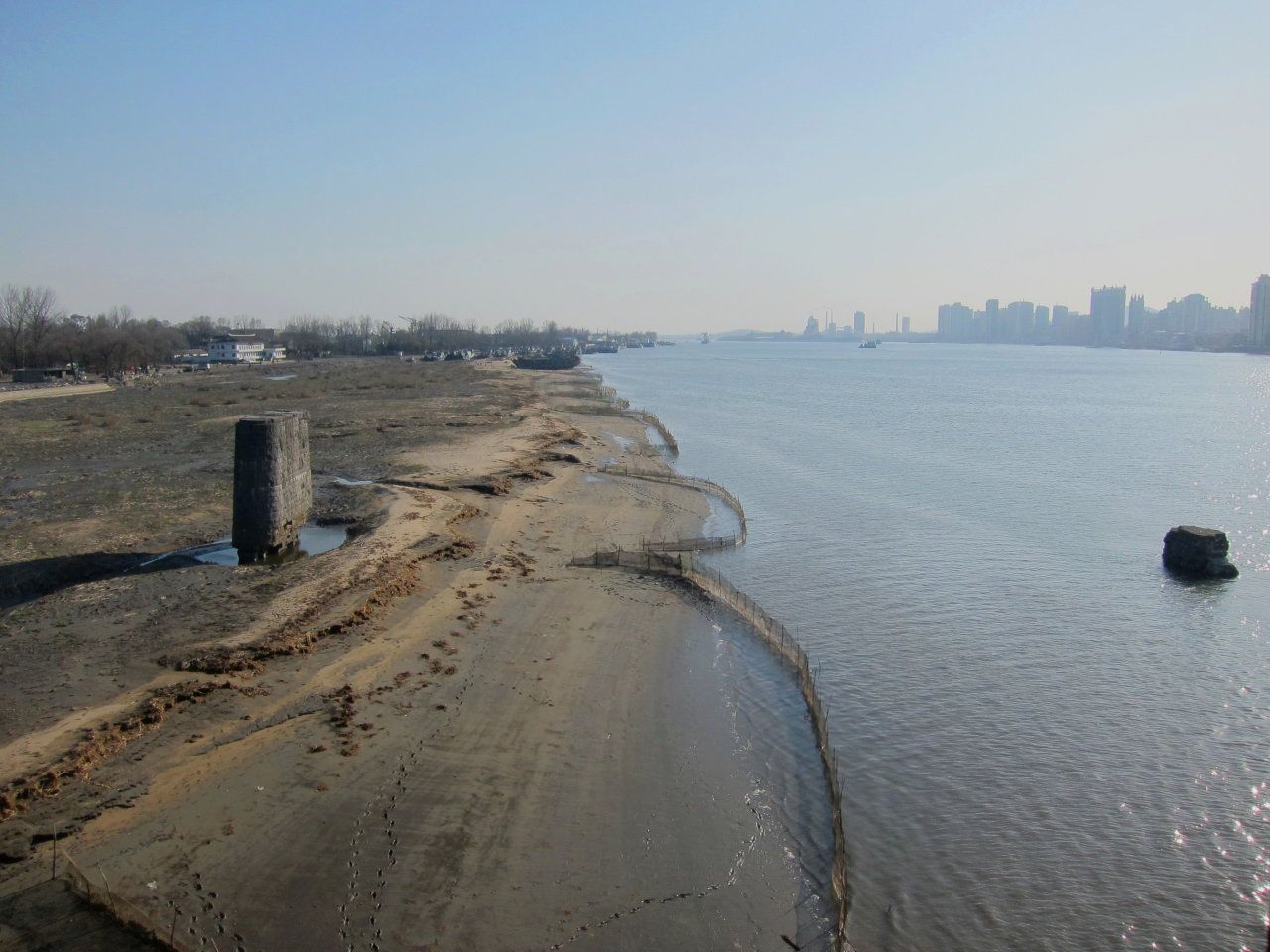
Around mid-afternoon the train rolled into Sinuiju on the Korean/Chinese border having come 225.1km from Pyongyang. There we were searched more thoroughly than I've ever been searched before.Thankfully they didn't look through my camera to see all the photos of soldiers I wasn't supposed to take and the customs agent almost found the stash of North Korean currency I was illegally trying to smuggle out of the country but stopped just before he reached my hiding place. This process was accompanied by the strange music I noted in the video above and it was probably over an hour before everyone on the train had been searched and had their papers checked then finally we pulled out of the DPRK. Here you can see the contrast between Sinuiju, North Korea on the left bank and Dandong, China on the right.
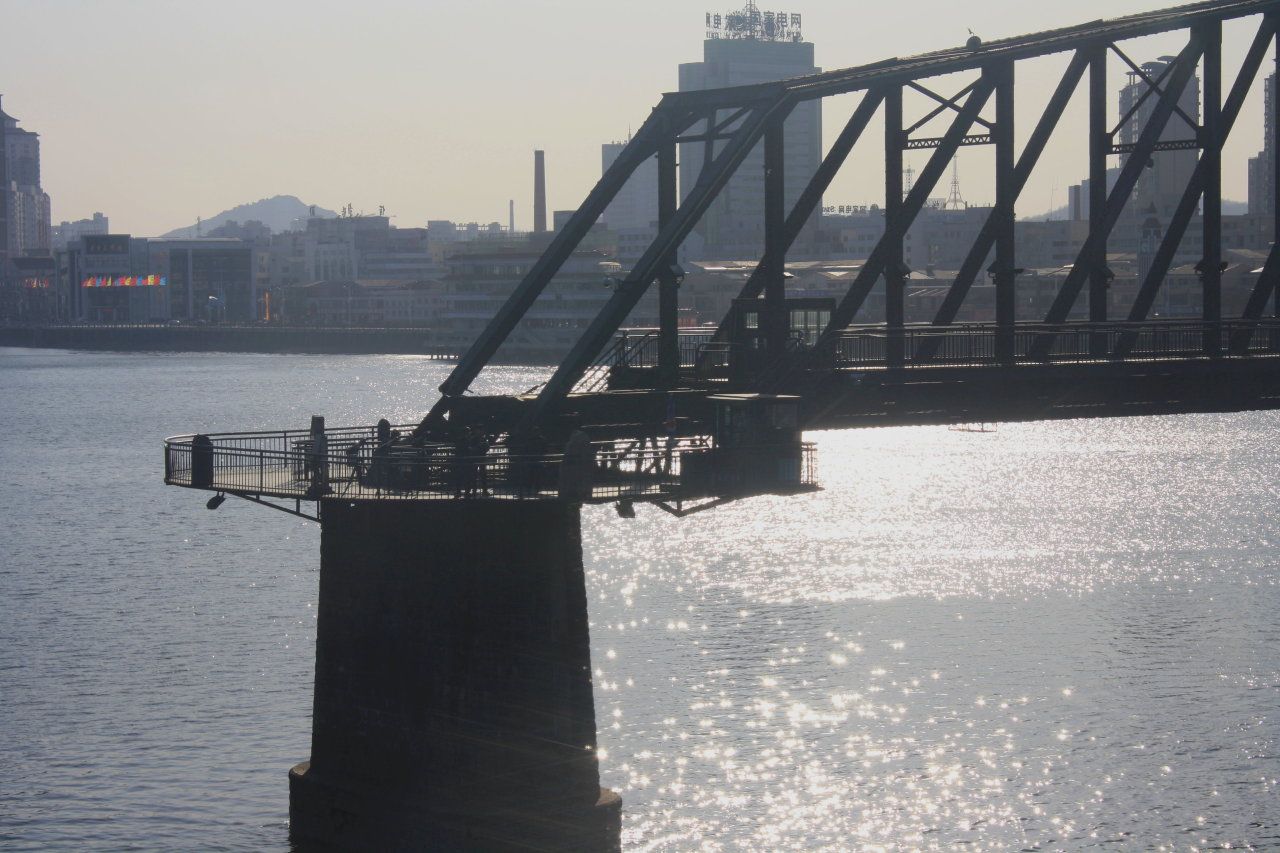
The Sino-Korean Friendship Bridge spans the Yalu River between North Korea and China, running parallel to it is another bridge which was bombed by the US Air Force during the Korean War, some of the old pilings are also visible in the previous shot. Now known as “The Broken Bridge” a viewing platform has been built at the end of the last span, and curious tourists come here to stare at North Korea.
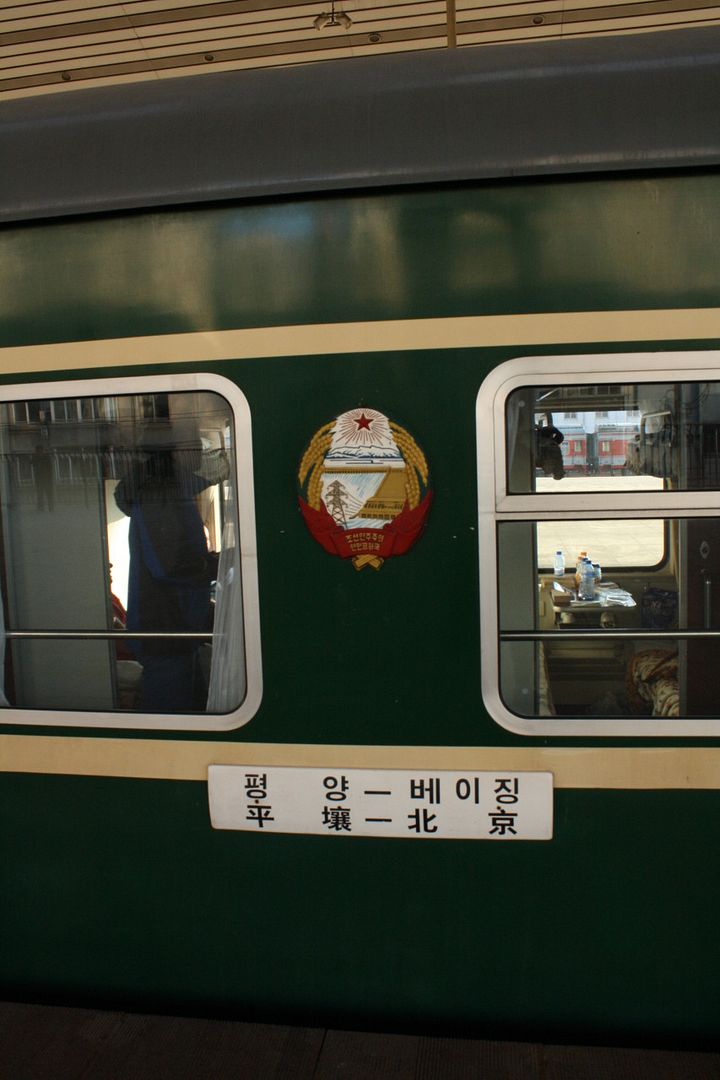
The state emblem of the DPRK, taken as we stepped off the train at Dandong station after a similarly lengthy but less exhaustive series of checks by Chinese customs. And that was it. Despite what many have said in the past about visiting this country our journey into North Korea was safe, enjoyable and aside from the beds, very comfortable. I know this is less exciting than tales of privation, danger and barking drill sergeant-esque guides ( Mr Oh did his best) but what is written here is what happened. I would strongly urge anyone interested to see it from themselves while they can.
On the first day our group was asked if we minded being filmed as KITC had provided a cameraman who would document our tour and create a DVD which we could buy at the end of it. Since no one objected he tagged along and intercut footage of us with stock clips and narration, all accompanied by cheesy music. At the time no one had any idea this would be uploaded to YouTube, but considering he managed to cut this in a matter of hours, it was obvious he had access to decent computing gear. So if anyone's interested in seeing more of what we saw accompanied by a soundtrack of bouncy North Korean pop music then here you go. Just about every time you see me in this I'm either taking a picture or fiddling with my camera, but as I hope the above demonstrates, such work is not done in vain.
Finally, due credit must go to both Ash (more of his photos and thoughts on our time within the DPRK can be found here) as well as Shan from Young Pioneer Tours for letting me highlight some of their photos here amongst mine own.
On the train out, Richie asked me if my perceptions of North Korea had changed given everything we had experienced over the last few days. I found this question hard to answer at the time, and even having thought about it at great length since getting back, still find it difficult. On one level as someone who considers himself as well informed about North Korea as it’s possible to be (which is not very much really, but I take solace from the fact that the US State Department is equally in the dark when it comes to most matters relating to the Hermit Kingdom. Even though he’d actually passed away several days previously, the first hint that the American government got about the death of Kim Jong-il was when it was announced on North Korean state television. Don’t be fooled by shows like 24 and the Bourne films, they really have no idea what’s going on in the DPRK, the most wilfully opaque country on the planet), I went in to the trip with eyes open, I knew that everything we would be shown was only what KITC, acting as an agency of the ruling Worker’s Party of Korea, wanted us to see. Many of the stops such as the Grand People’s Study House and the Children’s Palace were totally phoney experiences put on just for tourists, whereas many other small moments when we got to talk to the Korean people were far more special. The despotic regime in Pyongyang is rightful condemned in the Western media, but of course people are not their governments, they’re just people, and even the Americans on our tour felt as welcome in North Korea as anyone else on a human level. Given the strict rules that govern visitors I was impressed at how much (relative) freedom we had to walk around and interact with the locals, credit must go to the Young Pioneer team for giving us a experience that was not quite as stiflingly oppressive as it could have been. But no one goes to North Korea for a holiday in a traditional sense; I asked many of the other people on our bus why there were there, and the answer was almost universally “morbid curiosity”. People want to see the last outpost of the Cold War and to see what life was like behind the Iron Curtain before the fall of communism in Europe, or as the Chinese co-worker of someone put it upon hearing this person was travelling to the DPRK, “Why would you want to go there? It’s like how China was 30 years ago”. Exactly. That’s why we all went, and I’m incredibly glad that I did. An unforgettable experience.

After a chaotic check-in process (it appeared the Koreans were bypassing the Beijing Capital Airport’s computer system and booking everyone on to their flights manually) boarded Air Koryo, the national airline of North Korea, and what was my first Russian-built airliner: a Tupolev TU-204. Female flight attendants for Air Koryo are reputed to be some of the most beautiful women in North Korea, all I can say is this one caught me taking pictures and told me off, the first example of many arbitrary rules we would run into in the days ahead.

Our Air Koryo meal - better food than on Singapore Airlines, believe it or not. Something else you don’t get on other airlines is an announcement declaring that this flight was only made possible by the Dear Leader, Kim Jong-il (just one of many feats both amazing and pedestrian that would be wholly credited to a member of the Kim dynasty) as well as another announcement later in the flight stating in a voice breathless with emotion that we had now crossed the border and were flying over the Democratic People’s Republic of Korea. Incidentally the locals don’t like the name “North Korea” as it implies equality with what they refer to as the puppet regime in Seoul propped up by the American imperialists. You’ll get a lot further by always referring to the country as “the DPRK”. Likewise Kim Il-sung is always “The President”, Kim Jong-il is “the general” or “the leader” and Kim Jong-un is also known as “the leader” nowadays.

Sunan International Airport, where on a busy day there may be three or four flights. The brand new terminal building resembled a shed more than anything, but contained passport control, baggage claim, customs, check in and a gift shop, all in about the same area as the Cathay Pacific lounge at Heathrow, although with rather fewer creature comforts but rather more photos of Kim Il-sung and Kim Jong-il. Once we had our luggage everyone on the tour’s mobile phones were confiscated and separated into groups, those of us leaving by train would be given ours back at the station but forbidden to unwrap them until we’d crossed back over the Chinese border. Interestingly something that Pyongyang and Melbourne have in common is that we are both one of the few major cities worldwide that don’t offer rail links to our respective airports. Therefore we had a bus ride through some of the countryside before we got to Pyongyang itself. On board we met Shan from Young Pioneer Tours who would be our sub-group's main guide, the other people on the tour as well as our chief Korean guide, Miss Jong, who gave us an introduction to North Korea which contained the first of many errors of fact we would encounter in the days to come.

Our home in Pyongyang, the Raynggang Hotel, with the foyer looking like a 1970s East German disco. Once at the hotel you must surrender your passport which will not be returned until you check out. At no time can you leave the hotel without your Korean guides. Thankfully the foyer also had a bar in it, and after dinner we got talking to some of the more hard-drinking members of the tour, enjoying North Korea’s world famous Taeddong beer at just 50 Euro cents a 600 ml bottle.

North Korean state television is exactly the same as how you’d imagine it. They now have two channels, the first was showing a congress of the Worker’s Party of Korea in which some old guy was droning on while the Rubeneque figure of new leader Kim Jong-un sat impassively through the regular storms of applause from all the other delegates, while the other featured the sort of saccharine singing and dancing kiddies that we ourselves would experience at the Children’s Palace several days later. This screenshot of the Juche Tower was sort of a station ident (even though there’s only one station).

The afore mentioned Taeddong beer of which many were enjoyed over our stay..

The view from room 413 at dawn. The hotel was in a sort of sporting district, the road into the centre of the city was lined with different stadiums for different sports. One other thing that must be mentioned about the hotel is the beds, very much like a billiard table with sheets, Ash actually hurt himself falling on to his when we first arrived. The only way to get to sleep was to booze up heavily during the evening before crashing, and I can report that this was accomplished every night without fail.

The hotel was opened in 1989 and like many things in North Korea hasn’t been renovated since and is already falling apart. Some of the reviews are less than complimentary.

Our first destination was the Demilitarised Zone (DMZ) that separates the two Koreas. On the way we drove through the Korean countryside most of which looked like this. Around 70% of Korea is mountainous, and those bits that can be farmed are subject to freezing winters, and that’s before you consider the decades of underinvestment in agriculture the country has suffered. It’s no wonder the country is reliant on food aid to prevent the populace from starving, and even with this aid there have been several major famines over the last twenty years. There are not many places where you can see oxen pulling ploughs in 2012, and while a handful of tractors were in evidence during the several hour bus journey, an awful lot of the farm work was being done by animals or by hand. This is the side of North Korea your guides would probably prefer you didn’t see, but as it’s happening along the main North-South highway there’s nothing much they can do to hide it.

And this is what that main highway looks like, taken at a rest area about halfway between Pyongyang and the DMZ. No need to wait for the traffic to clear, there's almost none.

This sign I found in a room inside the rest area is about typical of North Korean propaganda. Amuse yourself by counting the errors contained within these few brief paragraphs.

The hedge down the middle of the road is a uniquely North Korean feature, in places outside Pyongyang these disappeared, possibly to allow the road to be used as an emergency runway in a time of war.

The edge of the 4 kilometre wide Demilitarised Zone which, despite its name, is the most heavily militarised strip of land on the planet and has been since the Korean War halted in 1953. Something like 100,000 soldiers watch each other from both sides of the border, and both sides conceal huge numbers of tanks and artillery pieces that we know about and other defensive systems that are only rumoured. Supposedly bolstering the 30,000 odd American troops in the South are tactical nuclear weapons, while the North has allegedly built a series of massive dams that are rigged with explosives, so if war were ever to break out they could detonate these and send raging floodwaters down into Seoul, the South Korean capital. In the old days the two sides used to broadcast propaganda messages across the divide and jam each other’s radio frequencies, although this behaviour has ceased in recent years.

A Korean People's Army officer explains the layout of the DMZ and highlights some of the defences the DPRK has against an invasion from the South.

Accompanied by soldiers our coach slowly moved through the fortifications including massive concrete blocks which they can trigger to fall on to the road, obsructing the path of enemy trucks and tanks.

What is known as the Joint Security Area (JSA), the only place along the border where North and South Korea come face to face. Just near here is the so-called Bridge of No Return, where prisoner exchange swaps took place after the Korean War ended. While the North Koreans continually man the border the South Koreans and US merely observe it through CCTV cameras from the large building, and only send soldiers out to stand guard when tourist groups visit their side. I called the Americans “lazy bastards” for ruining an iconic Cold War photo I could have taken, and this abuse I believe endeared our guide, Miss Jong, to me.

The two guards watch each other as much as they watch the actual border. If one attempts to defect the other is under strict orders to shoot him.

Located a short distance from the JSA is the former village of Panmunjeom. In this building at this table over several years an end to the fighting in Korea was negotiated. Of course the war would have been over very quickly had the DPRK not been bolstered by weapons and personal from the Soviet Union and the newly-declared People’s Republic of China, however there was no mention made of this assistance by Miss Jong or our military guides. Technically the Korean War never ended, a ceasefire was signed on 27 July 1953 however no armistice or truce has ever been declared. This means that the war has been going on for over 60 years, and that Korea, the DMZ in particular, is the last outpost of the Cold War.

The original ceasefire agreement (or “American surrender” as our military guide put it) in the North Korean Peace Museum, next door to the building where it was originally signed. The JSA was also the site of the infamous axe murder incident of 1976 when the American forces attempted to cut down a tree within the DMZ that the North Koreans claimed was planted by Kim Il-sung. A fight broke out between the two groups of soldiers and at the end of it two US personal had been killed with one of the axes they were attempting to cut the tree down with. This axe is now proudly on display in this museum.

A nice group photo with a member of the Korean People's Army. Despite never feeling in any danger personally, the DMZ is still very a tense place swarming with armed soldiers, which possibly explains the shortage of smiles in this picture.

Looking across the DMZ towards the fake town of Kijong-dong (meaning “peace village”) to what used to be the world’s tallest flagpole. In the 1980s the South Koreans built a 98 metre high flagpole in the single village they are permitted to have within the DMZ that flew a 160kg South Korean flag. This would not stand so the North Korean government responded with a 160 metre tall flagpole that flies a 270kg North Korean flag. Paging Dr Freud.

We then drove to Kaesong, the most southerly major city in the DPRK. What continually strikes you about North Korea is the lack of motor vehicles due to both low incomes and strict petrol rationing (even the North Korean airforce have very limited non-simulator training due to the cost and difficulty of obtaining fuel that being an international pariah entails). This means that just about all ordinary people have to walk or cycle everywhere resulting in scenes like this.

In Kaesong we toured this old Confucian university that’s most prominent display was evidence of the fact Kim Il-sung once visited it.

Outside a gift shop where many propaganda posters were bought I posed with a local woman wearing a variation on the traditional Korean dress known as the Chosŏn-ot but colloquially referred to as a “Christmas tree dress” for obvious reasons.

Traditional Korean food which was delicious, but the beer that accompanied it was awful - it tasted like soy sauce and dirt, first time I can recall neither Ash nor myself not finishing booze.

On the way back we stopped off at the town of Sariwŏn to stretch our legs by climbing this hill.

At the base of the hill were displays showing various aspects of Korean history, here Miss Jong is explaining how kimchi is made in front a tiled mural showing the making of kimchi.

View of Sariwŏn from the top of the hill.

Everywhere in North Korea you see such propaganda posters, anywhere else in the world such valuable real-estate beside roads would be taken up with advertising hoardings. I especially enjoy the guy yelling about the “high-tech” computers on the left. While no one would argue that state propaganda dominating public spaces is a good thing, you have to ask yourself that if this was replaced for an ad for McDonald's, would it really be such an improvement? Surely there must be some ideal middle ground betwixt the twain.

Sunset on the way back to Pyongyang.

This incredible structure is the Arch of Reunification, erected in 2001 to show how committed the DPRK and the Kim dynasty are to the reunification of the two Koreas. Further editorialising on this monstrous irony (and sculpture) is not needed, so instead will just say this was a great moment for me as Ash and I had been talking about going to North Korea for years, and it was such an amazing feeling to have finally got there. As an icon of the DPRK standing underneath the Arch really bought it home for me.

Our trusty mini-bus. Earlier in the day a tyre had burst on the rough as guts North Korean “highway” but thankfully was fixed in short order. KITC or the Korean International Travel Company is the state agency that organises all tours within North Korea. They provide the bus, the driver, the guides, the hotel and tell the guides what tourists can and can't see and at what times.

The next morning we headed into the very centre of Pyongyang, Kim Il-sung Square. Our Korean guide told our group it was the largest square in the world, when in fact it's only the 30th largest yet it can still accommodate 100,000 people at one time. The people standing and sitting around were taking a break between rehearsals for the big 100th anniversary parade which was due to take place the next day.

Rockin' the Deutsche Demokratische Republik (the old East Germany) shirt I'd bought at Checkpoint Charlie in Berlin, much to the amusement of the two Germans in our tour group. The lines drawn on the ground are marks similar to what stage actors would be given, telling the people where to stand. It's often been said that Pyongyang is less like a functioning city and more like a film set filled with actors playing their part in the regime's real life propaganda play, and at moments like this you can almost believe it.

This faux-ancient Korean palace is actually the Grand People's Study House.

It's supposed to be sort of a communal library/school where anyone can come to study and take classes, but like everything in North Korea it is really just an immense shrine to Kim Il-sung. Rather than being in some crypt at the centre of an imperial tomb, this is the first sight that greets you as soon as you step through the massive front doors.

Not to be overlooked, this subdued and tasteful portrait of Kim Jong-il gets a prime spot on the wall just up the escalators from the statue of his father.

It is claimed the building is capable of holding 30 million books, and while it's certainly large enough to do so, most of the interior space is taken up with huge empty lobbies such as this one and long, dimly lit, corridors where cold marble meets rising damp.

After being led past dozens and dozens of locked doors we were finally allowed into one of the rooms they permit visitors to see. And this is it, a large and mostly empty room with a small number of books up the back and on the side, but mostly taken up with special desks that Kim Il-sung ordered made as he declared it's easier to study when you can adjust the angle of your desk. Therefore the room is not really about leaning but rather a tribute the industrial design genius of Kim Il-sung.

The next room we were taken to was even stranger. Apparently an English class, when we walked in the students were being instructed on how to spell and pronounce the word “walkman”, not something that would be very useful in the West, not that they could ever go there anyway. The type of teaching seemed to be nothing more than call and response rote learning, and despite repeated assurances that anyone could come to the Grand People's Study House and learn, one gets the feeling this was put on only for the tourists benefit and that once we'd all left for the day these people would have been hurried back to their work assignments. While traipsing around the endless echoing hallways I tried to quiz Miss Jong on how the place worked and if she ever came there to study. While normally bursting with information about all things Pyongyang, she became rather evasive and her vague answers about coming here to relax did not ring true to my perception.

After visiting a professor who claimed to be an expert on North Korean social sciences who you could ask anything (no one could think of a question, which is what they both expect and desire) we went upstairs to a music room, which was full of cassette and CD players. They put on some Beatles for us, but you can't imagine the locals would be allowed to listen to such degenerate Western noise. Not particularly impressed by a song I'd heard thousands of times before I wandered around to look into corners of the room Despite the massive size and liberal usage of marble found in these monuments to the Kim dynasty, there remains a sort of communist cheapness that is found in every building along with the omnipresent smell of stale cigarette smoke and boiled cabbage. For example consider this furniture which looks like it was rescued from a skip outside a recently closed high school in the 1970s, it's clear they spent most of the money on statues and paintings of the Leader leaving very little for everything else.

And when was the last time you saw a card catalogue in any sort of library? They had some computers running what looked like pirated copies of Windows 95, but given how little experience most North Koreans would have of computers it's doubtful they get much use.

We then caught a lift to the top floor which provided magnificent views of the ongoing preparations in Kim Il-sung Square. Pity about the smog, but that's what you get for having a coal-fired power plant near the centre of town.

Ash, the great communist dictator acknowledges his loyal subjects.

Back in the square and the people (who were just Pyongyang locals who were drafted into the performance) were now practicing their synchronised movements.
Being surrounded by thousands of people all moving as one like the in the famous North Korean mass games was an incredibly surreal experience that hopefully this video Ash took conveys.

The Tower of the Juche Idea. Juche is the guiding philosophy of North Korea, first articulated in the mid 1950s that had by the 1970s almost totally eclipsed Marxist-Leninism as the official state ideology. Put simply it's a mixture of economic autarky, quasi-fascist and militarist hyper-nationalism with elements of traditional Korean traditionalism thrown in for good measure. At 170 metres tall the tower is a satisfyingly petty 80cm taller than the Washington Monument. Unfortunately it was closed when we were there as normally it can be climbed for peerless views of Pyongyang. Opened on Kim Il-sung's 70th birthday in 1982, each of the 25,550 bricks used in it's construction represents a day in the life of the Great Leader.

Still, never mind. Up next was Monument to the Party Founding, unveiled in 1997 as a celebration of 50 years since the foundation of the Workers Party of Korea in 1947. Apparently signing off on the design of this monstrosity was one of Kim Il-sung's final actions before his death in 1994. In addition to the stylised hammer and sickle representing the worker and the peasant, the party also added a paintbrush to represent the “working intellectual”.

Opinions on the subject vary, however this must be a candidate for the most hideous structure ever erected by mankind. I think it's brilliant.

Each of the towering hands gripping their respective tools are 50 metres high to signify 50 years since the founding of the party.

After lunch we got to ride on the famous Pyongyang Metro. Allegedly the deepest underground network in the world, like the Moscow Metro on which it's based it was designed to double as a fallout shelter in the instance of a nuclear strike. As with the Moscow system many of the stations are stunning works of art in their own right.

Like the trams on the streets above, the Metro's rolling stock was built in the former East Germany and after years of shunting around the former East Berlin, was sold to the North Korea after the Berlin Wall came down. Despite claims to the contrary, the only domestic work done on the trains was the addition of these portraits.

The first station photographed above is Puhŭng or Revitalization and this is Yŏnggwang or Glory. All the stations have names like this, I would have liked to have visited other stops such as Innovation, Red Star, Comrade and my favourite: Complete Victory (In Battle).

The escalators are more than 100 metres in length seemed to take forever to finally return us to the surface.

The Arch of Triumph, naturally modelled after the Arc de Triomphe in Paris but as with the Juche Tower a deliberate 10 meters taller. Also completed in 1982 on Kim Il-sung's 70th birthday and again constructed of 25,550 bricks, it was built to celebrate Kim Il-sung's leading role in the defeat of the Japanese in 1945. Once more the deeds of all others are rendered inconsequential compared with those of the Great Leader and the real reasons the Japanese were forced out of Korea go unmentioned.

Continuing this theme our next destination was the clunkily-named Victorious Fatherland Liberation War Museum, where one can learn more about Kim Il-sung's almost single handed defeat of the Americans this time, during the Korean War. Here is a small part of the massive collection of weapons and vehicles the Korean People's Army captured off the UN forces.

Captured American tanks.

A 360 degree panoramic painting/diorama showing idealised scenes of North Korean victories and American defeats. Not shown or mentioned anywhere, the USSR and China who contributed more to the war's eventual outcome than you know who.

My favourite scene from the painting, here we can see a cowardly American general cowering behind a bush in a humiliating surrender while a laughing DPRK soldier comes accept it.

The museum is located not far from the famous Ryugyong Hotel, also known as “the worst building in the world” and sometimes “the hotel of doom”. When construction began in 1987 it was intended to be the tallest hotel in the world, and it would have been had the country not run out of money in 1992 after the collapse of North Korea's largest trading partner/benefactor, the USSR. With no funds available to resume construction the incomplete structure stood as a colossal monument to the failure of communism, and the regime responded by airbrushing it out of propaganda photos of Pyongyang, no mean feat considering it's 330 metre height. In 2009 an Egyptian company won the contract to finish construction and while progress has been made, rumours that it's opening would coincide with the celebrations for the Kim Il-sung centenary came to naught.

Socialist realist sculpture at it's finest. It's little wonder that African dictatorships are lining up to have statues of themselves made by North Korean artisans.

This and the previous picture were taken at huge war memorial next to the museum. Interestingly in all the Korean propaganda everyone seems to be yelling. Possibly about defeating the imperialists, or considering the subtext implied by my choice of angle here, maybe about something else.

After a bit more of a wander around we enjoyed a delicious duck BBQ dinner. These monolithic apartment blocks lined the street outside the restaurant. Such structures are typical of communist countries, beloved for both their cheapness of construction and the less tangible ideological benefits whereby individual expression becomes difficult when everyone is living almost identical lives.

Then it was off to the Taedonggang Diplomatic Club or just “The Diplo” for short. Considered Pyongyang's hottest nightspot, although since it's only competition would be the front bars of the 6 hotels in town that may not be saying much. While the Korean peninsula may be rendered accurately on the wall of the foyer, sadly the same cannot be said for the rest of the world's geography.

After the cold and austere buildings found everywhere else in the country, the gaudiness of the Diplo was a shock to the system.

This was a quite a surreal moment, smashing back beers and vodka and playing pool with Kylie Minogue thumping out on the stereo while underneath the flags of the Worker's Party of Korea in the world's last Stalinist state. On the way back to the hotel everyone was most merry and Miss Jong, who had entertained us with her beautiful singing voice on the way back from the DMZ, finally got some reciprocal performances, though none threatened the bar she had set at a height rivalling that of the Juche Tower. Others sang their national anthems, I told some off-colour jokes stolen from Frankie Boyle and Jimmy Carr while Ash did a splendid rendition of Monty Python's “Sit on My Face”. I'm not sure if Miss Jong appreciated our material but all I know is that moments like this are not what most people would anticipate when thinking about travel in North Korea.

April 15th, the day of the sun, the first day of Juche 101 and 100 years since the birth of Kim Ils-sung in 1912. Also on that day apparently some boat called the Titanic ran into a spot of bother in the Atlantic, but why would you care about some old leaking tub when you get to visit the Revolutionary Martyrs Cemetery to pay tribute to the heroes of anti-Japanese struggles as we and all these soldiers did?

The bust of the woman in the centre is that of Kim Jong-suk, first wife of Kim Il-sung and mother of Kim Jong-il. She features in quite a bit of the state propaganda however as she died in childbirth in 1949 her role is less prominent.

As I was photographing the massed troops this little girl wandered into frame, couldn't have set this up better if I'd tried.

At the bottom of the hill where the cemetery was located was a fun park, although in North Korea, even the rides and play equipment are shaped like missiles.

At an oval in the park they were having this festival which mostly consisted of a large numbers of foreign simpletons being entertained by childish party games while a brass band and female dancers did their best to create an atmosphere of 1950s wholesome fun. In between these bouts of enforced frivolity other acts would come on, and these girls in panda costumes were one of them.

At one point this little girl grabbed me and for some reason delighted in poking me in the face. As you can see she's having a great time doing it, not sure if it was because I was an interesting foreigner or maybe Koreans would object to being prodded in such a manner but whatever, she seemed happy.

I got off lightly though compared with Ash and Shan, they were positively mobbed by kids.

Wide shot of the oval where this festival was taking place.

A different type of hideous sculpture.

On the way back into Pyongyang this was a frustratingly close as we were permitted to get to the Kumsusan Palace of the Sun. Originally the residence of Kim Il-sung, upon his death in 1994 it was turned by Kim Jong-il into the world's largest mausoleum, it makes Lenin and Mao's tombs seem puny and unimpressive by comparison. This was originally on our itinerary but at the last minute all foreigners were banned from there, possibly due to the planned installation of Kim Jong-il's preserved body along side that of his father.

Once back in town we visited a unique flower show. Unique because it only really featured two species of flowers, yep you guessed it, the Kimilsungia (an orchid) and the Kimjongilia (a type of begonia).

To liven things up, there were little displays scattered throughout the flowers. Of course there were little plastic missiles, tanks and jet fighters, but there were also models of buildings as you can see here and best of all, a miniature revolving version of the Monument to Party Founding, which Ash and I decided would make a great centrepiece at the dinner table.

Diorama of stupendous crappiness showing all the peoples of the world worshipping the Great Leader, the dude in the pink cowboy outfit on the left is holding a book labeled Juche. Kim Il-sung is shown in photographs alongside those great statesmen Mao Zedong and Fidel Castro while you can see the flags of the various regimes who North Korea could count amongst it's international friends, a veritable rouges gallery of states.

Everywhere you go in North Korea his face is always benevolently smiling down upon you.

While only specially invited guests got to see what was going on at the centre of the celebrations in Kim Il-sung Square (basically this) that were so massive they were visible from space, the rest of us plebs got to see a smaller parade of soldiers which, along with the rehearsals we'd witnessed the day before, gave a real sense of the sort of military pomp and splendour the DPRK does so well.

We only caught the tail end of this parade and as soon as the last truck had disappeared the crowd began do disperse, guided along the way by one of Pyongyang's famous traffic girls seen here in the lower right doing a better job than any traffic light or sign ever could at managing the flow of people and vehicles.
To show why the traffic girls have become an icon of Pyongyang and the DPRK please watch this amazing video that neatly captures the stillness broken only by strictly regulated movement that defines life in North Korea. This music also made an appearance as we were leaving as I shall describe below.

This rather severe looking building houses the Pyongyang Military Circus, one of the few North Korean groups that perform overseas. Rather than a brightly-coloured bigtop they were housed in a grey marble edifice, but at least the show was fun.

I hadn't been to the circus since I was a small child, and was surprised at how much I enjoyed it. While the performers were incredibly skilled, for me one of the chief joys was the awesome 1970s-style progressive rock soundtrack many of the routines were backed by. Several of the acts from that day (including the tightrope walkers pictured here) were filmed and uploaded by a kind person to YouTube. Despite a few empty seats behind the ring it was mostly a full house and the show was well received by all.

However this was a surprise, after the last act these guys shot across the roof of the place on a wire while a photo of grenade carrying soldier was shown on the main screen.

Then at the end when all the performers came out to take their bows an image of missiles was displayed, once again demonstrating the songun or “military first” ideology that dominates every aspect of life in the DPRK.

And the performances didn't end there, before we knew it we were at one of the Pyongyang's two “Children's Palaces” to see the kiddies put on a show.

The interior was yet more freezing cold marble enlivened only marginally by colourful bunting. Shan had wisely advised us to rug up before leaving the pleasant sunshine to go inside any buildings and this came in useful, heating is almost non-existent and their cold climate and love of marble meant that our breath was frosting inside on many an occasion.

While there was an awful lot of saccharine music, screechy singing and more fixed grins than the synchronised swimming programme at the Olympics, the extraordinary talent of the children was undeniable. One does have to wonder at the sort of practice they have to undertake to achieve this level of perfection but then again pushy parents and strict teachers can be found the world over.

Remember that scene in Team America: World Police where Kim Jong-il's entertainment consisted of people dancing around underneath prop tank barrels and missiles and you thought “Oh that's ridiculous satire”? Then you visit the country continually at the centre of the nuclear debate there and there are little girls running around carrying big models of atoms and you realise that often the truth really is stranger than fiction.
This film was taken at the performance were at (full explanation below), watch out for extra talented girl from 12:30, I especially enjoy her drum solo.

As the sun sank we walked through gardens to the Kim Il-sung birthplace which by the time we got there was shut for the day. Never mind, they had a well there which the Kim family used for drinking water so I had my first taste of non-bottled water since we'd left Melbourne, cool, crisp and unlike Pyongyang tap water, most drinkable.

Half way through our evening meal at another BBQ restaurant word came through that the celebratory fireworks were about to begin, so after a quick conference it was decided to abandon dinner temporarily and speed back towards the centre of Pyongyang to try and catch some of display. We didn't make it to the Taedong river where they were being launched form, but this square was a good vantage point and we toasted the late president's health.

Picking up the nomming where we left off, this is what happens when you have a shitload of people barbecuing indoors without an extractor fan (there was one but it didn't work or wasn't switched on). Rather than getting us the second round of beers we'd ordered the waitresses instead broke out an accordion and started so sing, thus giving us our fourth Korean musical performance of the day. Ash even got roped into dancing with some of the waitresses and later they all wanted to a photo with me, mostly because of my hair. Of course as Richie was around I only had the second most outrageous male hair in the whole country, however we stood out as North Korean men are compelled to trim their hair in accordance with the socialist lifestyle.

Kaeson Amusement Park, which featured the very latest in theme park ride technology from Europe as well as playing host to North Korea's only fast food outlet (where they call hamburgers “minced meat and bread” as the word “hamburger” might remind people of America) which is owned by Kim Jong-il's sister. It even gets the Kim Jong-un seal of approval when he came and looked at it, you can see this great moment here accompanied by legendary newsreader Ri Chun-hee's thunderous narration.

Ash with Richie, the Young Pioneer guide for group B, we were with Shan in group A (numbers were so large we were split in three). An Englishman originally from Milton Keynes, although not that old he's a seasoned traveller and very well versed on all matters North Korean. Had a blast boozing up with him and sharing stories, the freezing temperatures that night did not dampen anyone's enthusiasm for either drinking or enjoying the rides.

My photo taken with Ash's camera as my battery had died at the Kim Il-sung birthplace. I wanted this silhouetted shot as a pretentious commentary on the pace of change within the DPRK.

After a final 6:00am wake up call (what you need when your mobile phone has been confiscated) we paid our obligatory respects to the 20 metre tall statues of the Great Leader, and the late Dear Leader, whose's gigantic bronze likeness had only been unveiled three days previously. This photo would meet the authorities standards as they forbid people to take pictures cutting off any part of the statues....you really can't make this stuff up. I also spent €5 on a bouquet of flowers to lay at the feet of the statue, something I hope won't be held against me should I ever again seek employment with the Australian federal government.

I had to get a picture with our wonderful guide Shan who kept everyone together and was always a reliable source of information and advice on etiquette in this strange land. As you're not permitted to wear sunglasses in the vicinity of the Kim statues we're both laughing and grimacing at the painfully blinding sun, still low in the morning sky.

Pyongyang station, where goodbyes were said as only a handful of us were training it out that day, others were either staying an extra day or flying out that afternoon.

Ash with Mr Oh, the main Korean guide with group B. A pocket-sized dynamo of barely repressed aggression he would switch from easy jocularity to full on rage guy in a heartbeat. When not giving information out for his group he would complain about things like his lack of a wife or the fact that due to overcrowding at our hotel he had to spend one night on a chair in the lobby. Despite his stress-lined face he's actually the same age is me - Ash and I quickly decided he really should channel all this rage positively by being the frontman in a hardcore band. In this picture Ash asked him to do his rage face one more time and Mr Oh is shouting “WHAT?” and obligingly making this face. You can see that his antics are also greatly amusing Shan in the background.

After leaving Pyongyang the train rumbled through what was mostly farming landscape as almost all the non-mountainous area of North Korea is turned over to agriculture. The reason everything looks so dry and dead is not due to mismanagement as many in the media including the BBC have claimed, but the climate. Despite being April it was still bitterly cold at times, and Richie told us that just weeks before there had still been snow on the ground. With the Spring rains would come greenery.

Around midday we wandered down to the dining car where for just €5.50 we got an incredible 7 course lunch finishing our run of large and delicious meals in North Korea. We were joined by a couple of our fellow travellers, one of whom pictured here was kind enough to crack open a bottle of champagne he'd been saving and shared it with Ash and myself. We figured that aside from maybe Kim Jong-un and his inner circle we just might be the only people in the whole country drinking champagne at that point. We toasted the end of a once-in-a-lifetime experience while under the flags of the state and the Workers Party of Korea as the dry and empty landscape rolled slowly by.

Around mid-afternoon the train rolled into Sinuiju on the Korean/Chinese border having come 225.1km from Pyongyang. There we were searched more thoroughly than I've ever been searched before.Thankfully they didn't look through my camera to see all the photos of soldiers I wasn't supposed to take and the customs agent almost found the stash of North Korean currency I was illegally trying to smuggle out of the country but stopped just before he reached my hiding place. This process was accompanied by the strange music I noted in the video above and it was probably over an hour before everyone on the train had been searched and had their papers checked then finally we pulled out of the DPRK. Here you can see the contrast between Sinuiju, North Korea on the left bank and Dandong, China on the right.

The Sino-Korean Friendship Bridge spans the Yalu River between North Korea and China, running parallel to it is another bridge which was bombed by the US Air Force during the Korean War, some of the old pilings are also visible in the previous shot. Now known as “The Broken Bridge” a viewing platform has been built at the end of the last span, and curious tourists come here to stare at North Korea.

The state emblem of the DPRK, taken as we stepped off the train at Dandong station after a similarly lengthy but less exhaustive series of checks by Chinese customs. And that was it. Despite what many have said in the past about visiting this country our journey into North Korea was safe, enjoyable and aside from the beds, very comfortable. I know this is less exciting than tales of privation, danger and barking drill sergeant-esque guides ( Mr Oh did his best) but what is written here is what happened. I would strongly urge anyone interested to see it from themselves while they can.
On the first day our group was asked if we minded being filmed as KITC had provided a cameraman who would document our tour and create a DVD which we could buy at the end of it. Since no one objected he tagged along and intercut footage of us with stock clips and narration, all accompanied by cheesy music. At the time no one had any idea this would be uploaded to YouTube, but considering he managed to cut this in a matter of hours, it was obvious he had access to decent computing gear. So if anyone's interested in seeing more of what we saw accompanied by a soundtrack of bouncy North Korean pop music then here you go. Just about every time you see me in this I'm either taking a picture or fiddling with my camera, but as I hope the above demonstrates, such work is not done in vain.
Finally, due credit must go to both Ash (more of his photos and thoughts on our time within the DPRK can be found here) as well as Shan from Young Pioneer Tours for letting me highlight some of their photos here amongst mine own.
On the train out, Richie asked me if my perceptions of North Korea had changed given everything we had experienced over the last few days. I found this question hard to answer at the time, and even having thought about it at great length since getting back, still find it difficult. On one level as someone who considers himself as well informed about North Korea as it’s possible to be (which is not very much really, but I take solace from the fact that the US State Department is equally in the dark when it comes to most matters relating to the Hermit Kingdom. Even though he’d actually passed away several days previously, the first hint that the American government got about the death of Kim Jong-il was when it was announced on North Korean state television. Don’t be fooled by shows like 24 and the Bourne films, they really have no idea what’s going on in the DPRK, the most wilfully opaque country on the planet), I went in to the trip with eyes open, I knew that everything we would be shown was only what KITC, acting as an agency of the ruling Worker’s Party of Korea, wanted us to see. Many of the stops such as the Grand People’s Study House and the Children’s Palace were totally phoney experiences put on just for tourists, whereas many other small moments when we got to talk to the Korean people were far more special. The despotic regime in Pyongyang is rightful condemned in the Western media, but of course people are not their governments, they’re just people, and even the Americans on our tour felt as welcome in North Korea as anyone else on a human level. Given the strict rules that govern visitors I was impressed at how much (relative) freedom we had to walk around and interact with the locals, credit must go to the Young Pioneer team for giving us a experience that was not quite as stiflingly oppressive as it could have been. But no one goes to North Korea for a holiday in a traditional sense; I asked many of the other people on our bus why there were there, and the answer was almost universally “morbid curiosity”. People want to see the last outpost of the Cold War and to see what life was like behind the Iron Curtain before the fall of communism in Europe, or as the Chinese co-worker of someone put it upon hearing this person was travelling to the DPRK, “Why would you want to go there? It’s like how China was 30 years ago”. Exactly. That’s why we all went, and I’m incredibly glad that I did. An unforgettable experience.